

The Colca Canyon Trek in Peru: the ultimate travel guide
This post is about my experience on the Colca Canyon trek in Peru and how to choose the best Colca Canyon tour.
The Colca Canyon is one of the world’s deepest canyons, even deeper than the Grand Canyon in some areas. The dramatic landscapes, towering cliffs, and lush valleys make it one of the most beautiful treks in Peru.
The Colca Canyon trek is not easy. The altitude and the steep climb in and out of the canyon make it a challenge. However, it is one of the best things to do in Peru, offering stunning views and the chance to see the majestic Andean Condor. One of the largest birds in the world.
The Colca Canyon trek is also a cultural experience with traditional villages home to indigenous communities. Along the trek, you’ll have the chance to interact with local communities that have preserved their traditional ways of life for generations. You can learn about their farming practices, unique customs, and ancient traditions.

Colca Canyon Trek Tours
There are a variety of Colca Canyon tours available in Arequipa, but they differ in quality and activities. From one day tours that do not include the Colca Canyon trek to 3 day tours that include two nights inside the canyon.
In this post I will share my own experience on the Colca Canyon trek and some advice to consider when booking your Colca Canyon tour. Is the colca canyon trek necessary? How many days do I need for the Colca Canyon trek? Can I do the Colca Canyon trek on my own?
I hope this post helps you in choosing the right Colca canyon tour or to do the Colca Canyon trek on your own.
Colca Canyon Trek Experience
I was sweating and my knees were shaking. The bridge, where the rest of the group was waiting for me, was still far below. It was warm and there was no cloud in sight for some relief from the strong sun. My only comfort was that my loyal guide, that I just met a couple of hours ago, remained by my side.
I could have known that the Colca Canyon trek was not going to be easy. The Colca canyon is one of the deepest canyons in the world. In fact, in some places it is twice as deep as the more famous Grand canyon.
Altitude sickness on the Colca Canyon trek
A combination of altitude sickness with a stomach bug made me one of the slowest hikers that day. The night before I was still running up and down to the toilet. I was thinking about cancelling my tour, but I was stubborn.
I put my alarm clock at 3 AM ignoring the protesting sounds of my tummy. Luckily I felt better when I woke up. Despite the early hour, Arequipa’s youth was out and about. Young girls and boys stumbled out of bars and discotheques to find their way home. Taxis were waiting eagerly for business while our bus had to maneuver itself through the small streets of Arequipa.
It was a 3 hour drive to the Colca Canyon right through a National Reserve. The highest point reaches an altitude of almost 5000 meters. Most of my travel companions continued their sleep, but I was looking outside. As the sun was rising I discovered a bare landscape. All I could see were some shrubs and the occasional group of lama’s.
Chivay and the Condors
We had a quick breakfast in Chivay, our first town in the Colca Canyon. The next stop was the Cruz del Condor, the viewpoint where you can see the Condors flying through the canyon. These majestic birds are the reason for our early departure from Arequipa. Condors are most active between 8 and 9 AM.
Our tour only gave us 15 minutes. I was sad we were given such little time, but my body already started to feel the effects of the altitude. We were now above 3500 meters and I felt light headed and tired.
Hiking to San Juan de Chollo
After the Condors we were rushed to the starting point of our Colca Canyon trek. With a light headache we started the hike into the canyon. It was a 4 hour steep descent to the bottom. I was exhausted when we finally arrived at our homestay in San Juan de Chollo.
It was a hard day and I was slightly worried for the coming two days. I knew that getting out of the canyon means I will have to climb the same distance up that I went down today.
Life in the Colca Canyon
The next day we had an early wakeup call by a small earthquake. I was still a bit shaken from the experience when we started our trek to the next town. Today was much easier, because we were now hiking through the canyon rather than going down or up.
As we passed several villages our guide explained how life is changing since they have a connection with the road. There was a lot of construction going on and simple huts were transformed into concrete houses. For us tourists, these visual transformations may take away part of the natural beauty of the area, but for the local people it means better access to education and healthcare.
The Colca Canyon Oasis
That night we slept in the Oasis, a tourist resort with a pool where all tourgroups gather. It was a huge contrast with our lodge from the previous night that felt more like a homestay. This place is only for tourists and will give you more insight in the lives of backpackers than the local culture.
The Oasis is at the bottom of the steep road out of the Colca canyon. The next day we had another early start to reach the top around sunrise. It was a tough climb and I did not make it before sunrise. However, I felt I did a good job getting there within 3 hours.
Sightseeing in the Colca Canyon
The rest of the day was a somewhat touristic tour past several sites on our way back to Arequipa. After my hike in the canyon, it felt a bit unnecessary, but it was nevertheless fun.
In Yanque we visited a beautiful old church where ladies allowed you to take pictures with their lama’s.We also stopped at some viewpoints, but they could not beat the views on the Colca Canyon trek itself. It was a tough hike, but for me the best way to get to know the Colca Canyon.
What is the Colca Canyon trek?
The Colca Canyon is one of the most beautiful areas in Peru famed for its colourful and traditional towns and for its wildlife. There are over 100 species of birds including the giant Andean condor that you can see flying by at the Condor del Cruz.
The Colca Canyon is also one of the deepest canyons in the world. It is, in some places twice as deep as the Grand Canyon. The Colca Canyon trek is the challenging hike in and out of this canyon. For many this is one of the highlights of their trip to Peru.
The Colca Canyon trek Route
Cabanaconda is the starting point of the Colca Canyon trek. There are several trekking route options, but they all start with a steep walk down to the bottom of the canyon and end with another steep hike out of the canyon.
The western loop (27 km): If you take the western loop you come across the villages of Lahuar, Belen and the Oasis (Sangalle).
The eastern loop (22 km): If you take the eastern loop you come across the villages of San Juan de Chollo, Malata and the Oasis (Sangalle)
Full loop (31 km): The full loop combines the eastern and western loops, going through the villages of Lahuar, Belen, Malata and San Juan de Chollo
Most trekking routes can be done in 2 days with an overnight stay in one of the villages. However, the trek is challenging and I would recommend to take at least 3 days for the Colca Canyon trek. This way you will have more time to appreciate the villages you walk through without being completely exhausted.
How to choose your Colca Canyon tour?
The first thing you have to choose is whether you want to visit the Colca Canyon independently or with a tour through a travel agency and whether you want to include the Colca Canyon trek or not.
Is the Colca Canyon trek necessary?
The Colca Canyon trek is spectacular and if in any way, you are able to do this hike, you should without doubt. However, if you are physically not able to do the Colca Canyon trek, there are enough interesting villages to visit that you can reach by car to explore this area.
In my opinion the towns on top of the Colca Canyon were a bit set up for tourists, but it will still give you an insight into the unique culture of the Colca Canyon. Most tourgroups will stop for less than an hour in the villages so if you have more time and travel by public transport it is easy to have a more authentic experience.
Is a Colca Canyon tour necessary?
You do not need a tour through a travel agency to visit the Colca Canyon including the Colca Canyon trek. The trail is well marked and with a bit of planning, it is possible to do the trek on your own. This will give you much more freedom and flexibility to explore this region at your own pace.
However, you do need enough time and patience and you will probably not be able to visit all the places that are included in the tours. Public transport between the towns on top of the Colca Canyon are infrequent and you need to know the bus times beforehand. For example, Cruz del Condor and Yanque have very limited connections with public transport.
If you have limited time I can therefore recommend you to take a tour. If you are adventurous and have enough time (at least 3 – 4 days) you can very well do it on your own.
How to travel to the Colca Canyon independently?
From Arequipa there are frequent buses to Chivay and even a few buses directly to Cabanaconda where you need to go to start the Colca Canyon trek. From Chivay there are 4 buses per day to Cabanaconde.
If you are coming from or continuing your journey to Cusco or Lake Titicaca check my tour Peru bus (Puno).
In the canyon accommodation is available in the villages Chivay, Cabanaconda, Lahuar, Belen, San Juan de Chollo, Cosnirhua, Malata and the Oasis (Sangalle). If you already know your Colca Canyon route, it is best to book accomodation online. You can also arrive on the spot, but in high season places may be fully booked.
Chivay : for a budget option choose Rumi Wasi , for more comfort the beautiful Casa Andina
Cabanaconda : for a budget option choose Homestay Pachamama , for more comfort Hotel Kuntur Wasi.
Malata (Tapay) : for a budget option choose Posada Gloria , for more comfort Colibri Lodge
The advantages of a Colca Canyon tour?
In Arequipa there is no shortage of travel agencies offering tours to the Colca Canyon that include the Colca Canyon trek. The tours are good value (50$ – 60$) and doing it yourself will probably be more expensive.
Furthermore, it saves you a lot of time and the tours include different stops along the way. Although touristy, some of the viewing points were very beautiful.
How many days?
You can choose between a 1 or 2 day tour by van without the Colca Canyon trek or a 2 to 3 day tour including the Colca Canyon trek. Most tours start at 3 AM to ensure you can see the condors in action at 8 AM.
The 1 and 2 day tours by van will stop at some viewpoints and villages on top of the canyon such as Chivay, Yanque and Cabanaconda. The Colca Canyon trek will offer you a much more intimate experience.
The Colca Canyon trek is not an easy hike and therefore I would definitely recommend you to take the 3 day tour rather than the 2 day tour. The route is the same so having 3 days makes it much more easier. Really, I don’t think I would have been able to walk in and out of the canyon in 2 days.
Another reason is that the 3 day tours stop in San Juan de Chollo for the night, which I thought was a nice village. The 2 day tours stay only at the touristy Oasis.
Colca Canyon Tour options
1 day tour by van (without the trek) : only recommended if you are really short on time. It will be a very long day (starting at 3 AM) and most of it is travelling from Arequipa to the Colca Canyon and back with some brief stops at Cruz del Condor and other touristy towns on top of the Canyon.
2 day tour by van (without the trek) : Recommended for those that prefer not to do the Colca Canyon trek, but still want to get a good sense of the villages on top of the canyon. Another advantage of the 2 day tour is that you avoid the early start of 3 AM. Because you are sleeping at Colca Canyon you will get to see the Cruz del Condor the next morning.
2 day Colca Canyon trek: If you only have 2 days and you are fit enough, this is an option, but your first day will be very long. Starting at 3 Am and hiking all the way from Cabanaconda down into the canyon through San Juan de Chollo and then the Oasis in a single day.
3 day Colca Canyon trek : This is the best option in my opinion. You do the same route as the 2 day Colca Canyon trek, but you stay in both San Juan de Chollo and the Oasis (Sangalle). This allows you more time in the villages in the canyon and makes the trek more easygoing.
Where should I book my Colca Canyon tour?
In Arequipa there are a lot of travel agencies and as I have experience with only one agency it would be hard to recommend one over the other.
Do your homework and read some reviews. Prices and quality differs, so compare the offers of several travel agencies and check carefully what they do or do not include.
I booked my tour through Peru Hop and also visited Ica with them. You can read about my experience with Peru Hop and about my experiences in Paracas in my post on things to do in Paracas .
Safety on the Colca Canyon trek
The colca canyon trek is absolutely safe whether you do it on your own or with a Colca Canyon tour. There are just two things to keep in mind
Altitude sickness in the Colca Canyon
The Colca Canyon tour brings you to high altitudes. Chivay is at 3632 meters where altitude sickness is a risk.
It is hard to predict who will suffer. Mild symptoms may include being tired and more easily out of breath. More severe symptoms of high altitude sickness are headache, dizziness, trouble sleeping, breathing problems, loss of appetite, nausea and vomiting.
Local remedies include drinking coca tea, chewing on coca leaves or using something called agua de florida. Whether they are really effective is up to debate.
What does help prevent altitude sickness is acclimatization. You need to give your body enough time to adjust to the height. This starts in Arequipa that is at an altitude of 2325 meters. Spend at least one or two days in Arequipa before you head to the Colca Canyon.
Diamox is a medicine that might help your body to acclimatize, but will not cure altitude sickness once you have severe symptoms. In that case, the only remedy is to go down to a lower altitude as soon as possible.
Severe symptoms indicate you are developing high altitude cerebral edema (HACE) or high altitude pulmonary edema (HAPE). Both conditions are fatal if you do not get to a lower altitude on time.
Heat stroke
The sun is strong in the Colca Canyon and during the trek there is not a lot of shade. Bring something to protect your head, sunscreen and enough water to prevent sunburn and a heatstroke.

Sustainable travel in the Colca Canyon
The Andean region, including the Colca Canyon is affected by climate change that has a huge impact on the local people. The indigenous communities in Peru, have faced historical discrimination and challenges related to their land rights and cultural preservation. Climate change is now another challenge to their way of life.
The Colca Canyon sees more tourists every year. While Tourism is a welcome source of income for the local community it can also have negative consequences. Traveling sustainably in the Colca Canyon, involves conscious choices that minimize your environmental impact in these remote and pristine ecosystems.
Stay in small scale sustainable hotels : It is better to stay in locally-owned guesthouses or homestays to support the local economy directly. These accommodations often have a more positive impact on the environment compared to large hotels. I can recommend staying in a homestay for an authentic cultural experience. You might want to bring a small book with pictures of your family to break the ice.
You can try to look for guesthouses or homestays that prioritizes sustainable practices. That said, environmental awareness is still low. It’s up to you to use water sparsely, turn off lights, air conditioning, and heating when leaving your accommodation.
Leave no Trace principle : When hiking the Colca Canyon trek, stick to designated trails to protect the fragile ecosystems. Straying off the marked paths can cause soil erosion and damage to plant life. If you are lucky enough to spot wildlife, observe quietly from a distance to prevent disruption to their habitats and help maintain their natural behaviors.
I encourage you to take all your trash back with you and dispose of it responsibly. In other words, leave no trace of your visit. Even better is when you bring something to pick up any of the trash that other people left behind.
To avoid single-use plastics, invest in reusable items. For example, you can bring your own water bottle with a filter that you can refill at your accomodation. At last, use biodegradable and eco-friendly personal care products to minimize pollution of water sources.
Respect the culture : Besides environmental concerns it is also important to respect the culture. Peru is a multicultural country home to a number of indigenous groups. Therefore, learn about the local customs and traditions beforehand and be mindful of your behavior.
People will appreciate it, if you dress modestly, especially at religious sites. Learning a few basic phrases in Spanish, can go a long way in building meaningful connections and to learn more about the local culture. Not everybody is happy to have their picture taken. When in doubt, ask permission.
Disclaimer : This post about hiking the Colca Canyon trek in Peru contains affiliate links. If you buy any service through any of my links, I will get a small commission at no extra cost to you. These earnings help me to keep Backpack Adventures alive! Thanks for your support!

11 thoughts on “The Colca Canyon Trek in Peru: the ultimate travel guide”
This sounds like an amazing experience and looks like a beautiful place. I had no idea Colca Canyon is twice as deep as the Grand Canyon and the part about being woken up by a small earthquake.. WOW!
Woooowwww…. I’m debating how much of Peru I would do for my South America trip end of this year. Undoubtedly I would still be debating right up to the trip itself haha. Definitely will keep this for later though. The condors is what did it for me! And, I’m not sure what my level of fitness is relative to other backpackers so it’s good to know, uh… what happens if you’re not as fast as the others… 😀
First of all thank you for this blog .it helped me a lot to plan my colca canyon trek
So sad we missed this when we were in Peru – looks incredible! I definitely don’t miss being at altitude though, that was the toughest part of travelling in South America for us.
Great read Ellis, I’ve not walked/hiked in a high altitude area but I can imagine it must be really tough on your body – i’m really impressed you managed to get up at 3am despite not feeling well!! This part of the world looks beautiful and I’ll definitely be taking your tips into consideration if I visit Peru one day 🙂 Ellie
Wow that looks like an amazing experience! Loving your photos. I’m so looking forward to South America and finding some interesting activities like this to do. Great info for how to get there too 🙂
Great post & photos! I just did an article on ten amazing places in Peru that are not Machu Picchu — this was one of them. Hope to see it in person some day.
Great snaps!! … Good that you managed the travel and hike inspite the altitude sickness and the tummy bug issue. Also good to see these villages as you hike the Colca canyon. Colca canyon is indeed very deep if its twice as deep as the Grand canyon!! Loved those birds too Condors flying about!!
This canyon seems like a great idea! Hiking there would be a dream come true!
Great read Ellis, I’ve not walked/hiked in a high altitude area but I can imagine it must be really tough on your body – i’m really impressed you managed to get up at 3am despite not feeling well!! This part of the world looks beautiful and I’ll definitely be taking your tips , loved it <3
Appreciating the time and effort you put into your website and in depth information you offer. Awesome places to explore. I would like to suggest it to my friends so that we can plan a trip and take a time for ourselves in this busy schedule. Keep posting such wonderful places. Thanks a lot!
Leave a Reply Cancel reply
Your email address will not be published. Required fields are marked *
- Kale by LyraThemes.com.

Hiking the Colca Canyon, Peru: The Complete Travel Guide
By Author Arakita Rimbayana
Posted on Last updated: 22nd October 2023
Move over the Grand Canyon: there’s a much more impressive canyon in town. Peru’s Colca Canyon is the world’s second deepest, measuring in at around 3,400m at its deepest point – twice as deep as the Grand Canyon.
Epic it most certainly is, and a hike into the depths of this colossal fissure is a fascinating – and physically challenging – experience.
The landscape here is remarkably diverse and offers new perspectives at each turn of the trail. You’ll hike from the terraced farmlands on the rim of the canyon down into a sparkling oasis at its heart as condors soar above.
Unlike the far more famous Inca Trail trek to Machu Picchu , the Colca Canyon hike doesn’t have an official start or end point, with various different routes to choose from.
Due to the sheer number of potential paths, it’s nearly impossible to discuss all the available options, but all of them generally share one thing in common: they start with a long, winding path down toward the oasis – a place of lush vegetation and refreshing pools – at the bottom of the canyon and end with a challenging climb back out again.
Ready to hike? Before you do, this nuts-and-bolts guide will talk you through routes spanning one day to three days, as well as bus timetables, a recommended accommodation, packing list and pre-departure considerations to ensure you put your best foot forward.
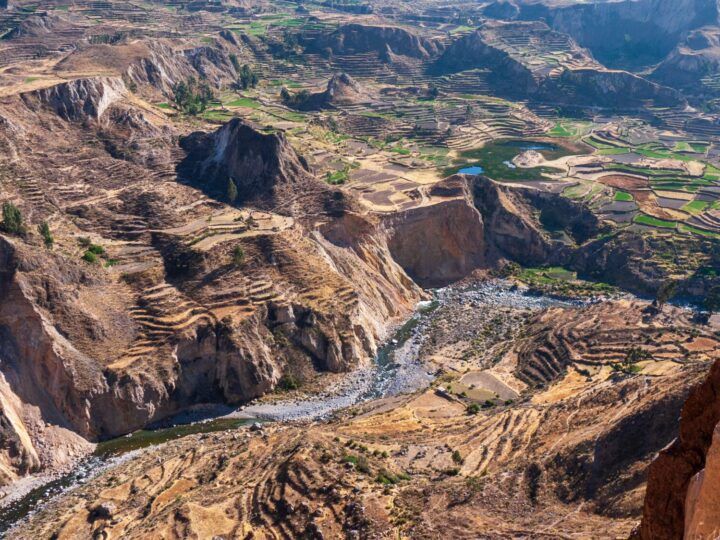
Here’s how to hike Peru’s spectacular Colca Canyon.
Click to navigate this article:
Preparing to hike the Colca Canyon
Before we begin, it’s worth understanding a little more about treks in the Colca Canyon. While the going here is tough, it’s very rewarding, although you’ll definitely want to be prepared before you leave.
1. How long does it take to visit the Colca Canyon?
It really depends on how much time you have and how you’d like to explore the canyon. Most travellers choose to do the two-day Colca Canyon hike – one night in the oasis – which involves an early morning bus from Arequipa on day one. Alternatively, the three-day/two-night trek gives you a chance to explore more of the canyon’s epic scenery.
With that said, you can also do the one-day hike without an overnight stay in the oasis. This option is, of course, one of the most challenging as you don’t have much time to rest and day tours start at 4am from Arequipa.
For inexperienced and beginner hikers, we recommend signing up with a Colca Canyon private tour if a one-day trip is what you prefer.
A private guide will arrange your transport and meals and ensure you don’t get behind schedule and drop you back at your accommodation in Arequipa at the end of a long but .
Planning Your Trip to Peru?
Save time, stress & money with a customized travel itinerary planned for you by a Peru expert
What previous clients have said:
Going to a new and exciting place is an adventure AND has its challenges. Being able to carve out an in-depth plan with someone that has been there and whom you can trust was extremely helpful. We felt comfortable embarking on a six-week backpacking trip with kids ages 8 and 11 with Steph on our team. Her expertise and ability to hear what we wanted gave us a great jumping point for planning. Her advice and wide array of options also allowed us to be flexible. It also gave us peace of mind knowing that we had someone we could call if our plans went awry. Every one of Steph’s recommendations panned out to be incredible pieces of our trips and we would highly recommend her!
2. Where does the trek into the Colca Canyon start?
The Colca Canyon trek does not have a specific starting point, as there are a variety of different routes and trailheads, depending on how far you wish to hike (see our Colca Canyon map above for more details).
However, the common starting points are located in Cabanaconde. The most popular one is located north of Plaza de Armas , which leads straight to Sangalle.
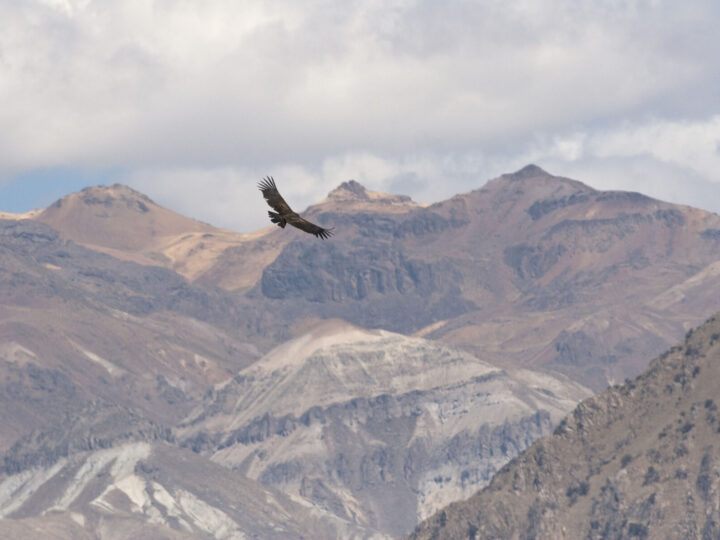
Another starting point in Cabanaconde is located west of the Plaza de Armas. This one leads to Llahuar, through the western loop of the oasis. The other starting point, Mirador de San Miguel, is located a 30-minute walk from the town.
3. When is the best time to do the Colca Canyon trek?
April and May are the best months to visit the Colca Canyon as the valley turns green following the seasonal rains but the mountains are still capped with snow.
That said, the Colca Canyon weather is generally warm and dry all year long – except for January through March when it rains almost every day. Because of the elevation, nights can be cold, especially if it’s been cloudy during the day.
Low pollution levels in the desert region mean a clear night sky. If you can time your trip, visit during the new moon in April or May. The views at night are majestic!
To know more about Peru and its weather conditions, read our guide on the best time to visit Peru next.
4. How fit do I need to be?
Overall, the Colca Canyon trek is challenging, whichever path you choose. Even though the hike down may be easy, you still need to hike your way out of the canyon, and, with Sangalle sitting at 2,100 metres of elevation and Cabanaconde at 3,300 metres, you’re facing the effects of altitude, too.
Another thing to consider is that it’s a high desert region where the sun is pretty intense, and there are not many trees to offer shade. Moreover, the paths are mostly dusty with small, loose rocks, which is physically demanding.
You don’t need to be super fit to do the Colca Canyon hike. But it’s definitely not for a first-timer or anyone with mobility issues. Since there’s no place to spend the nights other than in Cabanaconde or in the villages within the canyon, once you start your hike, there’s no stopping. So, good cardio, strong legs, and a sense of determination are a must.
5. How much does it cost to hike in the Colca Canyon?
If you travel on your own and without taking an organised Colca Canyon tour, the hike itself is free. All you need to budget for is transport, food, and accommodation.
On a non-guided three-day/two-night hike, you can exect to spend around $150 USD for two people in a double room. This cost includes a private room (one night each in Llahuar and Sangalle), colectivo fares from and to Arequipa, plus meals at the lodgings.
Signing up with tours may cost less as they put you up in dorm accommodation, while prices of Colca Canyon private tours vary – from $30 USD to $100 USD per person per day – depending on what the operator provides.
6. Do I need to take a tour or can I hike the Colca Canyon treks alone?
Not necessarily. With our Colca Canyon map, you can choose the route you like and hike without a tour or a guide. Besides, the locals are helpful when you ask them for directions. With that said, joining one helps avoid any unpleasant surprises such as missing the last bus!
Colca Canyon tour options
The most common options to trek the Colca Canyon are one-day, two-day, and three-day/two-nights trips. The Colca Canyon day trip will take you straight to Sangalle in the oasis, where you can have a short lunch break before going back up to Cabanaconde. If this is what you prefer, it’s best to have a guide with you.
With a guide, you’ll stay on track, which is important to make sure you get back safely and on time. Besides, you’ll have everything prearranged for you in the oasis.
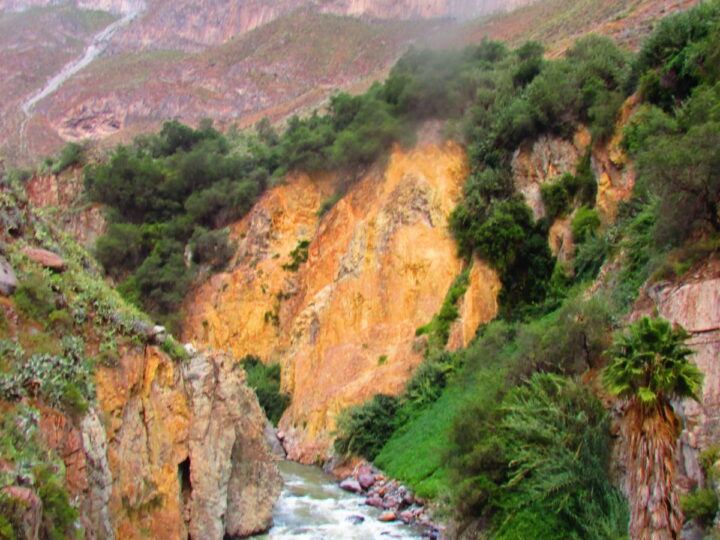
Remember that Sangalle is not really a town as such, more of a spot to rest in the oasis. Even though it’s often visited by tourists, there are no restaurants or shops with walk-in services. Instead, you tend to request and eat all of your meals at your accommodation, so if you’re hiking for just the day, you might struggle to find somewhere to eat.
Paying for a guided tour is a good choice if you’re on a day trip as your meal will be ready, made according to your preferences!
Colca Canyon packing list
The weather in the Colca Canyon makes it a little tricky when it comes to what to pack and what to wear.
Though the temperature in the oasis stays around 15 o C (59 o F) during the day, it’s pretty hot in Cabanaconde, especially when you hike under the sun. So, wear something you can sweat in, but bring a jacket or an extra layer in case the sun decides to hide behind the cloud.
- Sunblock and a hat. The sun can be pretty intense even at seven o’clock in the morning! Put on sunblock before your hike and keep your head protected under a wide-brimmed hat.
- Insect repellent. Especially in the oasis, there will be insects wherever you go. Protect yourself with insect repellent that lasts a long time, so you don’t have to constantly stop to re-apply. Something like Sawyer’s insect repellent is great; put it on right before your hike, and it will protect you for up to eight hours.
- A trekking pole. Hiking down thousands of metres of the Colca Canyon elevation towards the oasis can be challenging. A trekking pole (or even a pair of them) helps prevent you from losing your balance and slipping down.
- A raincoat. Even if it’s not the rainy season (December through March), there’s still a chance of drizzle. We recommend Patagonia’s Storm 10 (find it on Backcountry | Patagonia | Amazon ), a lightweight, highly waterproof, and durable raincoat, or the North Face Alta Vista Jacket ( Amazon | REI ), which is significantly cheaper but offers good weather protection.
- One litre of water for every three hours of your hike (and more for the climb!). Having a sip of water every now and then during your trek is vital. The intense sun combined with the dryness of the high desert region means more effort is required to stay hydrated. Note that you cannot drink the tap water in the Colca Canyon and the water in the river is likely contaminated by mining waste. The only chance you’ll have to restock is to buy bottled water at your lodging or small shops you’ll find in the villages.
- Snacks. Some parts of the trek, especially between Cabanaconde and Llahuar, have no shops in between. To stop you running on empty, pack protein bars, energy drinks, and other types of sustenance that help curb your hunger while providing you extra energy.
- Warm clothes. Even though it’s not winter, nights in the oasis can get below freezing. Pack a jacket and nice warm socks to help you sleep better. You’ll need your zs before a challenging hike the next day!
Colca Canyon hiking routes
Now you’re fully prepared for the trek, it’s time to plan your route. When it comes to choosing your Colca Canyon hiking route, you’ve got a wealth of options.
Typically, you can opt to hike one route into the canyon (to one of the three settlements in the oasis at the bottom) and return the same way, or hike a full loop into and then around around the canyon (taking a circuit that heads east or west).
To help you decide, we’ve focused on three routes which differ according to their difficulty, the majesty of their scenery and the terrain they cross. The durations given are how long we would recommend in order for you to hike comfortable and have time to enjoy some relaxation when you arrive at the oasis towns for the evening.
And if you’re feeling like you need an extra day of rest before embarking on the steep climb out, you can always extend any one of these routes by including an additional night staying at the oasis.
Please note, hiking times have been calculated based on being fit, healthy and having experience of hiking, and they don’t include rest or stop times, so be sure to build these into your hiking plans.
Colca Canyon route maps
To help you understand the different routes, each has been marked onto this map.
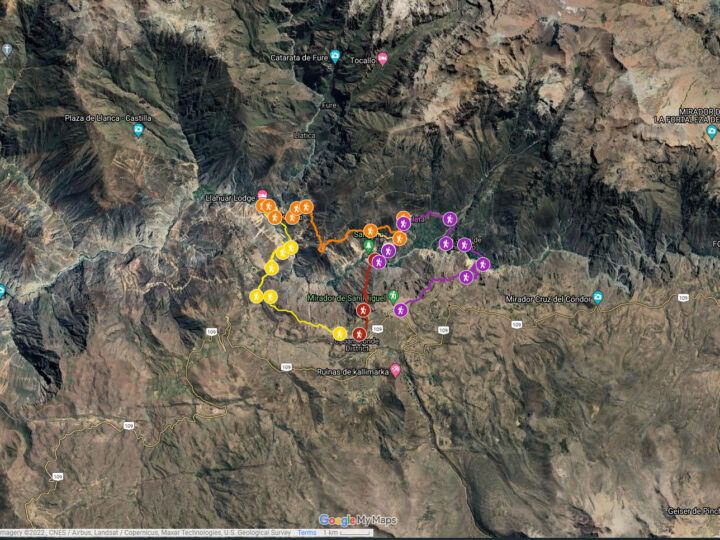
These include the following:
- Red: Cabanaconde – Sangalle – Cabanaconde (one day; 9.2 kilometres; challenging)
- Purple and red: Cabanaconde – San Juan de Chuccho – Sangalle – Cabanaconde (or viceversa) (two days; 17 kilometres; challenging)
- Yellow, orange and red: Cabanaconde – Llahuar – Sangalle – Cabanaconde (or viceversa) (three days; 29.6 kilometres; very challenging).
One-day hike: Cabanaconde – Sangalle – Cabanaconde (Red)
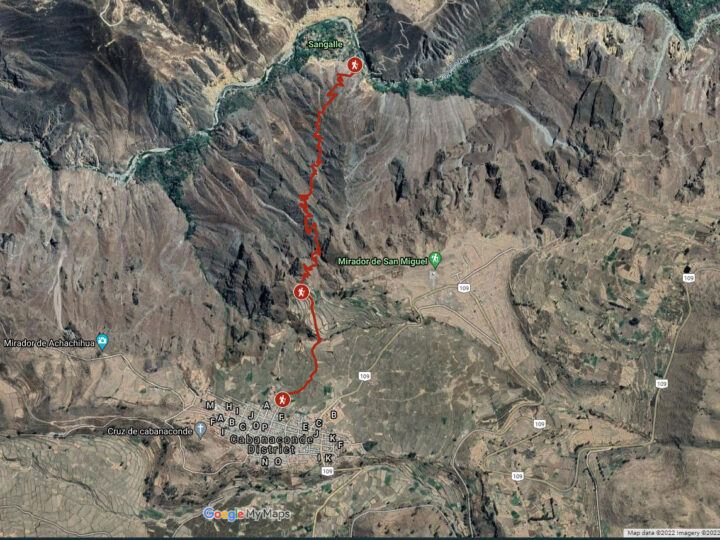
- Duration: 9.2 kilometres (5.7 miles); 7 hours
- Difficulty: Challenging
- Starting point: Cabanaconde (north of Plaza de Armas at the end of GrauStreet. From there, follow the arrows through the local farmland)
- Ending point: The same as the starting point
Only have one day to do the Colca Canyon trek? This is the route for you. The most popular path as it leads directly down into the oasis, it follows an extremely steep and rocky, 4.6-kilometre descent into the depths of the canyon. You’ll need three hours to go down and four hours to hike the same route back out.
To avoid the crowds – and give yourself plenty of time to complete the trek – take the earliest colectivo (at 4am) from Arequipa. You’ll arrive around 8am-9am in Cabanaconde. A better option is to spend the night before in Cabanaconde, which will allow you to start earlier and reach the cool waters of the oasis sooner – giving you more time to relax in Sangalle.
For that, La Casa de Santiago – located right at the trailhead – is an excellent choice of accommodation.
If you’re worried about fitness levels or time and can’t face the hike, there is another option: riding a mule to go back out to Cabanaconde! Rent one for around S/70 (around $17 USD), and, as it leaves Sangalle at five in the morning, you’ll need to arrange the ride with your lodging host the previous day.
Note that it’s still a challenging ride up and out of Colca Canyon, so we don’t recommend it if you’ve never tried non-guided horseback riding before.
Two days and one night: Cabanaconde – San Juan de Chuccho – Sangalle – Cabanaconde (or viceversa)
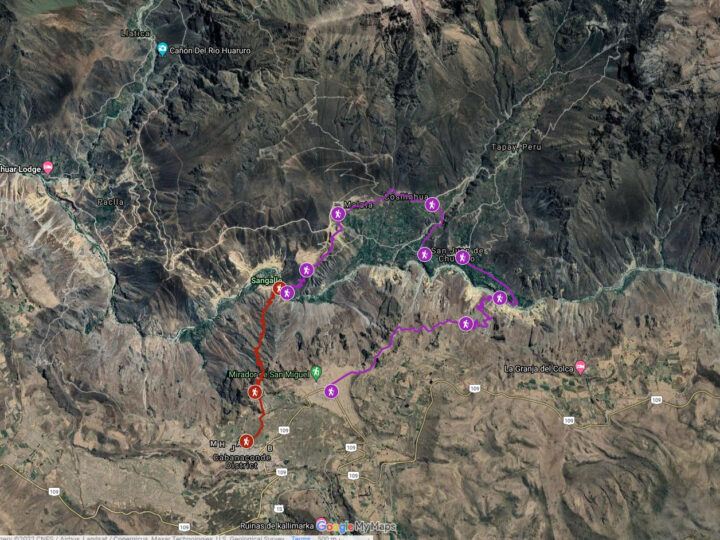
- Duration: 17 kilometres (10.5 miles); two days
- Starting point: Mirador de San Miguel or (30 minutes walking distance from Cabanaconde)
- Ending point: Cabanaconde (north of Plaza de Armas)
Day one: Cabanaconde – San Juan de Chuccho – Sangalle (Purple); 12.5 kilometres (7.8 miles); 7 hours
This loop takes you out east to explore the a more remote part of the canyon compared to the one-day hike itinerary above.
Though it takes more time and effort to get to the oasis, it’s more enjoyable as the views of the canyon are magnificent and you’ve got more time to appreciate them rather spending the entire time watching your footing as you descend.
Day one is the most demanding on this two-day Colca Canyon hike. Unlike the other two routes, the starting point is located around two kilometres outside of Cabanaconde. From there, it’s a winding, seven-kilometre, five-hour path down towards San Juan de Chuccho, a cluster of houses nestled into the canyon’s eastern flank.
Stop here for lunch at one of its small restaurants – although many remain closed due to the pandemic, so bringing a packed lunch is a sensible idea – before continuing your journey to Sangalle.
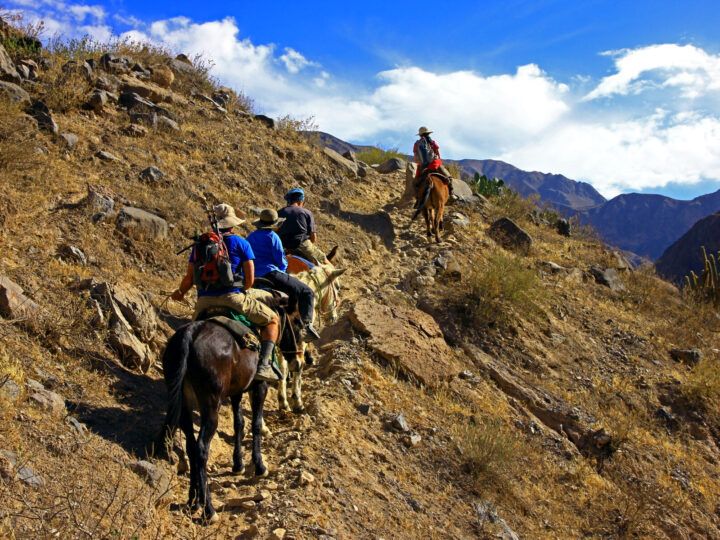
After lunch, it’s a two-hour, 5.5-kilometre trek to reach Sangalle. While Google Maps shows an alternative route across the floor of the canyon straight from San Juan de Chuccho to Sangalle, we didn’t see any visible, safe path.
Instead, it’s best to climb out of the canyon following the marked route through Cosñinhua and Malata, skirt the edge through the two towns, and finally down to Sangalle.
Where to stay: There are four lodging options in Sangalle. With lovely grounds and excellent service, Oasis Paraiso Ecolodge ($40 USD double with private bathroom) is the pick of the bunch.
Day two: Sangalle – Cabanaconde (Red); 4.6 kilometres (2.8 miles); 4 hours
Leave Sangalle early (5 a.m.) to avoid the heat from the sun – and to be back in time to take the bus to Arequipa – as you take on the steep and rocky path out of the canyon. If hiring a mule for the way out, you’ll be starting at this time, too.
Three days and two nights: Cabanaconde – Llahuar – Sangalle – Cabanaconde (or viceversa)
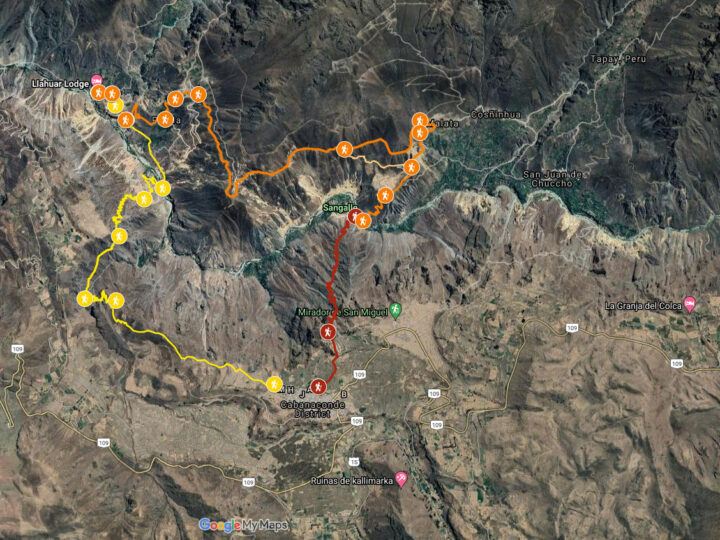
- Duration: 29.6 kilometres (18.4 miles); three days
- Difficulty: Very challenging
- Starting point: Cabanaconde (west of Plaza de Armas). Follow Calle Bolivar west away from the Plaza de Armas in Cabanaconde to its conclusion; you’ll see a bull arena (marked as Plaza de Toros) at the beginning of the path.
This route is our favourite for exploring the Colca Canyon as it takes you around both sides of the gorge, down into one oasis village – Llahuar – and into another – Sangalle – therefore allowing you to see this dramatic canyon from all angles.
Day one: Cabanaconde – Llahuar (Yellow); 12 kilometres (7.5 miles); 5 hours
Start your hike at first light from Cabanaconde. The path will take you through local farmlands towards the edge of the southern side of the canyon. This hike starts gently, giving you the option to admire and take photos of the northern side of the canyon from afar.
After about 30 minutes on this path, you’ll reach your first descent into the canyon. A rocky path descends to a small wooden bridge that connects the southern and the western sides of the canyon. On the other side of the bridge is a flatter, easier route skirting the edge of the trek’s westernmost part. The views during this part of the hike are fantastic!
After skirting the edge of the canyon, you’ll reach the most challenging part of day one: another descent to the oasis on a steep, rocky trail. When on this path, please pay attention to each step on the loose rocks, especially on the steepest parts.
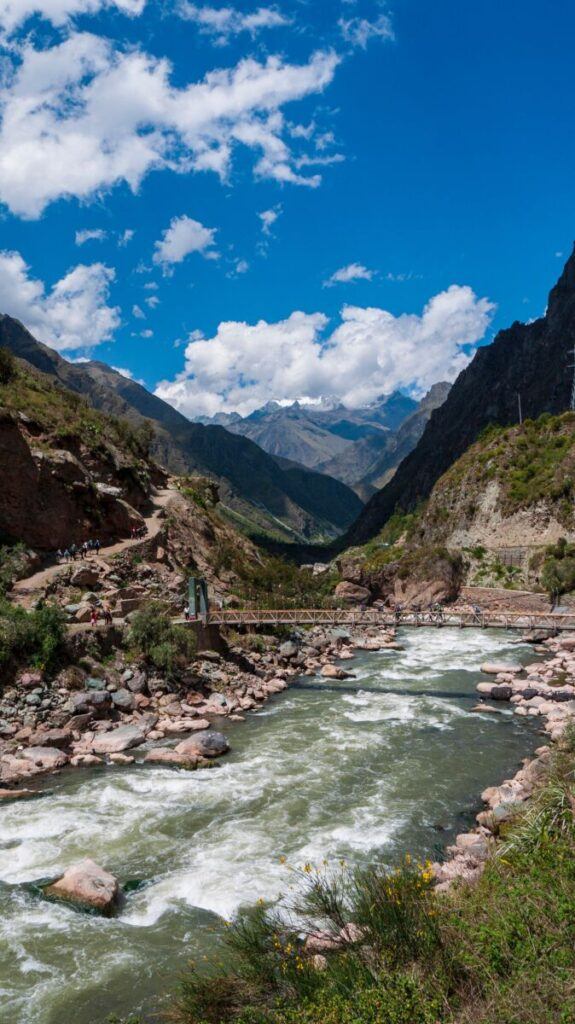
This one-hour-long zig-zag path meets a big road in the end. Follow the road down towards a big bridge that crosses Rio Colca. From there, it’s a bit of a walk uphill until you find an intersection that splits the road into two options: one to Tapay and another to Llahuar. Take the latter to get to a path down – another zig-zaggy one – towards the last bridge you need to cross to get to the hamlet of Llahuar.
Where to stay: There are a couple of lodging options in Llahuar. We stayed in a private room with a shared bathroom at Casa de Virginia ($20 USD double). Breakfast by the river is included. Deliciously hot thermal pools are available for guests to soak their tired legs under the stars.
Day two: Llahuar – Sangalle (Orange); 13 kilometres (8 miles); 5 hours
If you’re a beginner trekker, or a slow walker, leave Llahuar as early as possible on day two, as you’ll be hiking a long distance as you move from one part of the canyon to another. First, return to the intersection you descended to reach Llahuar yesterday, but instead take the lefthand road towards Tapay.
This road skirts the hillside until you arrive in a village called Paclla, where you’ll find a small pathway up the hill heading north out of the village.
If you’re not sure which pathway to take, you can ask for directions to Belen. Note that the locals may direct you to the main road, but we don’t recommend this as the road is too long and not meant for pedestrians. The pathway is more steep and challenging, but it’s significantly shorter than the road.
It’s a steep climb for about an hour until you reach Belen. From here, follow the main road heading southwest out of the village, which follows the edges of the canyon for a number of miles until you see a descending path towards Sangalle.
There are two ways to descend to Sangalle: the first point you’ll encounter – marked with a road sign – is shorter but can be dangerous, especially for tired legs; locals actually stopped us from going down this path. Instead, continue along the road and descend into the village of Malata.
From there, just follow the trail down past a reservoir, across farmland, and finally down a steep, winding path to Sangalle; you’ll find a road sign marking the start of this final descent.
Day three: Sangalle – Cabanaconde (Red)
Leave Sangalle early (5 a.m.) to avoid the heat from the sun – and to be back in time to take the bus to Arequipa – as you take on the steep and rocky path out of the canyon, which should take around four hours. If hiring a mule for the way out, you’ll be starting at this time, too.
Transportation and logistics
Located 220 kilometres away from Arequipa, the Colca Canyon is served by a decent array of public transport. That said, regardless of the route you take, you need to begin your hike early in the day, planning your route to the trailhead (and back to Arequipa) is essential.
Transportation to Cabanaconde from Arequipa
To get to any starting point for hiking into the Colca Canyon from Arequipa, you have three options: on a bus straight to Cabanaconde, on a colectivo (a van) to Chivay (a town 1.5 hours away from Cabanaconde), or signing up with a Colca Canyon tour.
The latter is the most expensive, but they will arrange everything for you, including transport from and to Arequipa. Some even provide a private guide to accompany you on the trek as well – although we don’t believe this to be a necessary expense, as the trail is easy to follow (download Maps.Me and the map for the region before you leave, however, so you have a map and GPS for the duration of your hike).
The bus (S/25 or $6.13 USD) takes six to seven hours from Arequipa’s bus terminal (Terminal Terrestre de Arequipa) to Cabanaconde and can take longer as it stops at every town in between.
Since the pandemic, there’s currently only one company operating the Arequipa-Cabanaconde route: Andalucia. They leave 3 times a day. 1am, 3:30am and 1pm and charge S/25 or $6/50.
An alternative is to take a colectivo (S/20 or $5 USD), which is faster and have a greater frequency, with one leaving every one to 1.5 hours.
Since Covid, there’s only one operator for colectivo : Caminos del Inca . The earliest van leaves at 4 a.m. and the latest at 1 p.m., with one leaving every one to 1.5 hours in between. Though when there’s high demand, they may add more schedules up to 3 p.m. Keep in mind that the colectivo only reaches Chivay. From here, you need to take another colectivo (S/10 or $2.45 USD) to Cabanaconde. The van leaves Chivay at 9am. If you miss it or prefer a more convenient way, taxis are available from Chivay that will take you to Cabanaconde for S/80-100 (around $19-25 USD).
Note that at the time of update, Oct 2023, there has been a fatal accident involving this colectivo operator. We recommend that when you arrive in Arequipa you do some reasearch before booking with a colectivo operator.
If you’re planning to start your hike from the Mirador de San Miguel, ask the colectivo or bus to let you off at the stop, which is located on the road before Cabanaconde. This will save you an hour of walking time.
The transport timetables are below:
Transportation from Cabanaconde to Arequipa
Unless you sign up with Colca Canyon tours, getting back can involve more effort than getting to the Colca Canyon from Arequipa. Basically, you need to take the same transportation to get to the Colca Canyon: on a colectivo from Cabanaconde to Chivay and another colectivo from Chivay to Arequipa, or a bus straight from Cabanaconde to Arequipa (which also stops in Chivay).
Read our Transportation from Arequipa to Cabanaconde section above for more details.
This trip is more challenging because due to the limited number of vehicles operating, you may have to wait up to several hours to get a seat.
And you can’t book the colectivo in advance. If you’d like everything set before your trip, book your seat with the Andalucia bus operator that leaves at 1 p.m. from Cabanaconde. Whichever means of transport you choose, you can access it from the Plaza de Armas.
Looking to do some other hiking while you’re in South America? Don’t miss our guide to hiking the Inca Trail , our article on the 21 best hikes in Peru , or this round-up of the 11 best South America hikes .
Monday 10th of July 2023
Great read. Do you recommend booking a 3D/2N tour online or would it be cheaper/ possible to book the day before in person in Arequipa? Thanks!
Steph Dyson
Wednesday 20th of September 2023
Hi Alana, booking online isn't necessarily more expensive - and it guarantees that the tour is running when you want to do it! Steph

Colca Canyon Trek: Routes, Trail Info, and Tips

Colca Canyon ( Cañon del Colca in Spanish) is the world’s second deepest canyon, famous for its beautiful terraced hillsides and flying condors . But you have only half-experienced the highlights of this region in Peru if you don’t plan a Colca Canyon trek.
The trails in Colca may not pass as many stone ruins as the Inca Trail to Machu Picchu, but the region makes up for it with stunning scenery and natural hot springs. In general, the further you walk, the fewer people you’ll share the trails within and around Colca Canyon.
Choose your base in Cabanaconde, a town on the canyon rim, and depart on one of the trails leading down into Colca Canyon. Alternatively, the town of Chivay in the upper Colca Valley is a convenient spot to plan day hikes to Andean villages surrounded by terraced hillsides.
Treks in Colca Canyon Day Hikes (in Colca Valley) Trail Information Colca Canyon Tour Vs Colca Canyon Trek Tips for Trekking Without a Guide Packing Essentials Start Planning
Treks in Colca Canyon
The town of Cabanaconde is only 8 mi (13 km) past the iconic Colca Canyon condor viewing platform, or Mirador Cruz del Condor , and a must-visit spot for trekkers. In Cabanaconde, you can take walking trails that connect villages and natural attractions in Colca Canyon.
Colca Canyon is not just one defined trekking loop or path , unlike other treks in Peru . The map below indicates popular trail routes (in black) connecting villages within the canyon. There are several treks to choose from, and below are a few two and three-day options. Longer routes take you to further spots such as Huaruro waterfall and Tapay village.
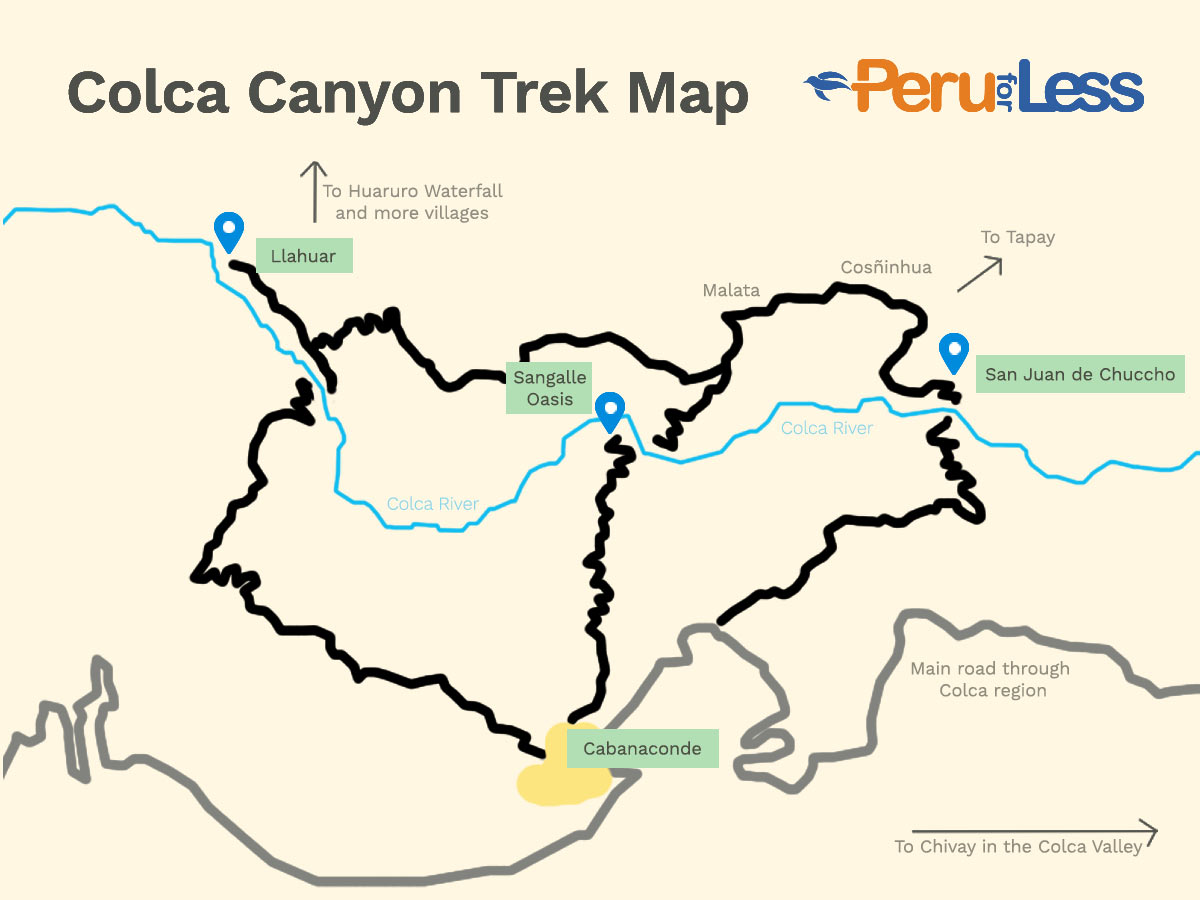
Colca Canyon Trek Map by Peru For Less
Colca Canyon Trek 2 Days: Short and Sweet
Recommended if you are short on time but would still like to trek into the canyon
Route: Cabanaconde > Sangalle Oasis > Cabanaconde Overnight: Sangalle Distance: about 5 mi (8 km) roundtrip
The well-trodden trail to the oasis known as Sangalle is a very popular Colca Canyon 2 day trek. Basic bungalows, campgrounds, and even pools for swimming make Sangalle a comfortable and popular village to spend the night. Plus, if you are trekking without a guide, there are places to buy cooked meals and extra water.
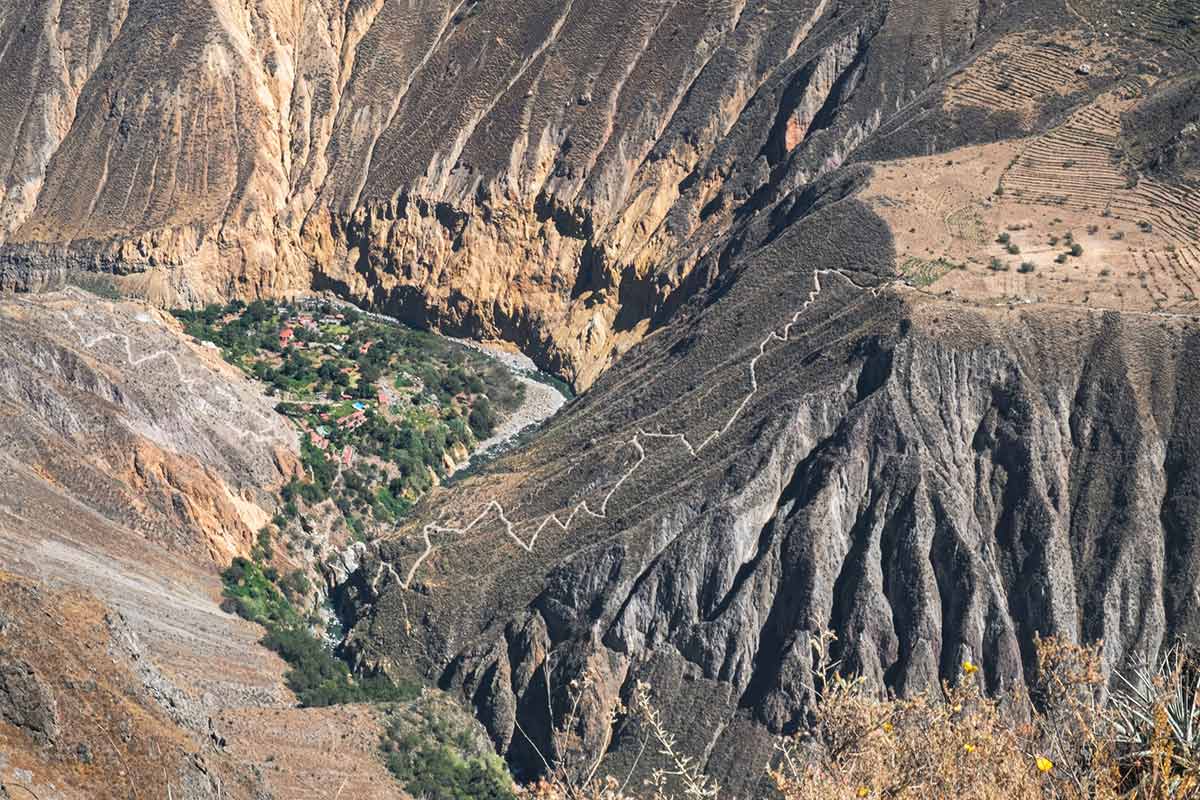
Escape to the canyon oasis of Sangalle. Photo by Sander Lenaerts on Unsplash .
Reaching the oasis takes about two hours descending on foot while ascending the steep trail back to the canyon rim can take anywhere from two to three hours (or more depending on your level of fitness and acclimation).
The down-and-up loop into the canyon from Cabanaconde is usually split up with a night in Sangalle, but it’s possible to do it in one day. However, there is a good chance you’ll remember more about being exhausted than being amazed by the canyon scenery if you do it in only one day.
Arequipa Tours:
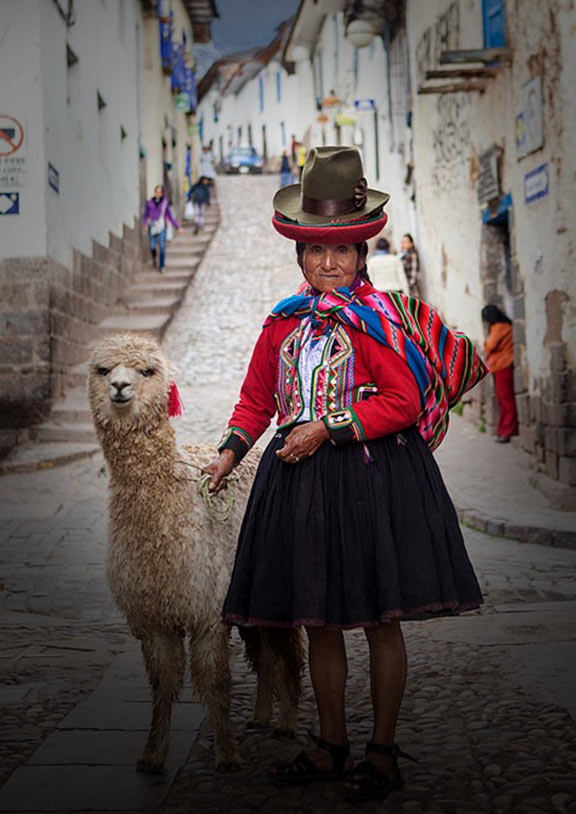
Colca Canyon Trek 3 Days: Popular Route
Recommended for an extended stay in Colca Canyon
Route: Cabanaconde > San Juan de Chuccho > Sangalle Oasis > Cabanaconde Overnight: San Juan de Chuccho (night 1), Sangalle (night 2) Distance: about 12 mi (20 km) total
Set out on a trekking loop into the eastern part of Colca Canyon and spend the night in the villages of San Juan de Chuccho and Sangalle. Averaging between four to five hours of walking each day, this three-day trip isn’t too strenuous if you walk at a steady pace.
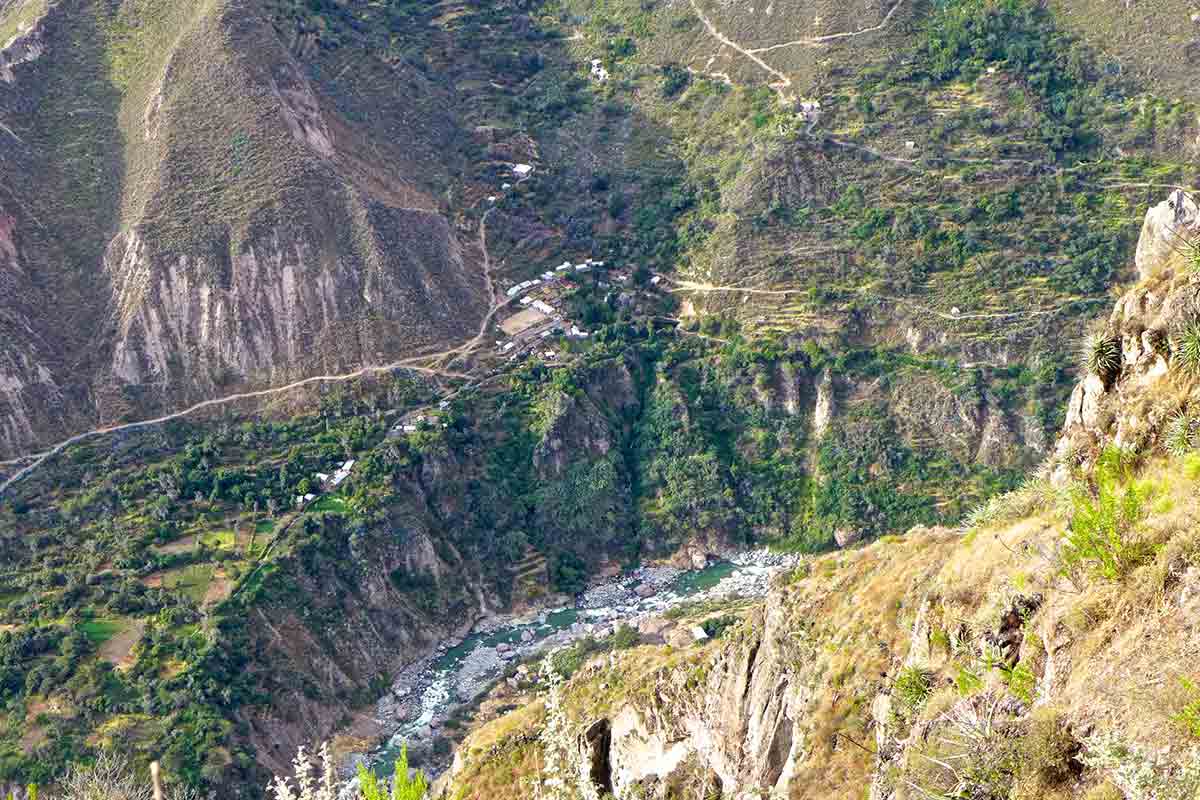
The village San Juan de Chuccho from high across the river. Photo (modified for size) by Monty VanderBilt/Flickr .
From the trailhead, not far outside Cabanaconde, the trail begins fairly even and transitions to switchbacks along the steeper descent to the canyon floor. The small village of San Juan de Chuccho sits along the Colca River and is not accessible by car. Guesthouse accommodations are limited and minimalist, but usually include a bed (dorm or private) and meals.
The next day, continue onwards to Sangalle. Pass through the village of Cosñirhua along the way and buy extra water and snack foods (fruit, chips, etc). The sparse vegetation on the trail transitions to greener vegetation and palm trees the closer you get to the Sangalle oasis for the second night.
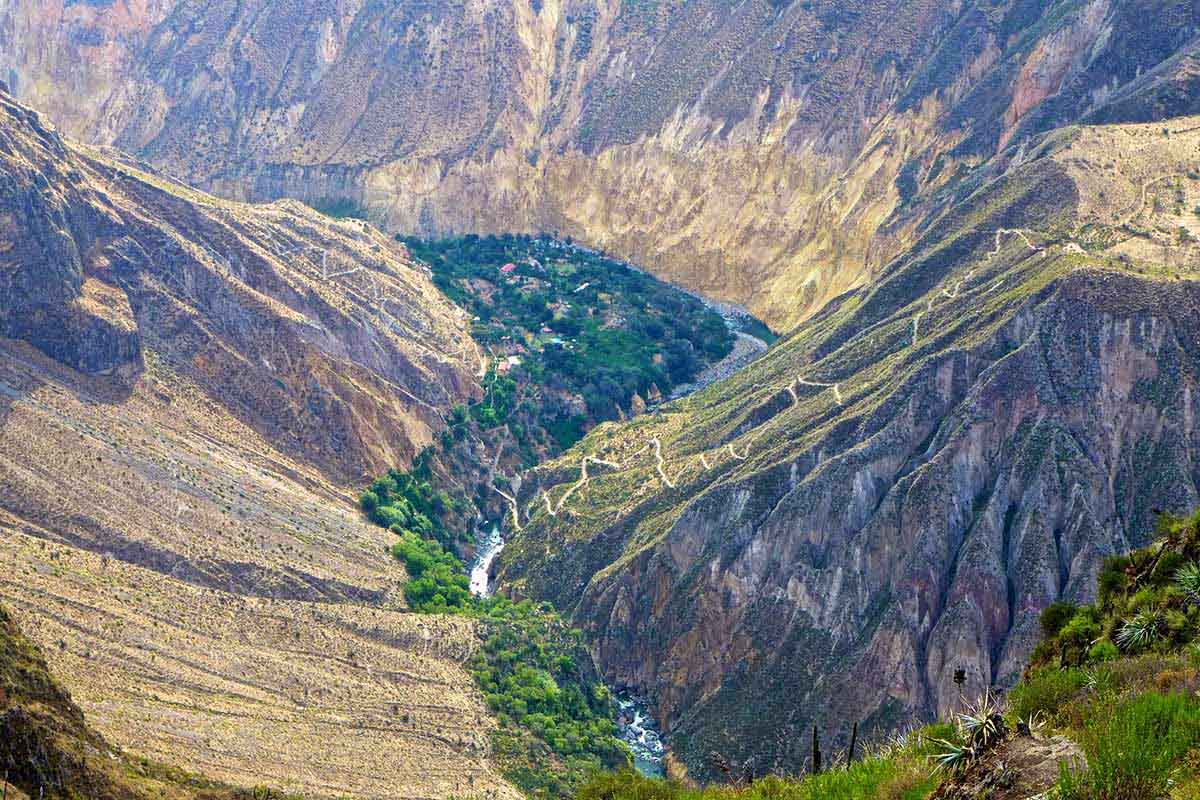
Save your energy for the steep climb out of the canyon on the third and final day of the trek. Mules are available to hire if you need help and are included with some guided tours.
Colca Canyon Trek 3 Days: A Challenge
Recommended if you are in good shape
Route: Cabanaconde > Llahuar > San Juan de Chuccho > Cabanaconde Overnight: Llahuar (night 1), San Juan de Chuccho (night 2) Distance: about 19 mi (30 km)
This trekking loop takes you into the canyon to the village of Llahuar in the west to San Juan de Chuccho in the east. Sangalle is not part of this itinerary, allowing you to bypass the crowds and party-goers that sometimes occupy the oasis.
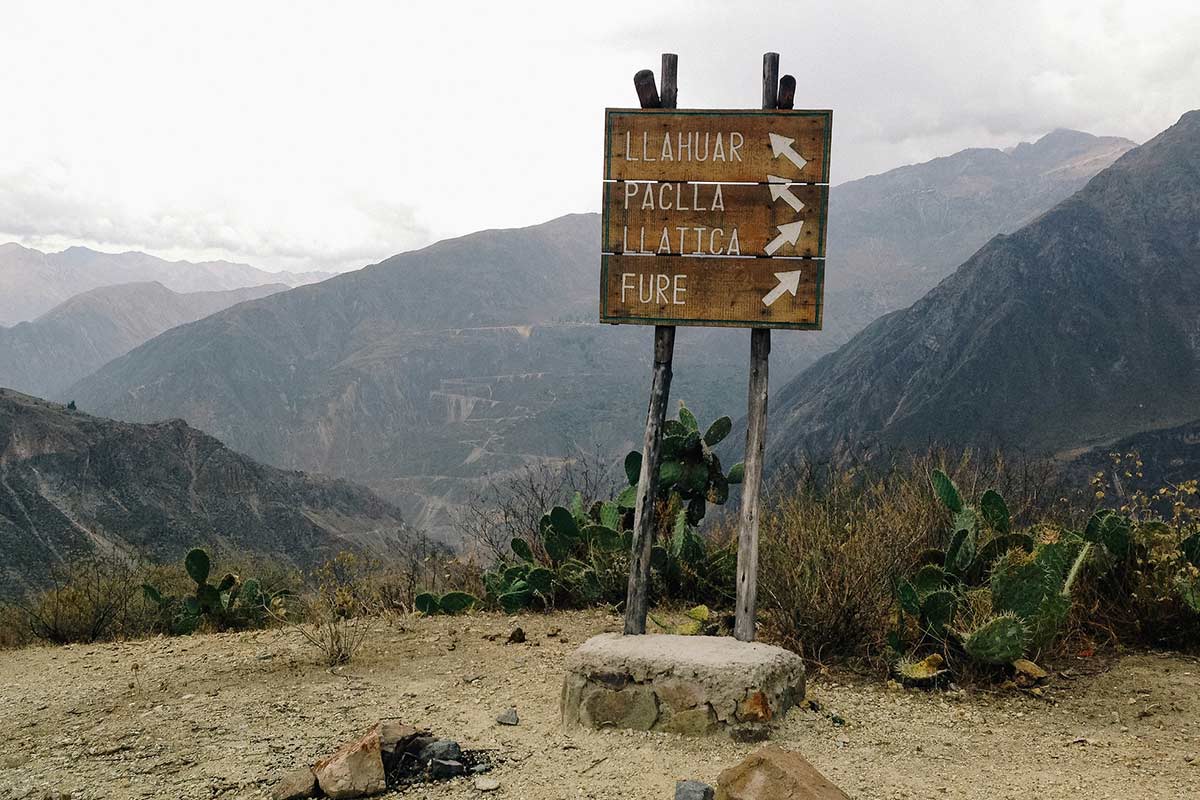
All trails go to beauty in Colca Canyon. Photo by free range jace/Flickr .
All Colca Canyon treks begin with a grueling descent into the canyon floor. The walk from Cabanaconde to the tiny community of Llahuar takes around four to five hours and covers 6.5 mi (10.5 km). Accommodation in Llahuar is limited to only a handful of options. Llahuar Lodge is cozy and offers guests access to three thermal pools down by the river where you can soak sore muscles. From Llahuar, you can visit Huaruro Waterfall.
On the second day, wake up early and begin with a 2-hour ascent up to Mirador de Apacheta and continue past even more impressive scenery passing through the village of Paclla and onward to San Juan de Chuccho for the night.
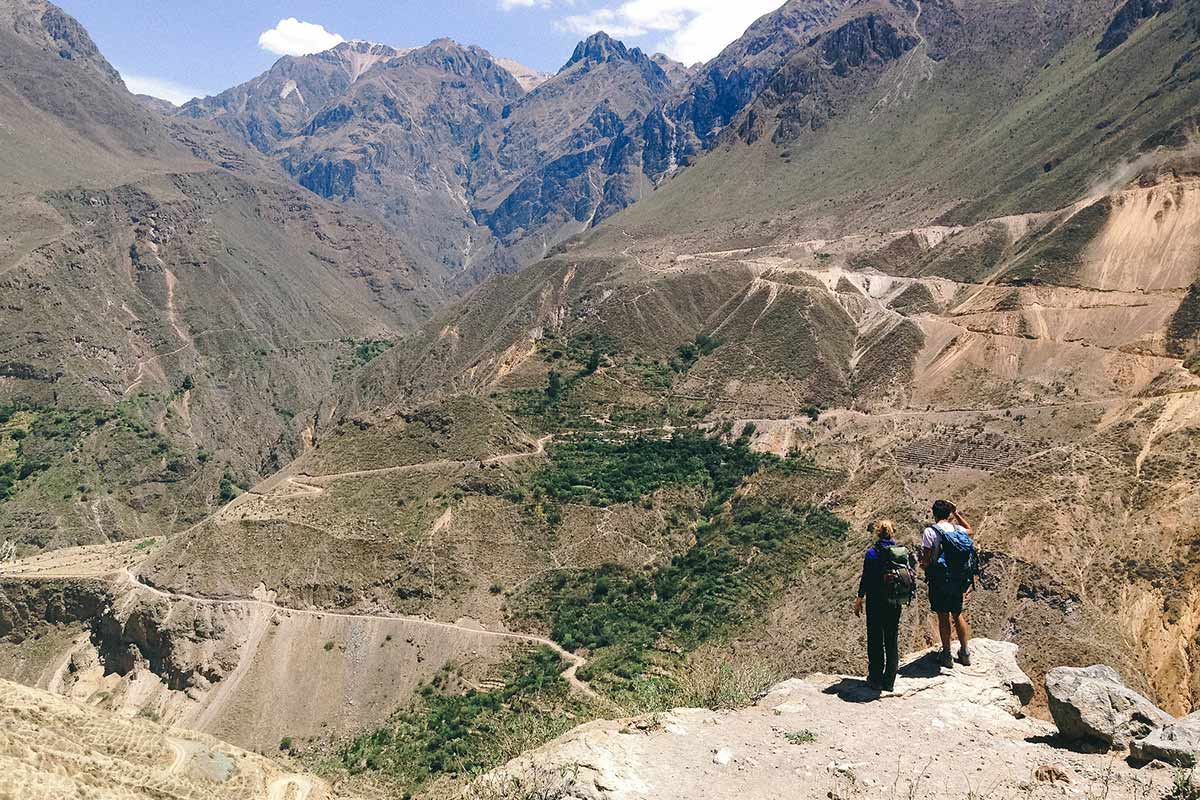
Make sure to enjoy the views along your Colca Canyon trek. Photo by free range jace/Flickr .
The ascent from San Juan de Chuccho out of the canyon to the San Miguel trailhead on the final day is exhausting – this is the second deepest canyon in the world after all! From there, continue about 15 minutes along level terrain back to Cabanaconde.
Day Hikes in Colca Valley
The town of Chivay is the main transit point for travelers in Colca Valley. Chivay is also easily accessible from Arequipa and a logical base for hikers. Trail options are varied and can suit any level, provided you’re already well acclimatized to the elevation.
If arriving late in the day, save your energy for a longer hike the following morning and enjoy a short 2-mi (3-km) walk to the town’s well-known La Calera hot springs. Entrance is 15 soles and you can bathe in one of the thermal pools ranging from warm to unbearably hot.
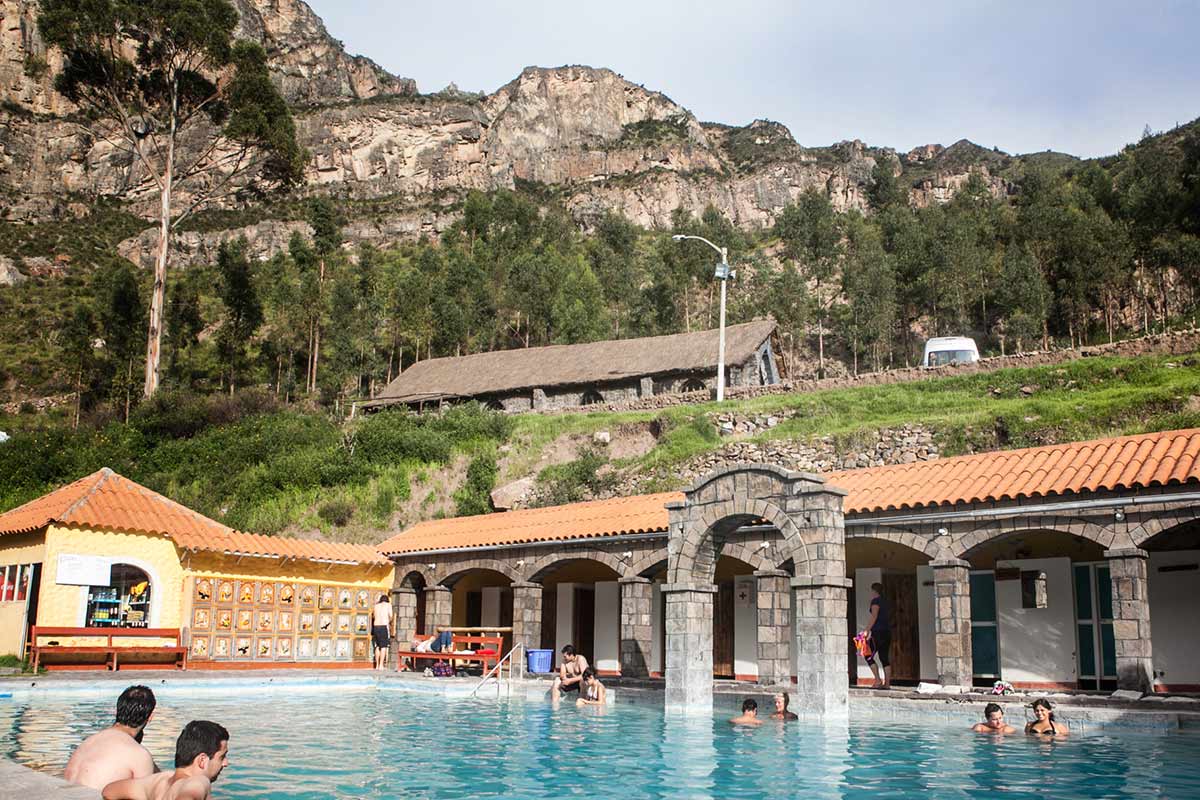
Rejuvenate with a dip in the thermal pools of La Calera. Original photo by Peru For Less.
Set up base in a hotel or hostel in Chivay offering basic services – hot water, cable TV, and breakfast. Alternatively, reserve a room at a top-ranked Colca Canyon hotel a short distance outside of town for a more memorable stay. Chivay has a healthy scattering of restaurants serving a range of food, from quick snacks to full hearty meals of local specialties, which will set you up well for a day or two of hard hiking.
Village-to-Village Hike
Set out on a self-guided hike after breakfast and enjoy a 4.5 mi (7 km) walk from Chivay to the attractive village of Coporaque . Begin by strolling out of town along the road to La Calera, but cut left (along Av. Polonia) and cross Puente Inca (Inca Bridge) over the Colca River. Continue along the view-embellished road, passing fertile fields and views of distant snowy peaks to Coporaque. Here, you can visit some small pre-Inca ruins and find a pleasant river-side spot to stop and catch your breath.
Then, rather than retracing the same route back, follow the path downhill about 3 mi (5 km) to the neighboring village of Yanque , around 5 mi (8 km) from Chivay. You can either walk back from here or catch a bus or taxi back to town.
Yanque to Uyo Uyo Ruins Hike
Uyo Uyo is an ancient village built by the Collagua group and later inhabited by the Incas. The remaining stone structures of the archaeological site are set against the natural beauty of the valley. From Yanque, cross the river and continue walking there along a country road. The hike to Uyo Uyo from Yanque Plaza is roughly 6 miles (10 km) roundtrip. Departing from Colca Lodge , it’s a shorter walk to Uyo Uyo and a nice way to spend a free morning or afternoon.
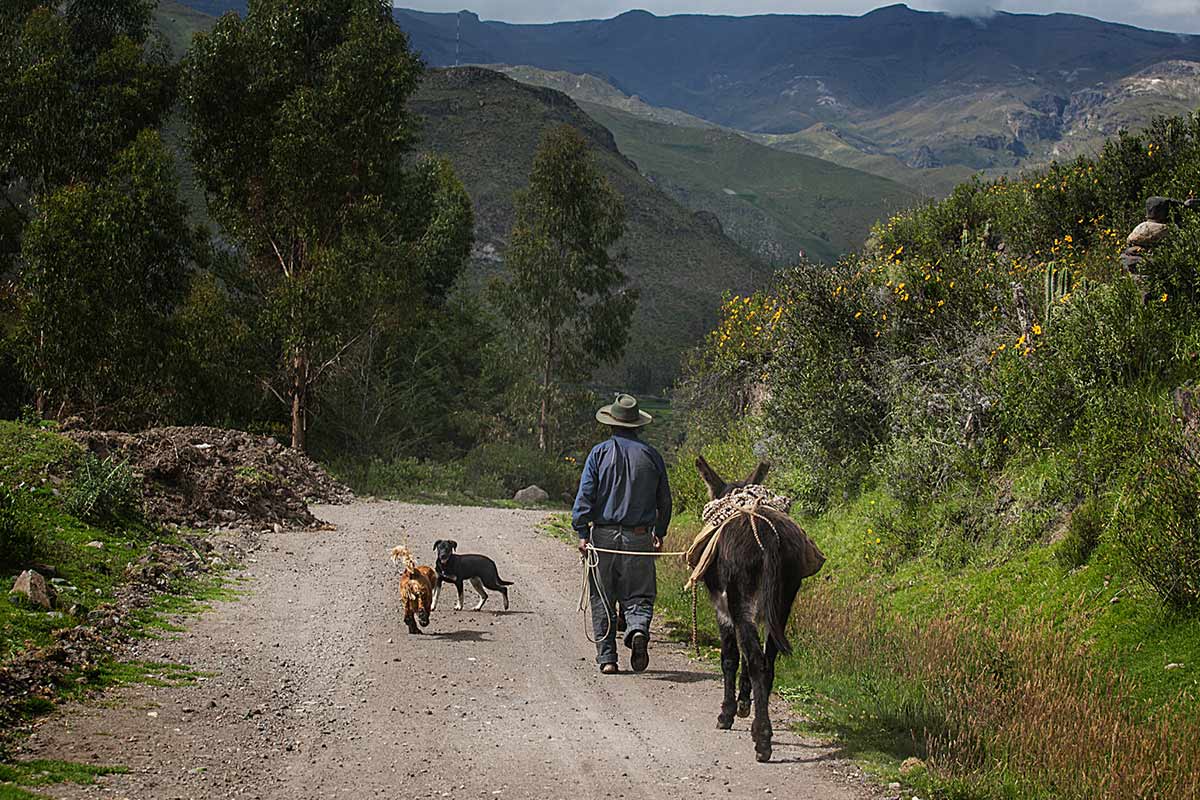
A local goes about life in Colca Canyon. Original photo by Peru For Less.
Traveler Tip: If you prefer, there are also guided short walks around Colca, which are ideal for acclimatization. Contact our experts and ask what options are best suited for your custom itinerary.
Trail Information
Colca canyon elevation.
The entire Colca region is on a high elevation plateau. For this reason, a few days of acclimatization before anything more energetic than a short walk is recommended.
Trekking destinations from Cabanaconde into Colca Canyon are lower in elevation, albeit far above sea level.
Cabanaconde – 10,760 ft (3,280 m) Sangalle Oasis – 7,050 ft (2,150 m) San Juan de Chuccho – 7,280 ft (2,220 m) Llahuar – 6,630 ft (2,020 m)
Hikes in the Colca Valley are at slightly higher elevations:
Chivay – 11,800 ft (3,600 m) Yanque – 11,155 ft (3,400 m)
Colca Canyon is one of the deepest canyons in the world, and the third is nearby Cotahuasi Canyon . The deepest point of Colca Canyon is roughly 13,648 ft (4,160 m) near the Huambo district in Peru’s province of Caylloma. The elevation of Arequipa , Peru is 7,661ft (2,335 m) and some trekkers may prefer to acclimatize there instead of going straight to Colca Canyon.
Colca Canyon Trek Difficulty
Your walking pace and the route you choose to walk through Colca Canyon are among the variables that contribute to the difficulty level. Climbing out of the canyon is steep and made more challenging with the high elevation, leaving even a fit person gasping for air at some point. Sections of the trail are also steep, so be sure to walk to the inside of the trail.
Remember to spend a few days adjusting to the Colca Canyon elevation before your trek and spread your outdoor adventure over a few days if you can. Drink plenty of water, start your days early to beat midday heat, and consider hiring a local to ride their donkey if you’re fatigued.
Colca Canyon Weather
Similar to other high elevation destinations in Peru, Colca Canyon experiences a dry season during winter and a rainy season during the summer. Weather transitions are gradual between seasons.
The dry season is from May to November. Daytime temperatures are around 65°F (18°C) and get hotter in direct sunlight. At night, it dips to a crisp 25°F (4°C) without cloud coverage.
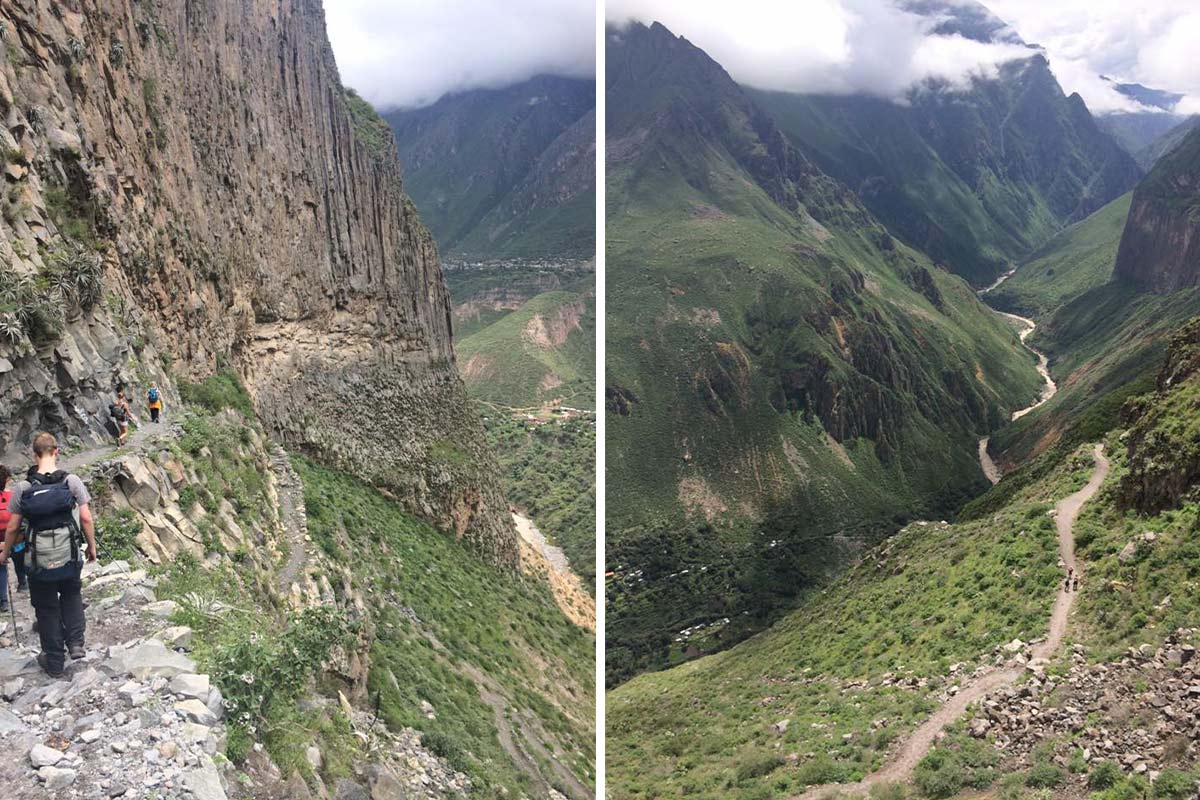
The rainy off-season brings beautiful greenery to Colca Canyon. Photos by Michelle Talsma/ Travel Advisor at Peru For Less.
The wet season is from January to March. The temperature is slightly cooler at around 60°F (16°C) during the day, but nights are typically warmer than dry season months with an average temperature of 45°F (7°C).
Best Time to Trek
The dry season from May to November is the best time for a trek in Colca Canyon. With clear skies and plenty of sunshine, bringing protection from the sun (wide brim hat, glasses, and sunscreen with high SPF) is important at such a high elevation.
However, though the wet season brings muddy trails, the canyon scenery is beautifully green.
Canyon Lodge or Camping
Villages within the canyon are great spots to fill up on water, snacks, and cooked meals. Sangalle, San Juan de Chuccho, Llahuar, and a few other villages host simple lodging that is a great alternative if you prefer not to camp. Additionally, there are numerous campsites to pitch your tent in and around canyon villages and natural attractions.
Colca Canyon Tourist Ticket
Colca Canyon is set within a vast natural park. The entrance costs 70 soles (about $20) for a boleto turistico (tourist ticket).
Colca Canyon Tour Vs Colca Canyon Trek
Typical guided tour.
You can plan a full day Colca Canyon tour from Arequipa, or extend your visit with an overnight at a hotel. Whichever option you choose, popular tour stops in the Colca Valley include La Calera hot springs near Chivay; a visit to the colonial town plaza of Yanque; and admiring the scenic terraced hillsides. Then, tours head west to narrower sections of Colca Canyon as far as Mirador Cruz del Condor to watch soaring Andean condors. From here, tour-goers can glimpse into the canyon depths but don’t venture into Colca Canyon.
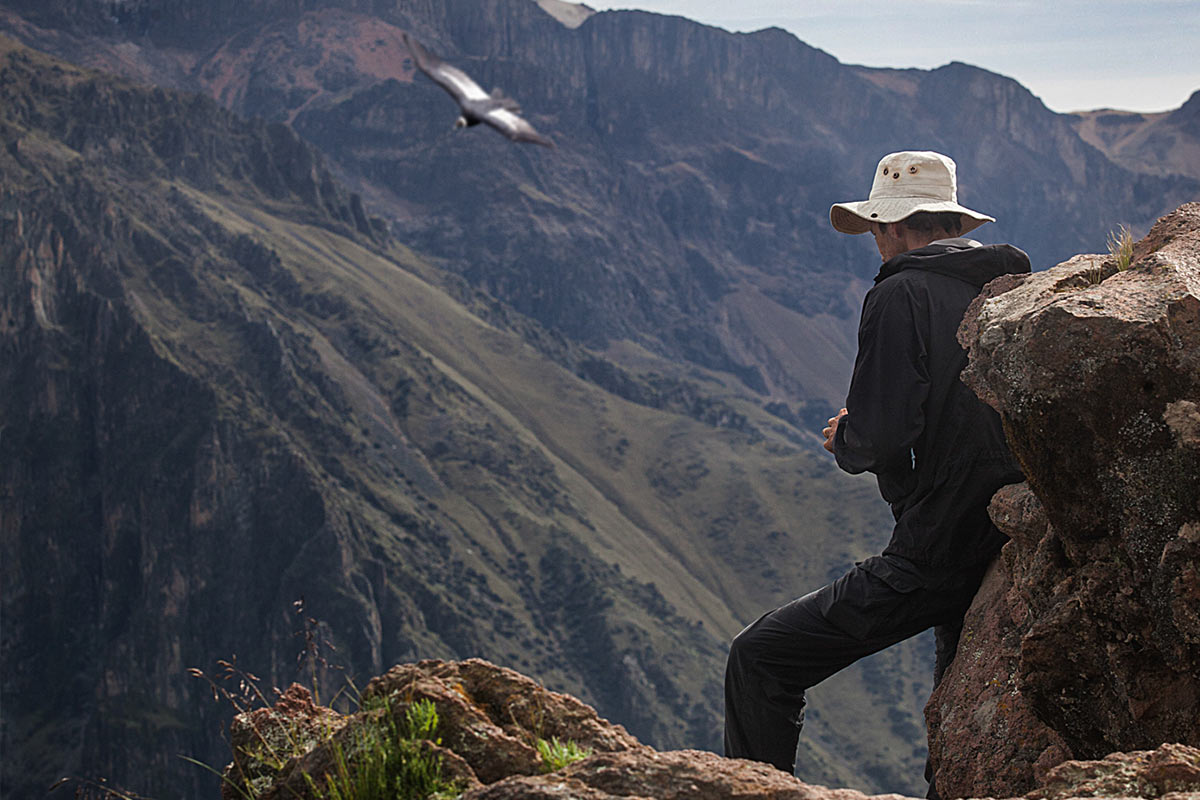
Andean condors are always a highlight of Colca Canyon, trekking or not. Original photo by Peru For Less.
Trekking Highlights
A Colca Canyon trek, on the other hand, is a genuine way to experience the stunning beauty and small rural villages that have endured for centuries within the depths of the canyon. And with some luck, you may also spot Andean condors.
In Peru, it isn’t always convenient or possible to trek independently (such as on the Inca Trail or through the Amazon Rainforest ). Colca Canyon, however, is a wonderful place to venture on foot with the option to go with a guide or on your own. For more planning information, contact our team of experts to include a Colca Canyon trek and other regional attractions into your custom itinerary to Peru.
If you know you are going to Colca Canyon without a guide, then scroll down and read our tips for independent trekkers in the next section.
Tips for Trekking Without a Guide
A self-guided Colca Canyon hike is an adventure and a great option for saving money. The following are a few helpful tips to plan a fun and safe trek into Colca Canyon.
Plan your route. Trekking options from Cabanconde are plentiful and readily available. Purchase a map of the area and plan a Colca Canyon trekking adventure. Informal advice and information are also available from hotel staff and fellow hikers within the canyon. In general, don’t attempt a long trek alone unless you have the necessary equipment, skills, and prior experience. Check out our Packing Essentials section below.
Pick up outdoor gear in Arequipa . Trekkers that need equipment rentals, sportswear, maps, and any other instruction are best served in Arequipa, before heading into Colca Canyon.
Stay hydrated. The high elevation and strong sun in Colca Canyon make it important to stay hydrated. You can buy bottled water in Sangalle, San Juan de Chuccho, and other villages along the way. It’s also handy to have water purification to cut down on plastic usage.
Choose where to spend the night. There are numerous campsites. Outside of the villages and towns themselves, there are no services whatsoever so be sure to bring everything you’ll need. Additionally, there are simple lodges in some villages where you can spend the night instead if you prefer to travel lighter without overnight sleeping gear. It’s possible to book your stay online at a few canyon lodges.
Bring enough cash. There are not ATMs in Cabanaconde or any of the small villages on the walking circuits inside Colca Canyon. As such, plan and take out enough money in Arequipa before heading to Colca Canyon or in Chivay. Factor into your budget, sufficient Peruvian soles for transport, tourist ticket, food, water, lodging (if not camping), and other expenses.
Carry your boleto turistico in an easily-access spot in your backpack. Park officials may ask to see it at one of the various checkpoints in Colca Canyon.
Trekking Tours:
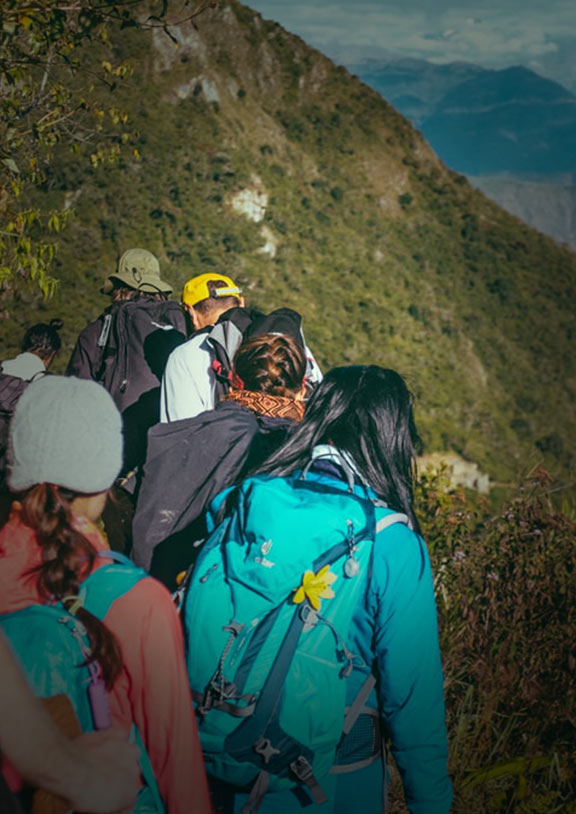
Packing Essentials
Here are items of outdoor clothing and equipment for your Colca Canyon trek:
- Sturdy hiking shoes with good traction. Colca Canyon isn’t flat and sections of trails are gravel.
- Don’t forget a warm jacket , along with activewear, socks, and toiletries. Temperatures drop at night (~25°F, or4°C), especially during the dry season when hiking conditions are best. Planning a Colca trek during the rainy season? Then, don’t forget a rain jacket and other waterproof gear.
- Remember a bathing suit if you plan to enjoy the hot springs in the Colca region – before, during, or after your trek.
- Trekking poles aren’t required but highly recommended for extra balance along steep sections of trail.
- Comfortable backpack to carry your camera, water, and other outdoor essentials.
- Bring sun protection : a wide brim hat, sunglasses, and sunscreen.
- Have plenty of cash . There is not an ATM in Cabanaconde or any of the smaller villages within Colca Canyon. Read about money in Peru .
- Carry a reusable water bottle or water bladder backpack, like a Camelbak, to stay hydrated during your outdoor adventure.
- Apply bug spray if you notice pesky mosquitos around the river in Colca Canyon.
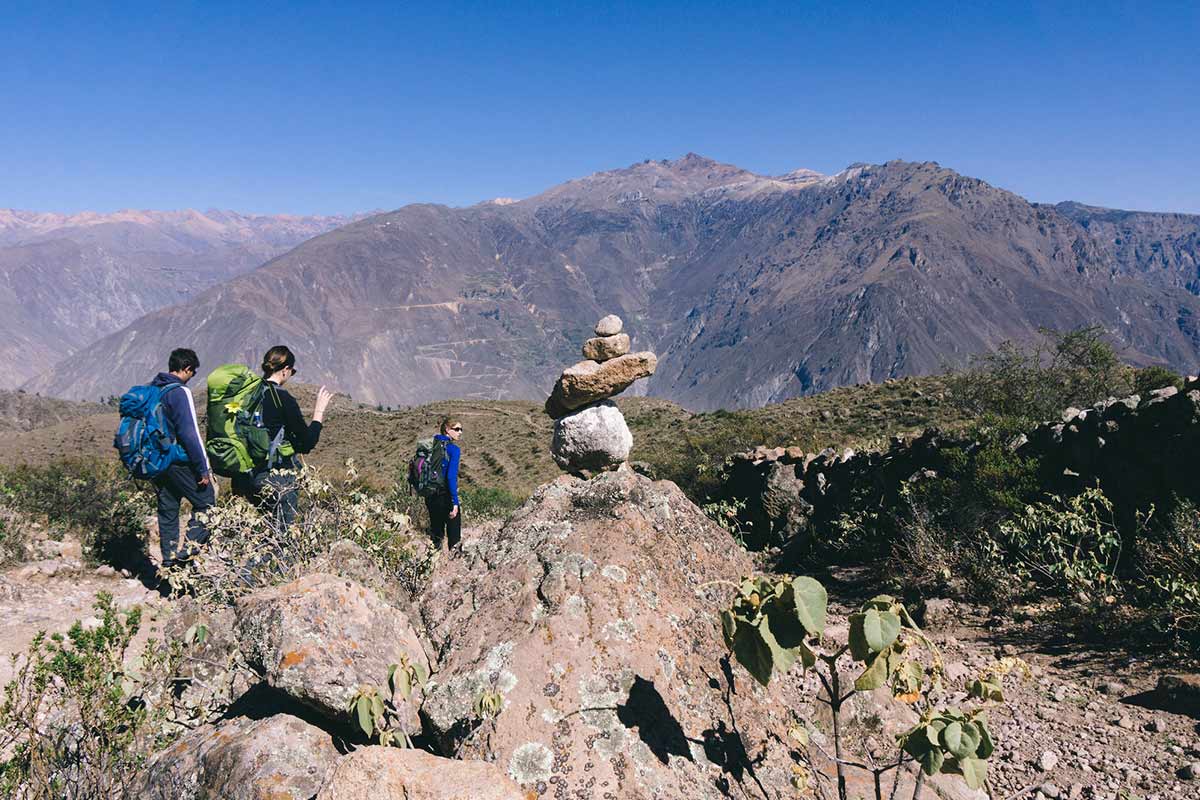
Set off on an exciting trekking adventure in Colca Canyon. Photo by free range jace/Flickr .
Start Planning
A guided or independent Colca Canyon trek is a great addition to your exploration of the world’s second deepest canyon. If you haven’t already read our Colca Canyon Travel Guide , it goes hand-in-hand with planning a trekking adventure and includes helpful information like how to get from Arequipa to Colca Canyon, so be sure to check it out.
Most Peru trekking experiences are focused around Cusco , Machu Picchu , and the Inca Trail but the country has a lot more to offer, and one of the finest and most rewarding alternatives is a trek in the Colca Canyon region near Arequipa. Contact our team and discuss the best way to fit a trek in Colca Canyon, Peru to your custom itinerary.
*Article was updated in July 2020.
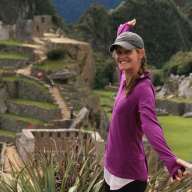
Britt is a California native who now calls Peru home. She is a traveler with a passion for all things outdoors, scuba diving, and capturing memories with her camera.
Tags: Colca Canyon , Colca Canyon Trek
Related posts:
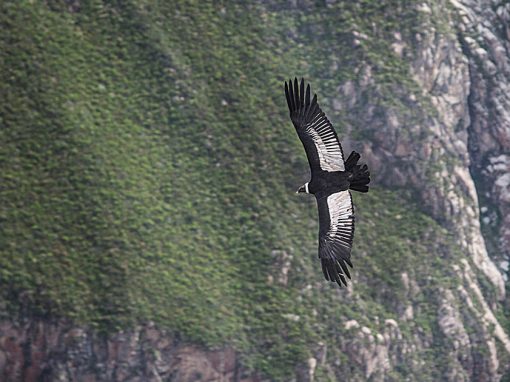
Where to See Condors in Peru
Explore the best places to see condors in Peru including the magnificent Colca Canyon in Arequipa, the world’s second deepest canyon and one of Peru’s most popular destinations.
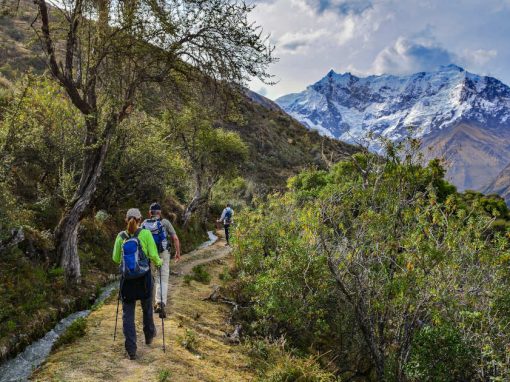
27 Best Treks in Peru: Hiking in the Andes and Beyond
Check out our list of the top 27 best treks in Peru, with hikes like Ausangate, Rainbow Mountain, Laguna 69, Inca Trail, Kuelap, Huayna Picchu and more.

Start Planning!
Explore all our best-selling packages
See All Packages
Book With Confidence
We're flexible! Postpone your tour with zero cost up to 10 days prior to departure.
The following preferences are optional , but will help enhance your trip's customization.
Are you interested in visiting the best restaurants in Latin America?
Book with confidence
We're flexible! Postpone your tour with zero cost up to 10 days prior to arrival with open dates
( Optional. You may choose more than one)
TIP: Tell us the destinations you have in mind.
- Tour Packages
- Machu Picchu
- Amazon Rainforest
- Galapagos Islands
- Sacred Valley
- Lake Titicaca
- 5000+ Reviews
- Travel Guides
- Work With Us
- Responsible Travel
Rely on our expert services to customize a unique experience. Comfortable hotels, tours, and all transportation. 24/7 in-trip support.
Our Peru For Less Travel Blog is a living library of travel information, knowledge, and advice from a group of travel loving experts who live, work, eat, and breathe all things in South America.
"Our tours are Fully Customizable and leave 365 days a year!"
- Destinations
1-817-230-4971
Sales & travel support
Colca Canyon Trek, Peru – A Complete Guide [2024]
![Colca Canyon Trek, Peru – A Complete Guide [2024] 1 hike+colca+canyon+arequipa+peru](https://www.onmycanvas.com/wp-content/uploads/2019/02/hikecolcacanyonarequipaperu.jpeg)
Covid-Related Travel Update Jan 2024 – Peru is now open to international travelers. And as per Supreme Decree 130-2022-PCM in Peru’s official gazette El Peruano, Covid entry requirements and all other regulations and restrictions were lifted from November 2022. You can also look at the official website of the Peru government for more information. My Peru Visa guide for Indian citizens would be helpful, too.
Daring Colca Canyon, Peru
I did not know about the Colca Canyon in Peru until I reached Arequipa. When everyone in Arequipa asked me if I was going to do the Colca Canyon trek, I nodded. As a lazy researcher, I believe in improvised navigation. I had no idea what to see in Peru and went with the flow.
When I decided to do the Colca Canyon hike, I didn’t know Colca is twice as deep as Arizona’s Grand Canyon. The travel company with whom I booked a two-day Colca Canyon tour asked if I had any trekking experience; I thought about my recent Villarrica Volcano endeavor . I nodded. Though the volcano had improved my confidence, trekking into the 3,300 meters deep Colca sounded ambitious.
But without hiking Colca Canyon, my Arequipa visit would have been incomplete. So I paid 120 soles for the two-day hike, ate a heavy dinner, and hit the bed early.
The next morning at 3 am, I boarded the pickup van. My stomach growled with hunger.
Soon we were speeding on the Arequipa-Colca Canyon road, but the enthusiasm of all the ten travelers had been taken over by sleep. The roads were smooth, and we all dozed off.
While writing this article I found out that that road didn’t exist until 1980. It was built only when a hydroelectric project sprouted up in the valley. And then Canyon de Colca – as locals call it – became so popular at least 100,000 people visit it every year.
After driving for three hours, we stopped at the small village of Chivay. It is at a height of 3,650 meters above sea level. We washed away bread, butter, and jam with instant coffee. And then it was time to head to the much-awaited viewpoint La Cruz del Condor to see the Andean vulture. (Though the altitude of Colca — 3,650 meters — may sound ludicrous, that’s how high most places in Peru are. Read my giant Peru Travel Guide to know more.)
Colca Canyon and the surrounding valleys are dense with condors. At the viewpoint, many tourist buses unloaded travelers from around the world. All had gone to see the majestic bird. Condors can have a wingspan of up to eleven feet.
We chatted with the locals selling llama wool sweaters and bufandas, artifacts, snacks, water, and juices. And suddenly many condors were hovering above us. They glided in the sky searching for prey. I don’t have any graceful photos of the giant hunting bird.
I stood at the edge of the valley and gaped at the 1200 meters drop. I wondered what would my mother say if she saw me at the edge of a thousand-meter slope. She got scared if I even looked down from the rooftop of our three-floor home.
We admired the condors and paid the Colca Canyon entrance fees. Then we drove to Mirador de San Miguel ten kilometers away from the condor viewpoint. From there we started descending.
The landscape changed. The Colca river, originating in the Andes 200 kilometers away, had carved the Colca Valley out of volcanic rocks. We were hiking down the valley heading into the mouth of the canyon. Milky clouds floated next to us, and we couldn’t spot any of the forty or so volcanoes the experts say surround Colca.
Gorgeous mountains covered with cactus, wild ferns, and weeds circumscribed us. Their steep slopes were made into terraced fields. Locals have been farming that way since pre-Inca times . Quechua and Aymara people have inhabited Colca since the 13th century. (To know more about Incas, read my What to do in Cusco Peru narrative.)
For a while, the sun was hidden behind the clouds. We walked in shade making sense of the fathomless views. Our guide Juan said we had to walk fifteen kilometers to arrive at our night stay.
The beginning of the Colca hike was a mix of uphill, flat, and downward slopes. And whenever we had to trudge even a small incline, we started panting. We were at an altitude of at least 3,300 meters (the deepest point where we could go was at a height of 2,160 m).
How strange!
Bathed in sweat, I wondered if I would be able to hike up a thousand meters the next morning. But I could not live in the Canyon de Colca forever, and I am too proud to ride mules.
I rushed down the canyon. Others were ahead of me.
After two hours, the group got together at a suspension bridge. Then we climbed for another twenty minutes and stopped for lunch at a cute home in a tiny, yet daring, village of San Juan de Chucho. A simple meal of soup and chicken at Posada Gloria energized us. You can also stay at this cute bed and breakfast if you want to hike Colca Canyon by yourself.
I couldn’t help but wonder at the helplessness and strength of the people who lived at such heights. Imagine if you had to climb or trek Colca Canyon every time you needed medicines or oil.
After saying goodbye to our hosts, we walked towards the town of Cosnirhua. The forest fringing the path was dense with fig, plum, avocado, medicinal herbs, cactuses, bamboos, and a myriad of colorful flowers. It does not take more than that to keep me entertained. Occasional views of vicuñas helped.
A preparatory read for your South America trip: Important Spanish Phrases
And then we crossed Malata to continue walking towards the Oasis Sangalle, the base of the Colca Canyon. Oasis Sangalle was an oasis offering many lodges and hotels in the middle of nowhere. We stayed at the Paraiso Las Palmeras Lodge which had a deep-blue swimming pool, a restaurant, and a bar.
While I was wondering how were the owners allowed to build such commercial stays in the middle of nature’s most wonderful creation, my traveler friends called for beers. We swam around in the pool, plucked green mangoes, and downed a beer. It was time for bed.
We woke up at 3 am. At 4, we were trudging up the Canyon. Amongst the many Colca Canyon treks , Juan had chosen a shorter so, of course, steeper trail. He said the slow ones would have to ride a mule to catch up with the rest of the group.
I was confused. Would the mountains grow in height if we climbed them slowly? I understood that hiking under the sun would be challenging but how could I explain that to my weary legs?
While most of our group walked ahead, an Austrian girl and I plodded behind. And then we saw an old couple walking up with walking sticks and a smile on their faces. From then on I decided if I didn’t enjoy the hike there was no point in doing it at all. I couldn’t give up when men and women years older than me were pulling it together to reach the summit.
After that, I ignored Juan. I focused on one step at a time and soaked in the views. The faint light of the dawn had started dissolving the darkness. And out came the green and brown slopes of the mountains that lay peacefully for us to climb. Slowly and steadily we made it to the top in almost three hours.
Once at the top, we got a cheer from the group. But Juan asked everyone to start walking quickly for we had to hike another twenty minutes to Cabanaconde for breakfast. My numb legs screamed for mercy, but my famished stomach pushed them to continue.
The exertion of the Colca Canyon trek was absorbed by the hot springs at Chivay on our way back. And I didn’t think before diving in. [For more such amazing adventures, head to my fun things to do in Peru guide.]
Where is Colca Canyon in Peru?
Colca Canyon is 200 kilometers North-west of Arequipa.
What is the best time for doing Colca Canyon Trek?
I went to the canyon in March. Though it was monsoon in Peru, it didn’t rain in the Colca canyon while we were there. The best months to visit Colca are from April to August. Beyond August, the mountains would be too cold.
How deep is the Colca Canyon? Or how high is Canyon de Colca ?
The descent begins at 3,300 meters above sea level, and the deepest point of the Colca Canyon is 2,160 meters above sea level. Though you are always at a minimum altitude of 2000 meters, you hike 1200 meters down and up.
How to prepare for hiking Colca Canyon?
Take two to three days to get used to the altitude. Walk around in Arequipa. Your body will get acclimatized (and produce extra red blood cells you would need at that height to compensate for the lack of oxygen). Don’t drink alcohol before the trip. Get used to a lot of water instead. Eat nutritious meals and sleep well. And you are ready to go.
What to carry for the Colca Canyon hike?
Listing down some of the important things you should bring with you on your Colca Canyon tour,
- Warm jackets for men and women .
- A rain jacket – Always carry one in South America for you never know when it might rain.
- Yoga pants for women and men – Would be the best to do the hike.
- Hiking socks for women and men .
- A hat – Too much direct sun at those heights isn’t good.
- Strong sunscreen – Andean mountains can be pretty sunny, and you would burn in a minute
- Lifestraw water bottle – This reusable filtered water bottle comes with an inbuilt filter, and you can fill it anywhere. A filter water bottle is essential because you cannot drink tap water in Peru.
- Swimwear for women and men – There is a pool down at the oasis. The tour would also take you to a natural hot spring while returning to Arequipa.
- Good hiking shoes for women and men – A must-have.
- A travel towel – Carry a light travel towel to save space.
- Flashlight – Please don’t go without it.
- A pair of change for the next day
- Snacks (snacks down the canyon or on the way are expensive)
- Medicines for altitude sickness and dizziness
Some cash to buy extra food and drinks.
How to choose between various Colca Canyon tours? Should you take a 1 day Colca or a 2 day Colca Canyon tour?
Colca Canyon day tour from Arequipa would be too rushed. The distance from Arequipa to Colca Canyon is almost 200 km and takes 6 hours. So you can imagine how much you will be able to see.
But it is a good option if you just want to take a peep down the canyon or feel unprepared for the trekking Colca Canyon (in which case you should go later). The day trip will take you to Chivay, stop at souvenir shops, make a halt at the Mirador Cruz del Condor, and then you will be driven back to Arequipa.
The best way to see Colca Canyon is by descending into the mouth of the giant.
The central square of Arequipa is lined with Colca Canyon tour operators. Talk to a few for availability and prices.
Either opt for Colca Canyon’s two-day tour with a one-night stay at the canyon, which is what I did. Or choose a 3-day Colca Canyon trek with a two-night stay. One halt would be midway and another one would be in the Oasis.
Or if you do not want to hike Colca, consider this two-day tour or this one day-trip . These will take you to all the good places around the canyon but wouldn’t take you inside, a compromise for not trekking the canyon. Another option is to tell your tour operator you would need mules. That way you would be able to trek down the canyon riding a mule, and the locals would make some money which would, in turn, feed the lovely animals.
How much do the tours to Colca Canyon cost?
I paid 120 soles: about 35 USD for my Colca Canyon tour. The accommodation was basic, the breakfasts were average, and neither the 70 soles entrance fees to the canyon nor the 15 soles tickets at the hot springs were included in this price. PeruHop , a reputed company for the Colca Canyon hike, charges about 40 USD for a similar tour.
Should you hike the Colca Canyon without a guide?
You can trek Colca canyon on your own. Many travelers told me they had done the hike themselves at leisure. And if you do the trek yourself, you can walk at your pace.
I felt a bit pushed by the guide. He wanted us back by a certain time even if we had to hurry up. What’s the point of hiking if you are not going to look around on one of the most beautiful treks in the world?
Go to the tourism office in Arequipa and ask for a map of Colca Canyon and bus schedules to Chivay, the closest village connected by road. Take a bus from the bus terminal in Arequipa to Cabanaconde. Or book this comfortable one-way bus transfer to Chivay .
Tiny villages keep the Colca mountains alive. They also serve as places to stay and eat at. You can sleep in San Juan and Sangalle. Or in another village called Llahuar.
Here is an exhaustive guide to hiking the Colca Canyon without a guide .
You can also go from Arequipa to Puno or from Puno to Arequipa via the Colca Canyon. Traveling that way would save a lot of time.
Is Colca Canyon worth the pain?
Absolutely.
Trekking Colca Canyon is underrated. When I reached the summit after plodding along for three hours under the scorching sun, I couldn’t help but think that I could do anything I set my eyes on.
If you don’t believe me, head to the Canyon de Colca and see for yourself.
The next morning I woke up without an alarm. A big breakfast, a quick taxi, and a comfortable bus to Puno accompanied me that morning.
As my eyes wandered through the beautiful Peruvian landscape, I looked forward to the upcoming months of travel through South America and wondered what other fears my journey would strike.
Must Read: Don’t go to South America without reading This Guide and my tips to Learning a Language by Yourself is a must, too
Are you planning to hike Colca Canyon?
Like my guide! Please pin it and share it with the world.
Disclaimer: This post contains affiliate links to the products I like; if you choose to click through and make a booking or purchase a product, I will earn a little bit at no extra cost to you. Thank you.
Want similar inspiration and ideas in your inbox? Subscribe to my free weekly newsletter "Looking Inwards"!
4 thoughts on “Colca Canyon Trek, Peru – A Complete Guide [2024]”
Thank you so much Albina. I am glad you had fun.
I loved Colca, it was so much fun even though everything hurt on the next day. Like your post and I love that you are being honest here.
Wonderful blog, Priyanka! I enjoyed reading about your trek. Colca Canyan does look like a fabulous trek. I’d love to do it.
Thank you so much, Renuka. Glad you liked the post. Please go for the hike and tell me if you enjoy it.
Leave a Comment Cancel reply
This site uses Akismet to reduce spam. Learn how your comment data is processed .
Get a FREE Essential Travel Apps and Websites Checklist!

3-Day Colca Canyon Trek via Llahuar, Peru – A Complete Hiking Guide
If you’re planning to trek in the Colca Canyon, one of the world’s deepest canyons, then you’re in the right place. In this detailed guide you can read everything you need to know about what it’s like to embark on a 3-day Colca Canyon trek via Llahuar in the majestic Peruvian Andes.
You can read this blog post in conjunction with our comprehensive Colca Canyon guide that explains all the different ways you can visit the canyon and how to prepare for the trek, whether you do it solo or as a guided hike.
In addition, you can always watch the dedicated Colca Canyon video we shared on our YouTube Channel.
Disclosure: This post may contain affiliate links, which means we may receive a small commission if you click a link and purchase something. Clicking these links won’t cost you anything, but it will help us to keep this site up and running! Learn more about our affiliate policy.
Table of Contents
Introducing the Colca Canyon, Peru
Located about 160km northwest of Arequipa , the second largest city in Peru, is the magnificent Colca Canyon (Cañon de Colca). Situated in the Colca Valley in the Andes Mountains, the Colca Canyon was formed by a seismic fault between the volcanoes of Coropuna and Ampato.
The nearly 100km (or 70km) long canyon is also one of the world’s deepest canyons. Its deepest point is approximately 3,400m which makes it twice as deep as the well-known Grand Canyon in the US.
In the pre-Inca era the valley was inhabited by the communities of the ‘Collaguas’: the Quechua-speaking Cabanas and the Aymara-speakers from Lake Titicaca and the Puno area . These cultures created agricultural terraces on the hillsides that are still used today by local farmers.
The Incas arrived and slowly took control of the area after 1320 A.D. Then the Spanish arrived after 1540, becoming the most influential group in the area.
The Colca Canyon is also home to Andean condors, which are the largest flying birds in the world by combined measurement of wingspan and weight. They can weigh up to 15 kg (33 lbs) and they have a wingspan of 3.2m (10.5 ft). For comparison, that’s twice as long as me!
Did you know? The Condor is part of the Inca Trilogy along with the puma and the serpent. These three animals represent heaven, earth and the world of the dead.
3-Day Colca Canyon Trek via Llahuar or San Juan de Chuccho
It’s worth noting at the start that there are various different circular routes you can choose from and there’s no right or wrong one. One thing’s for sure though. No matter which route you pick you’ll have to hike down to the bottom of the canyon and then back up again.
Many only sign up to complete a 2 day-1 night route for reasons we discuss in this blog post .
However, for those who really enjoy hiking and have the time to spare, we highly recommend planning a 3 day-2 night hike. This will give you the chance to go slower, enjoy the views longer and it’ll definitely be less tiring overall.
Without listing countless different options, we’re just going to highlight the two main routes that most people will likely do in 3 days.
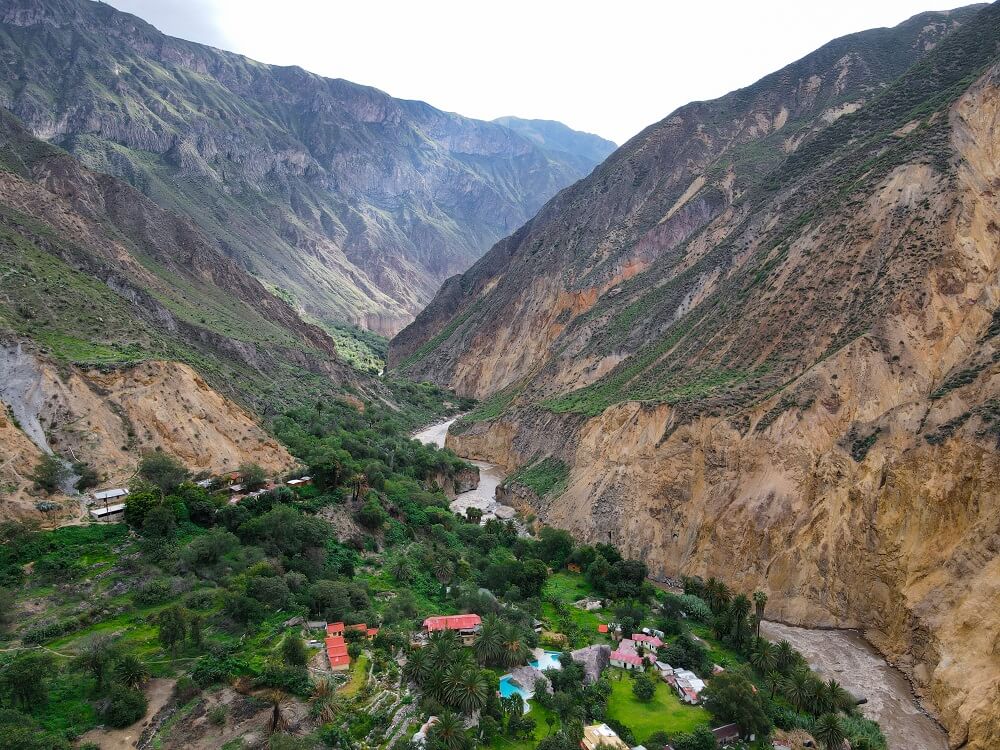
1. Cabanaconde – San Juan de Chuccho – Sangalle – Cabanaconde Route
This particular 3-day trek through the Colca Canyon is probably the most popular route. It is around 20 km (12.5 mi) overall, with a total elevation gain of just over 1,600m (5,292 ft).
On your first day you would hike from Cabanaconde to San Juan de Chuccho and spend the night there. This section is around 10 km (6.2 mi) and pretty much all downhill. The next day, you would be hiking to Sangalle which is only about a 5 km (3.2 mi) distance. You would spend the night in Sangalle and would hike back up to Cabanaconde the following morning.
This section of the hike is the toughest despite being a similar distance to the second day (5km or 3 mi). However, you’ll have 1,000 m (3,281 ft) of elevation gain to overcome before you reach the top.
It’s worth noting that if you’re only doing a 2-day hike, many guided treks will take you along this exact route but would only stop for lunch in San Juan de Chuccho and would carry on to Sangalle on the first day. For this reason, this particular 2-day Colca Canyon trek is often said to be one of the hardest hike’s tourists can complete in Peru.
It’s also going to be busier, so if you want to avoid heavily trafficked trails then perhaps consider the Llahuar route.
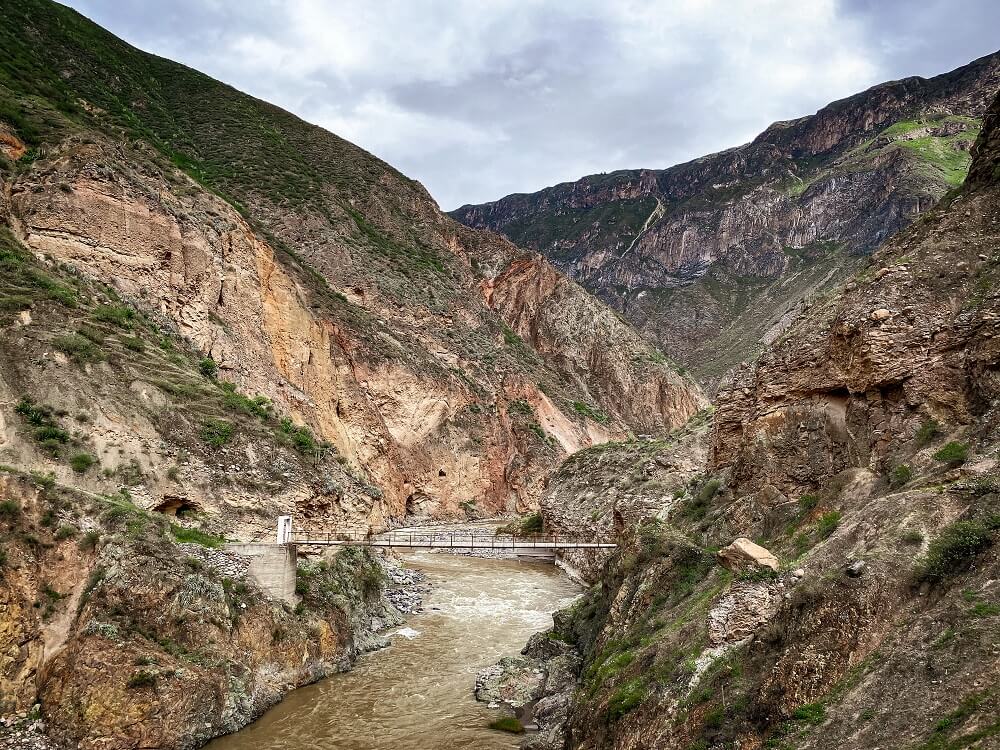

2. Cabanaconde – Llahuar – Sangalle – Cabanaconde Route
This circular route would take you from Cabanaconde to Llahuar on your first day where you would spend the night. The first day is a similar length to the above option at around 10km (6.2 mi). It’s a lot of downhill again which can be hard on your knees. The next day you would hike from Llahuar to Sangalle. This section will be just over 11km (6.8 mi). You’d spend the night in Sangalle and would hike back up to the top the following morning. This is going to be a 5 km (3 mi) section with 1,000 m (3,281 ft) of elevation gain.
Overall, the Llahuar route is around 26 km (16 mi) with a total elevation gain of nearly 2,000 m (6,562 ft). Since there are only a handful of guided tours offering this route it’s normally a little more expensive. However, it won’t be nearly as popular.
We personally picked this route and have no regrets. It was quiet until the last day when we had to hike the same section out of the canyon as other trekkers.
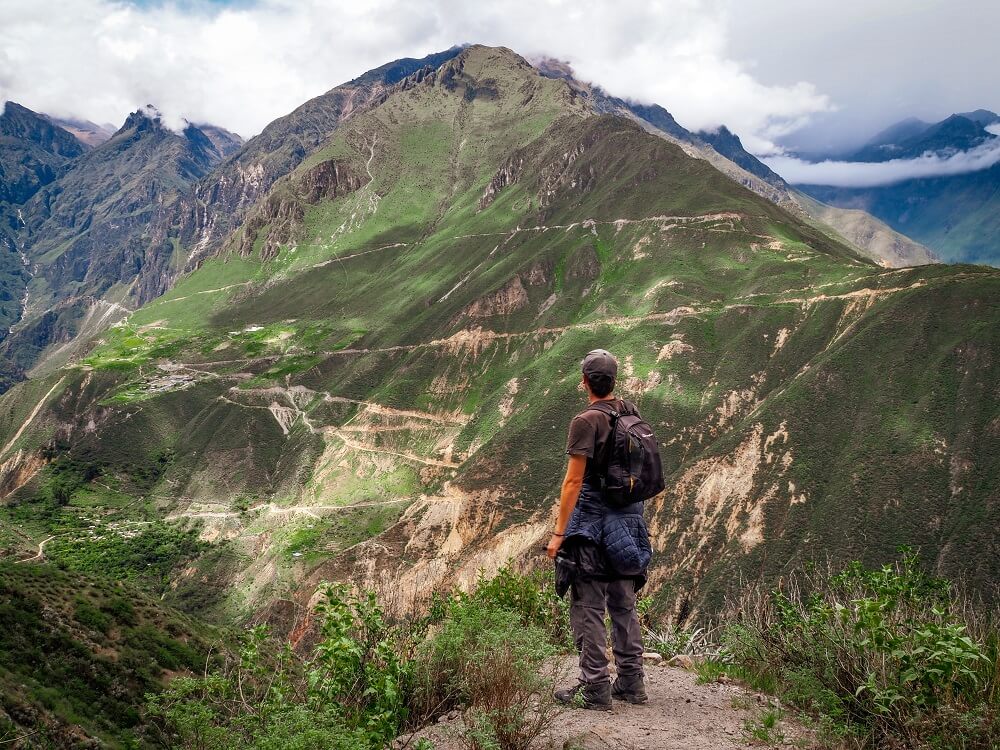
Information About the Colca Canyon Trek via Llahuar Route
1. length of the colca canyon trek via llahuar.
As mentioned above the total length of this route is around 26 km (16 mi). It is challenging but the distance is also spread across 3 days unlike the most popular 2-day trek where you’d have to hike around 20 km (12.5 mi) in just 2 days.
The first day you’ll be hiking from Cabanaconde to Llahuar which is about 10km (6.2 mi). We started to trek around 10AM and got to our accommodation around 3PM. It took us 5 hours to complete this section, but since it was our first time in the canyon we stopped a lot for photos. It was mainly downhill too, so that can slow you down a bit.
The next day you’ll hike from Llahuar to Sangalle. This section will be just over 11km (6.8 mi). We started trekking around 9AM and got to our accommodation around 14:30PM. So, it took us about 5.5 hours to complete day two.
At only 5km (3 mi), the third day will be the shortest day. However, it’s also the toughest one as it’s all uphill. We left around 5AM and got to the top just after 7AM. So it took us a little over 2 hours to complete the hardest section of the Llahuar route.
The Colca Canyon trek was a great way to prepare us for the 5-day Salkantay Trek where we had to hike 26 km (16 mi) in one day!
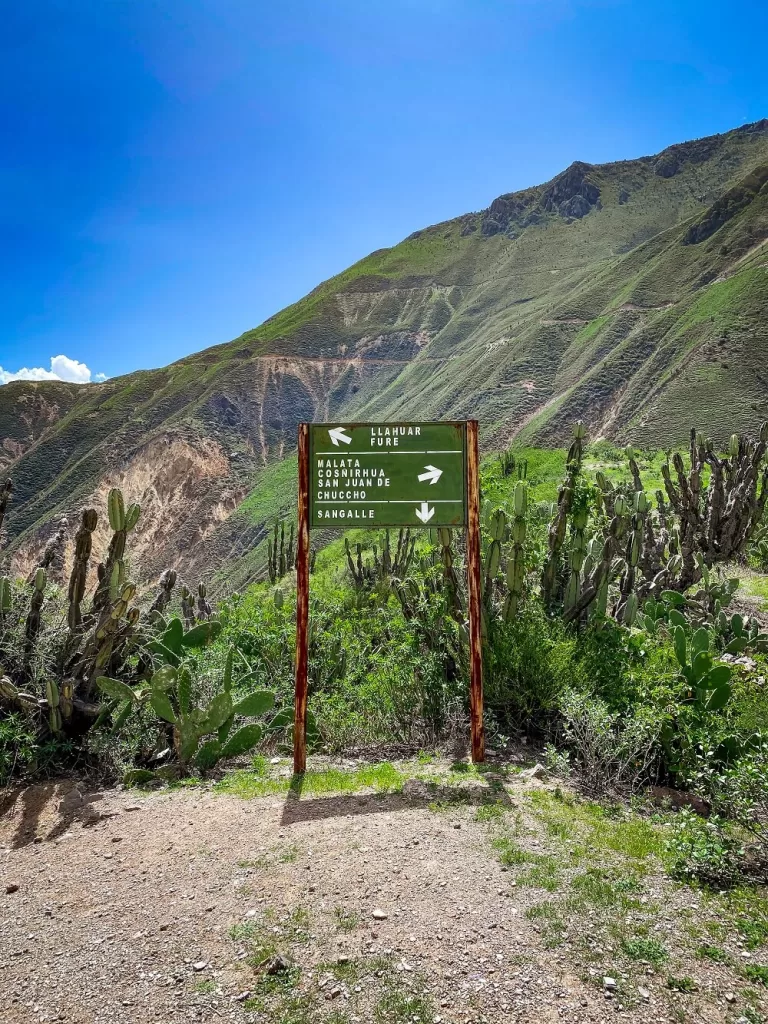
2. Level of Difficulty
The Colca Canyon trek is challenging, whichever path you choose. Whilst you don’t need to be super fit to do the hike, it’s definitely not for a first-time hiker either. We’ll detail below all the challenges you can face on this route, so make sure to be realistic about your abilities and don’t underestimate this trek.
Elevation and Altitude:
Altitude and elevation are some of the many hurdles you’ll face during your Colca Canyon trek via Llahuar. Cabanaconde, where you start your hike, is located at 3,287 m (10,784 ft) above sea level. Luckily, you’ll be going downhill on your first day which can make you feel better as the air won’t be as thin further down. However, Llahuar Lodge itself is still at 2,118m (6,949 ft) above sea level.
You won’t be going too high up the next day and Sangalle Lodge is located around 2,100 m (6,889 ft) above sea level. However, on your final day, you’ll have to hike all the way back to Cabanaconde, which means that you’ll be gaining over 1,000 m (3,280 ft) of elevation.
There are many symptoms of altitude sickness, including dehydration, dizziness, headaches, shortness of breath, heavy breathing, loss of appetite, nausea and vomiting. It’s good to remember that anyone can develop altitude sickness and its symptoms can be less or more severe depending on the person.
We highly recommend acclimatising in Arequipa first, which is located about 2,335 m (7,660 ft) above sea level. It’s also very important to stay hydrated during the trek to avoid dehydration and headaches. Try to avoid drinking too much alcohol before your trek and don’t eat too many heavy foods either. You can drink Coca tea like the locals do at high altitudes in Peru. In addition, you can also buy some altitude sickness tablets before your hike in Arequipa.
Temperatures and Weather Conditions:
If the altitude wasn’t enough to deal with, you’ll have to be mindful of the temperatures too when trekking. The sun can be pretty intense, especially in the dry season. There are hardly any trees to offer shade, so it’s important to wear a hat, sunglasses and sun-cream. There are a lot of sun-protecting hiking clothes out there that you can consider wearing too.
Again, other than wearing sun-protection, make sure to drink enough water to avoid dehydration. You don’t want to get sun-stroke or burnt.
Now, apart from the hot temperatures during the day, it’s worth noting that it’s pretty cold the higher you are, especially at night. So, bringing plenty of layers is important too.
During the wet season, the rain can make the trek less enjoyable, so if you’re trekking in that season make sure to pack plenty of waterproofs.
During the dry months, the paths are mainly dusty with small, loose rocks, which can be a trip hazard if you’re not careful going downhill. This can definitely make the trek more physically demanding.
In the wet season, the path can easily become muddy and slippery, which again can make the trail more difficult.
Finding the trailhead isn’t too difficult. Just follow Calle San Pedro from the main Plaza then Calle Simon Bolivar. The road will end and then turn into more of a trail. Navigating the path is relatively easy. There are general signs towards your accommodation so just follow them and have an offline map downloaded too such as Google Maps or AllTrails. Locals are also very helpful, so it’s worth downloading Spanish offline on Google Translate in case you don’t speak much Spanish.
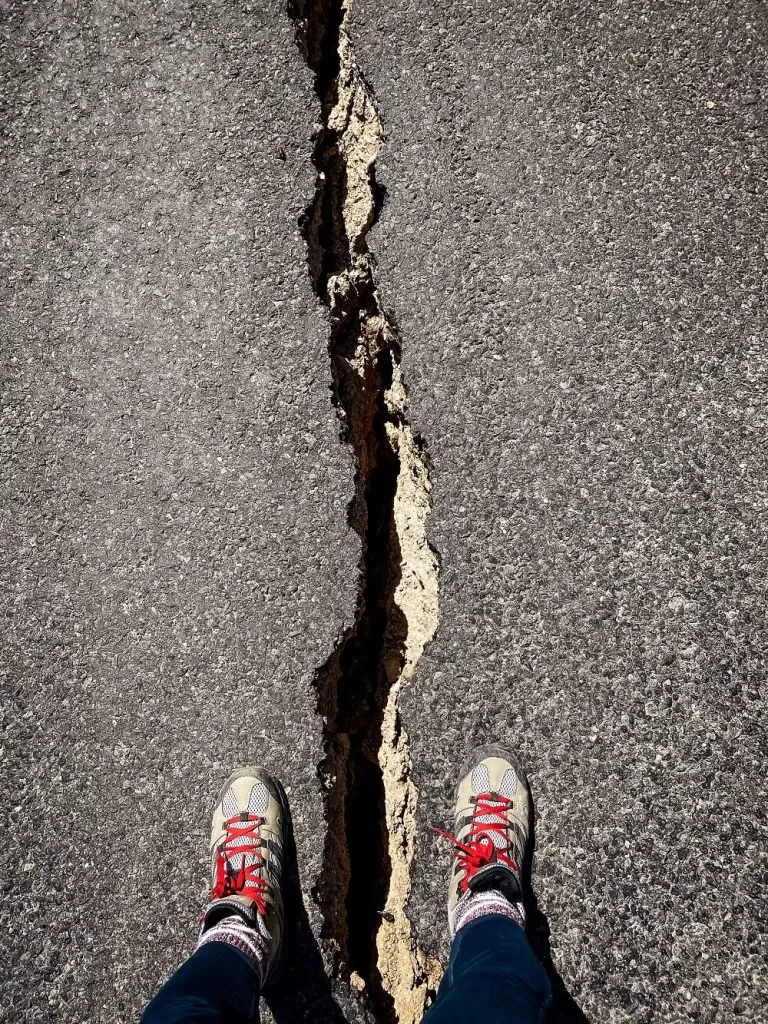
Earthquakes:
The Colca Valley is surrounded by several volcanoes and therefore seismic activity is very high in the area. This means that earthquakes and landslides are very common.
The first morning of our visit there was a small earthquake which was followed by a 5.6 magnitude one during our first night. Being woken up by a quake in the middle of a canyon can be scary. Luckily, the epicentre was located away from our accommodation but it still did some serious damage to the main road between Chivay and Cabanaconde. This meant that on our last day we had to hike through this damaged section. This was only our second experience with earthquakes on this trip after feeling one small one in Costa Rica .
Because of the damage to the roads we were very happy that we went with a guide who received regular updates, and was able to organise our transportation back to Arequipa a lot more easily than we could have on our own.
3. Best Time to Hike in the Colca Canyon
March, April and May are probably the best months to visit the Colca Canyon. The wet season is ending in March / April, so the valley is still a lush green as opposed to the dry yellow of the dry season. The temperatures are more pleasant and there will also be less chance of rain.
Click here for more pros and cons of hiking the Colca Canyon in the dry and wet seasons.
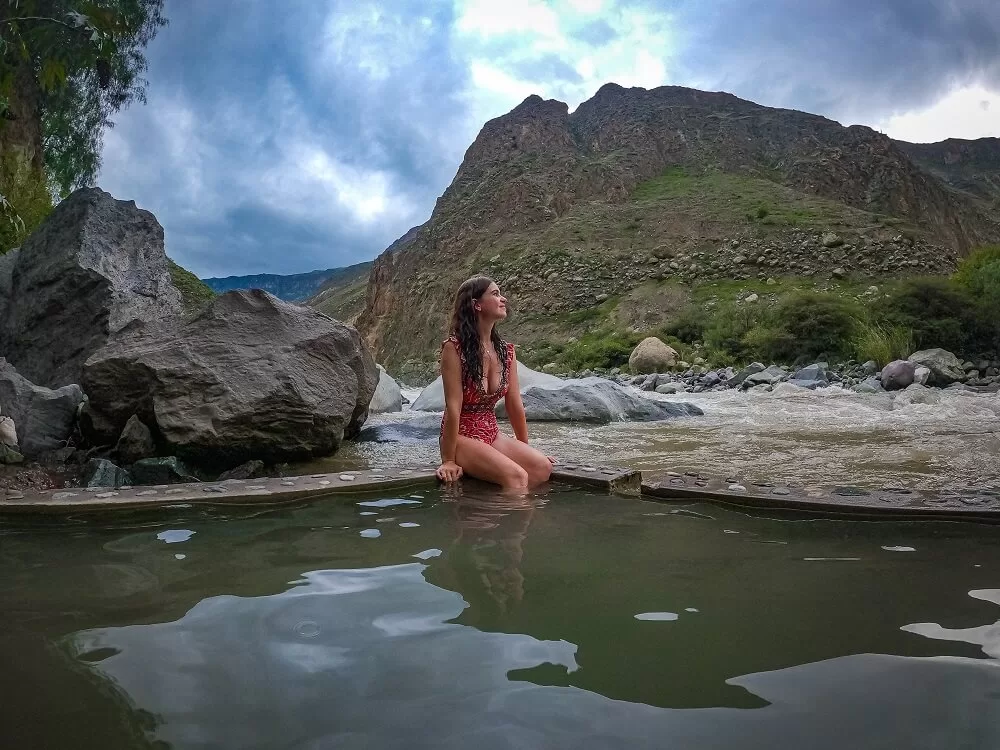
4. Facilities Along the Hike
Accommodation. You can book your first night’s stay at Llahuar Lodge and the second one in Sangalle. They have some simple accommodation options you can book, such as Paraiso Las Palmeras Lodge , Oasis Paraiso Ecolodge and Eden Lodge. Click here for more information on accommodation in the Colca Canyon.
Cafes and restaurants. There are some places to buy food from in Cabanaconde. There won’t be any other pit stop options until you reach Llahuar Lodge. We recommend packing enough food and snacks to keep you going until you can have lunch at the Lodge. It’s the same on your second day, with a hot meal waiting for you in Sangalle. Click here for more information on what to eat on the Colca Canyon trek.
Toilets. You can find toilets in Cabanaconde and at your accommodation in Llahuar and Sangalle. You’ll need to find a private spot anywhere else along the trail.
Phone reception. An important thing to mention is phone reception. We bought local SIM cards upon arriving to Peru, which we recommend doing. Unfortunately, you won’t have much signal in the canyon. For this reason, we recommend downloading offline maps and Google Translate if you’re doing the hike independently.
Click here to read about what to pack for a multi-day trek in the Colca Canyon.
The 3-Day Colca Canyon Hiking Trail via Llahuar
Please note that we completed this Colca Canyon trek via Llahuar as part of an organised hike. This meant that we had a 3AM pick up from Arequipa followed by a quick breakfast in Chivay. We stopped briefly at Cruz del Cóndor viewpoint before being taken to the trailhead in Cabanaconde.
On our last day we also stopped at the hot springs in Yanque to relax our sore muscles, before briefly stopping at Patapampa (volcanoes viewpoint) and at the National Reserve of Salinas and Aguada Blanca to see some vicuñas, llamas, and alpacas.
If you’re completing the trek without a tour, you’ll need to find ways to reach these locations with local taxis and colectivos as they are quite far apart. For more details, you can check out our day-trips from Arequipa blog post.
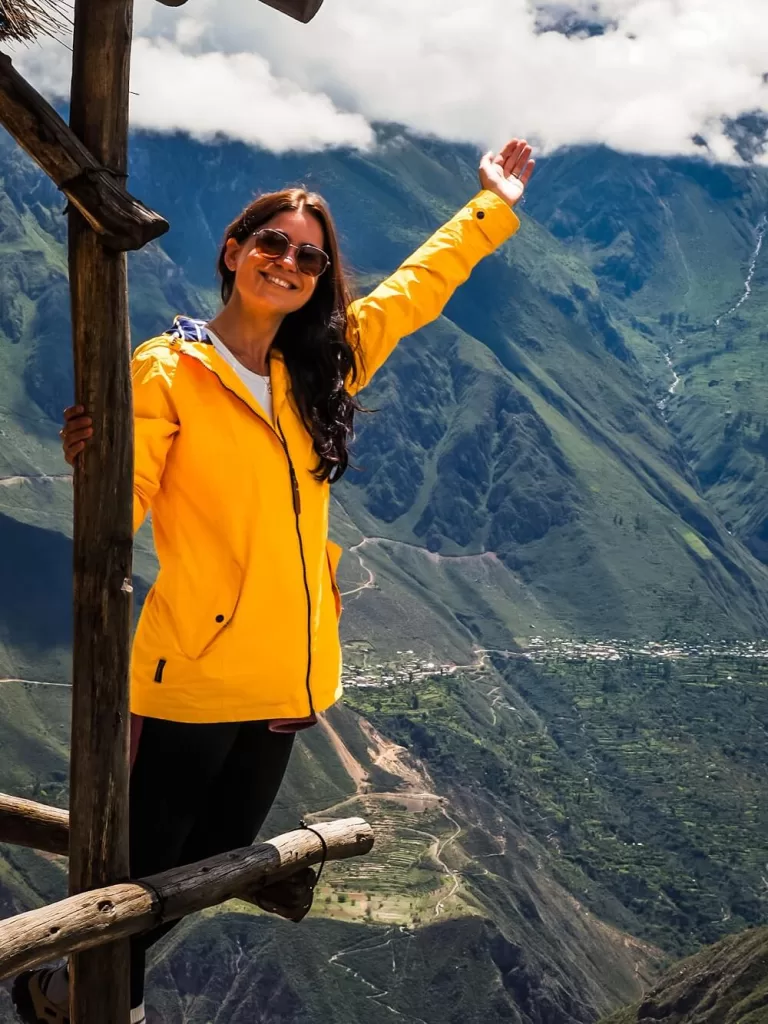
Day 1: Cabanaconde to Llahuar
From the main Plaza of Cabanaconde you’ll have to follow Calle San Pedro and then Calle Simon Bolivar until the road ends. For reference, Cabanaconde is about 3,287 m (10,784 ft) above sea level. For the first 3 km (1.8 mi) you’ll be walking along the edge of the canyon through some lovely cornfields. Less than a km (0.6 mi) into your hike you’ll pass a viewpoint called Mirador Achachihua . It’s a beautiful viewpoint, so make sure to stop there briefly.
After about 3 km (1.8 mi), you’ll start your descent into the canyon. The first 1.5 km (0.9 mi) is steep downhill until you reach a bridge over a stream that runs into the Colca River. At this point you’ll be approximately 2,800m (9,186 ft) above sea level.
For the next 1.3 km (0.8 mi), you’ll be walking along the side of the canyon. Luckily, this section is relatively flat, a welcome break before you’ll have to tackle even more downhill.
The following 2.15 km (1.3 mi) will be another steep descent until you reach Churica village and a bridge crossing the Rio Colca. The bridge is located around 2,120 m (6,955 ft) above sea level, so you’ll be descending around 700 m (2,296 ft) give or take.
From this point, Llahuar Lodge will be about 2.3 km (1.4 mi) away located at around 2,100 m (6,889 ft) above sea level.
Once you’re at the lodge you can settle in, have lunch and then enjoy the hot springs next to the Colca River until dinner time.
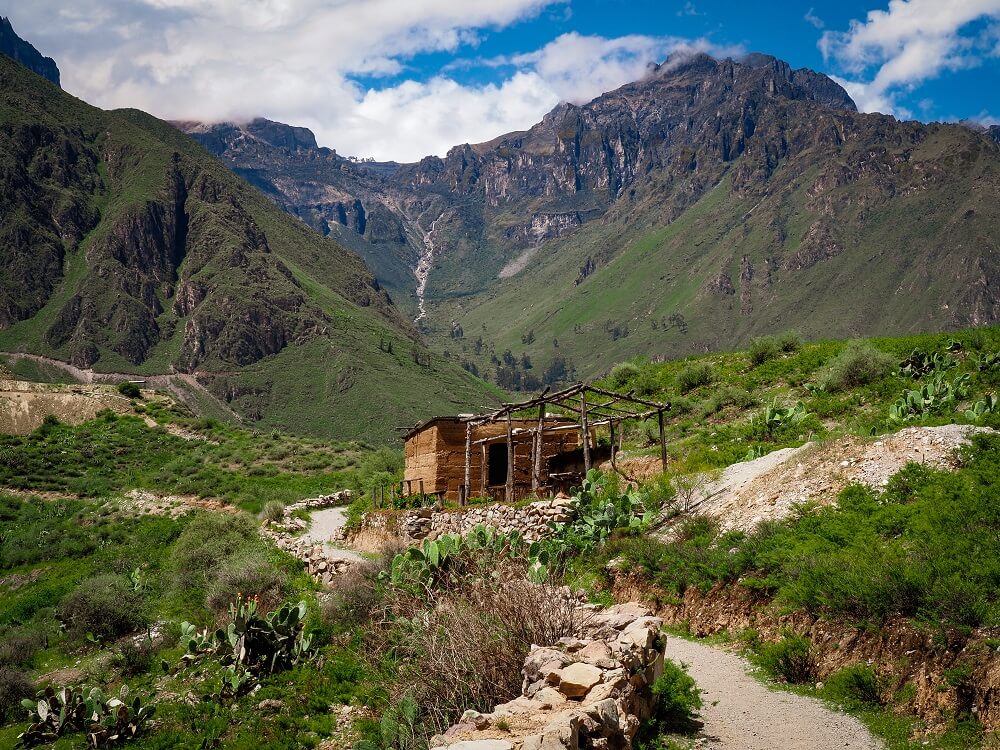
Day 2: Llahuar to Sangalle
After a filling breakfast at Llahuar Lodge, you can make your way towards Paclla and Belen villages and to Mirador Apacheta. This first section of the hike will be just under 5 km (3.1 mi) with an elevation gain of nearly 700 m (2,296 ft). For reference, Mirador Apacheta is located around 2,800 m (9,186 ft) above sea level.
From there you’ll be heading towards Malata village. The first 2 km (1.2 mi) will be pretty flat, then you’ll have to start descending towards Sangalle. This downhill section will be around 3 km (1.8 mi) long. For reference, Sangalle is located around 2,200 m (7,217 ft) above sea level.
The oasis is very beautiful and has many swimming pools you can relax in whilst waiting for your dinner. You can also have lunch at your accommodation. Since most other 2 and 3-day trekkers will be staying in Sangalle, it’s going to be much busier than Llahuar Lodge.
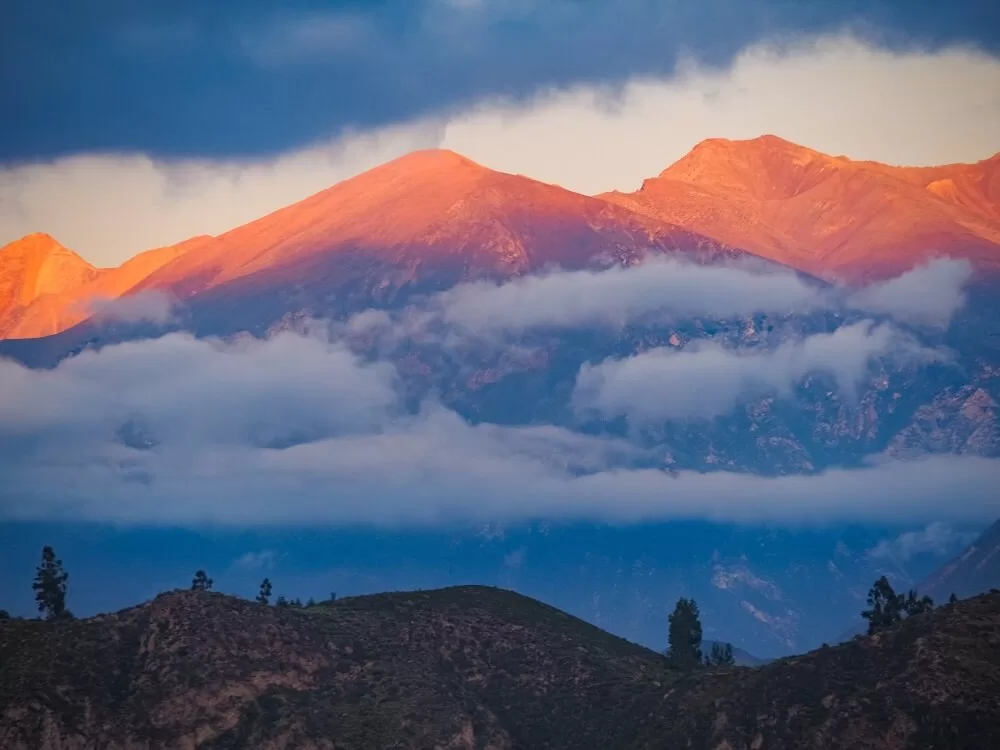
Day 3: Sangalle to Cabanaconde
Starting your hike as early as possible is recommended on your last day of trekking. We left around 5AM and it was still dark until we got about half way up the canyon. This meant that we could witness a magical sunrise and also appreciate just how far we’d come in the dark.
On your last day, the distance of your Colca Canyon trek via Llahuar will only be about 5 km (3 mi). However, you’ll be gaining about 1,000m (3,280 ft) of elevation which is no joke. (Especially before coffee)!
You can of course hike up just after breakfast if you’re doing the hike independently. However, hiking this section with a full stomach would be a bit too much in our opinion. Also, hiking in the dark actually made us hike faster since we didn’t stop for photos or breaks that often.
Be prepared for a lot of switch-backs and false summits before you reach the top, but you’ll get there eventually and that’ll be a fantastic feeling!
Now, once you’ve reached the top, you’ll still have to get back to Cabanaconde which is another 1.3 km (0.8 mi) away from the edge of the canyon. Once you’re in Cabanaconde, you’ll have successfully completed your 3-day Colca Canyon trek via the Llahuar route.
Final Thoughts on the 3-Day Colca Canyon Trek via Llahuar
The Colca Canyon was our first ever multi-day trekking experience and we loved it. We always knew that we wanted to trek in the canyon. To maximise our time there, we opted for the 3-day hike. We were very happy with the route we chose as it was definitely much quieter. We only had to walk with a bigger group of people on our last morning when most 2 and 3-day hikers were also ascending along the same route. It was dark for the most part, so we didn’t mind that at all. It was actually quite a nice atmosphere at the top with everyone celebrating their achievement.
Have you ever visited the Colca Canyon before? If so, did you go on a trek or a tour? How was your experience? If not, would you add the Colca Canyon to your bucket list? Let us know in the comments below.
Now, let your adventure begin,

Our Top Travel Resources
Accommodation: For hotels we always use Booking.com and Hostelworld for hostels. We also book longer stays on Airbnb or Vrbo.
Flights: To find the best flight prices we always check Skyscanner , Google Flights or WayAway. Then we also check the airlines’ websites too for comparison.
Car Rentals: We use Discover Cars when we want to rent a car as it compares local, national and international companies.
Activities: If we book organised tours we always check either GetYourGuide or Viator.
Foreign Currency: Whenever we can we prefer to pay in local currency and for that we always use our Wise card. We can easily withdraw money from the ATM or pay by card at most shops and restaurants.
Travel Insurance: We never go anywhere without travel insurance. You never know what will happen on your trip, so good travel insurance like SafetyWing can protect you in case of injury, illness, theft and cancellations.
eSIM and VPN: To get data abroad we use Airalo which is an app that allows you to download a prepaid eSIM to your phone in over 190 countries. Make sure to have a VPN to avoid hackers accessing your personal data when using public WIFI. We use Surfshark which is the only VPN that offers one account on unlimited devices.
Remember…It all starts with a Pin…
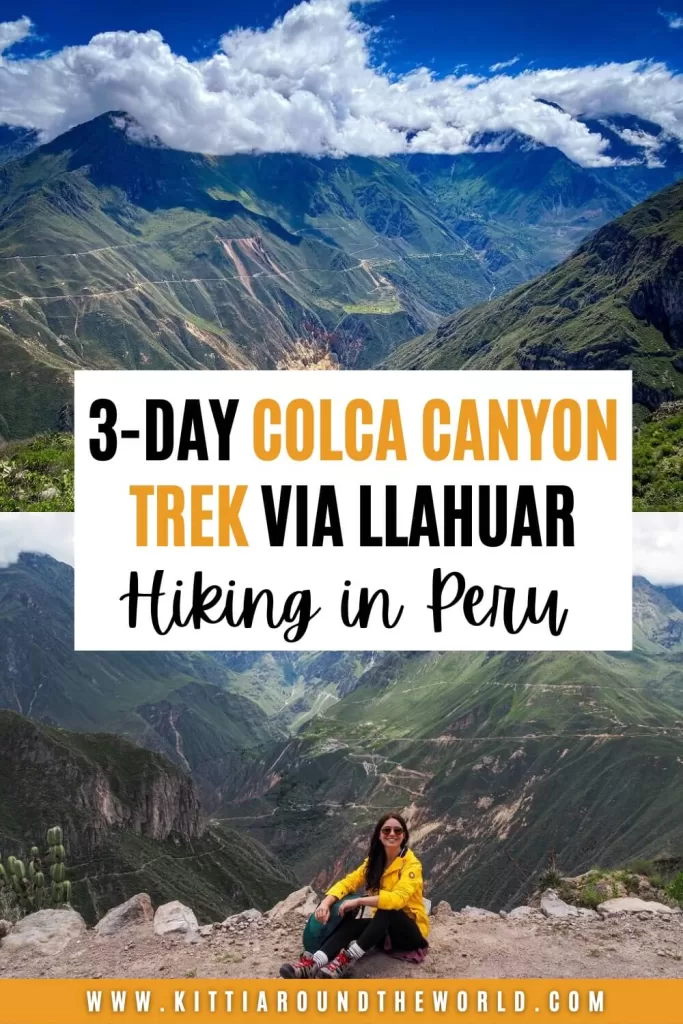
Similar Posts
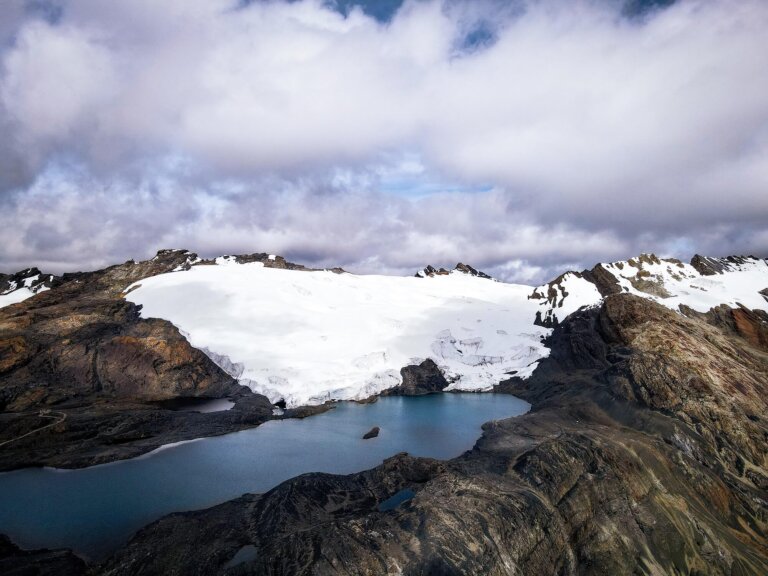
A Guide to Visiting Pastoruri Glacier in Huaraz Peru
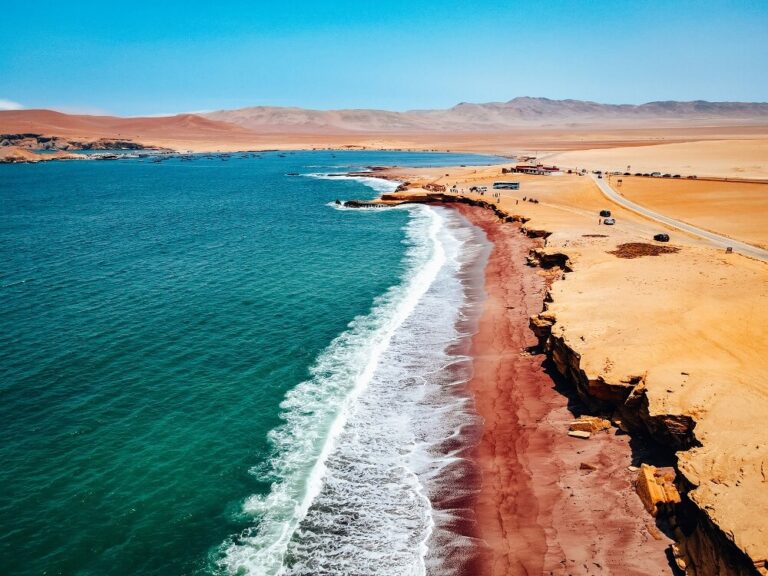
Best Things to Do in Paracas, Peru – A Complete Guide
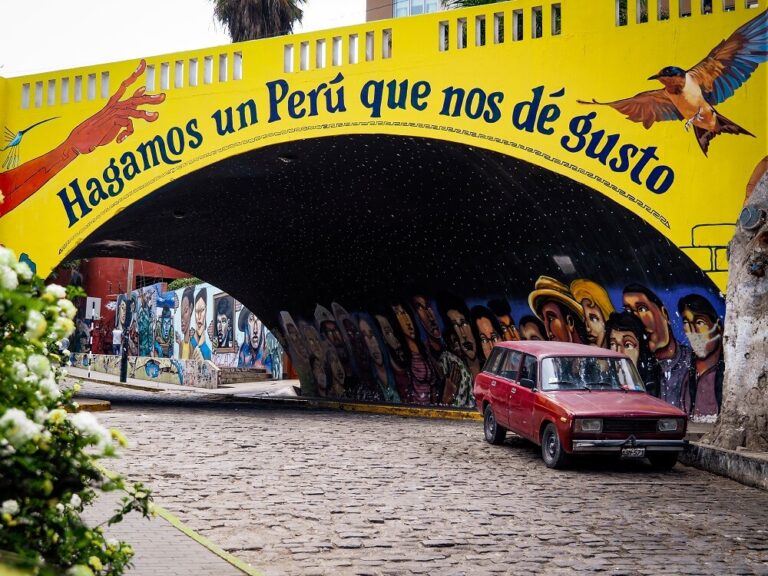
Best Things to Do in the Barranco District of Lima, Peru
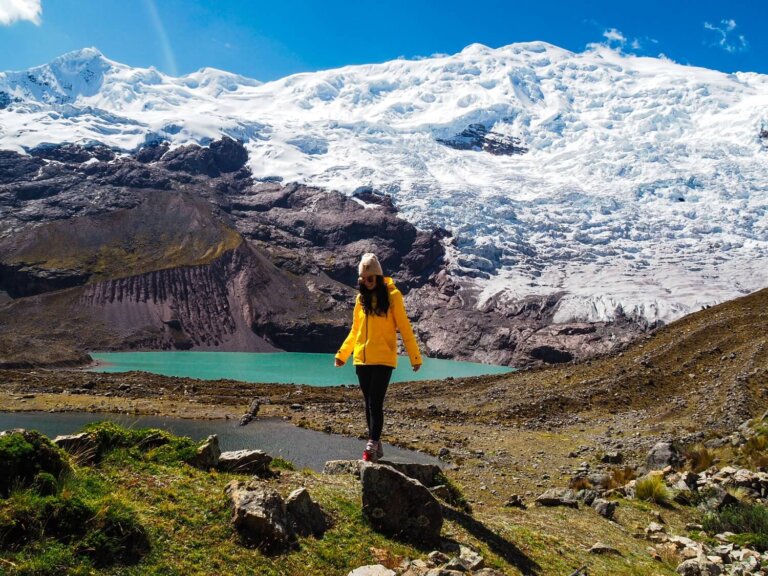
2-Day Ausangate Trek to Rainbow Mountain, Peru – A Complete Hiking Guide
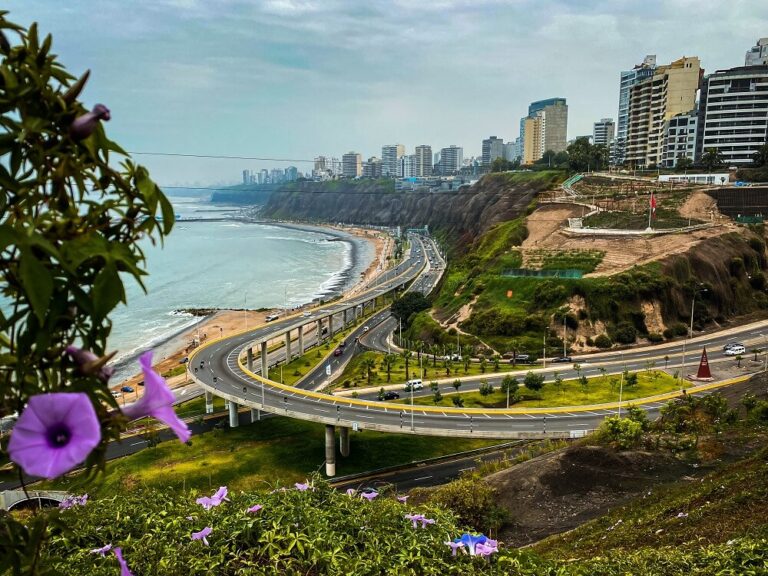
A Guide to Bus Travel Around Peru
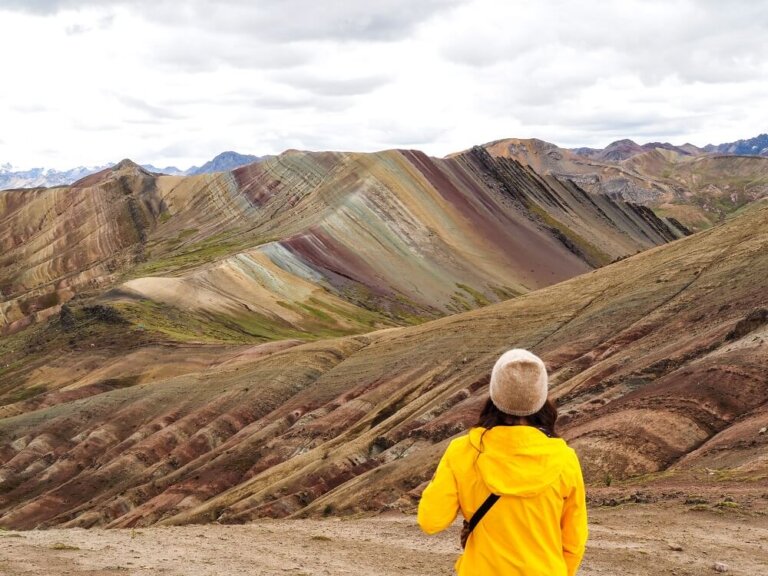
10 Best Day Trips from Cusco, Peru
14 comments.
Peru looks every bit as hilly and dramatic as I imagine it being. The hiking in Colca Canyon might be a little bit advanced for me, but wow what scenery! I’m so glad you didn’t get injured in the earthquake!
Feeling an earthquake while traveling sounds so unsettling! I’m glad you’re okay. Also, I love how in depth your hiking guide is!
Thank you so much. Yes, earthquakes are no joke, but luckily everything was fine at the end!
Peru is really amazing, and even if you don’t want to hike too much, you can just visit the Colca Canyon as part of a day tour.
What an amazing experience and great way to see other parts of Peru. It must have been just lovely.
Thanks Kit, the hike was really a fantastic experience.
I’ve never been to Peru, but Machu Picchu has been on my travel bucket list for a while. I had no idea about the Colca Canyon, despite the difficulty I’d definitely add trek in the Colca Canyon onto my bucket list. Thanks for sharing!
Thank you so much Anna, we’re glad that the Colca Canyon is now on your bucket list too. Hope you can get to Peru in the near future.
This hike looks incredible. And oh my – an earthquake!! I experienced one while traveling in Zapopan in Mexico but not on a hiking trip – yikes! What adventures. Adding this to my bucket list. Very fun read and interesting post with a lot of great information!
Thanks Yvonne. Luckily we didn’t experience any earthquakes when we were in Mexico, but they can be super scary!
I also visited the Colca canyon and it was fantastic. I was recommended to go with an agency since going by myself could be dangerous. After looking for tour options on internet I decided to take Trek The Colca servicies https://trekthecolca.com/
Thanks for your comment Ronny, we’re glad you had a great experience visiting the Colca Canyon. We went with a guide too and it was definitely a great decision.
Loved this blog and I’m looking into booking this trek. Please can you advise on how much it cost you? Many thanks,
Thank you for your comment. The 3-day trek via Llahuar can cost anywhere between $250-$350 depending on who you book it with. We booked it with Peruhike, but you can also complete this trek without a guide and just book your own accommodation and use colectivos to get to the trailhead. That will probably be cheaper than a guided hike. Hope this helps.
Leave a Reply Cancel reply
Your email address will not be published. Required fields are marked *
Coming soon…
We’re currently traveling Mexico.
via Booking.com
Colca Canyon Guide 2024: Hiking One of the Deepest Canyons
Home › Destinations › South America › Peru
Written by Laura & Jens , two full-time travel bloggers on a world trip. Here to inspire you with our stories.
In south of Peru, about 160 kilometers northwest of the city of Arequipa, lies the Colca Canyon – one of the deepest canyons in the world. It reaches a depth of unbelievable 3,400 meters (11,155 feet) and is almost twice as deep as the Great Canyon in the USA.
The Colca Canyon is also one of the best places in Peru to see the majestic Condors soaring over the mountains as well as to admire the incredible art of farming terraces dating back to pre-Incan times.
In our comprehensive Colca Canyon Guide we have outlined what Colca Canyon has to offer, which treks are best for your hiking trip, how to get there and much more.
What to expect in the Colca Canyon?
The Colca Canyon is a quite popular destination for people traveling around Arequipa. There are plenty of things to do in and around the Colca Canyon, such as hiking, rafting, mountain biking and much more.
For us, the Colca Canyon is still an off-the beaten path destination,. We’ve met a lot of travelers during our Peru trip, that skipped it due to time constrains or because they flew directly from Lima to Cusco without touching base in Arequipa.
With this guide we want to tell you why its definitely worth visiting the Colca Canyon and equip you with everything you need to know to get your journey started.
Watch our Insta Reel
Check out our reel for this post and follow us on our journey.
1. The Colca Canyon
Colca Canyon, no surprise, is the star attraction in the area. Some say it’s the second deepest canyon in the world, while others say it’s the fourth. Either way, at over 3,400 meters (11,200 feet) deep, it’s breathtaking. During your trip, you will most probably explore the beginning of the canyon, having only 1,100 meters (3,600 feet) of depth, but nevertheless, the view is stunning.
You can soak in the dramatic beauty of the canyon from several viewpoints, however, the Colca Canyon is best explored on foot. There are many awesome trails to explore, most of them being multi-day hikes. Due to the significant variation in altitude, the Colca Canyon encloses diverse ecosystems and microclimates. We were amazed, how as we were descending into the canyon, we experienced remarkable shifts in temperature and vegetation. And there is even a small green oasis Sangalle down there, where you can enjoy some hot springs.
So if you’re up for a little challenge, Colca canyon is one of the rewarding hikes in Peru. Read more about the different treks in the Colca Canyon in the section “How to hike the Colca Canyon?” .
To visit the Colca Canyon, you have to purchase a 70 PEN (≈ 19 USD) entrance ticket at a checkpoint. Remember to bring cash as you cannot pay by card. Keep this ticket with you at all times because park authorities request to see it at different checkpoints during your visit.
2. Graceful Andean Condors
The Colca Canyon is a famous destination for seeing Andean condors gracefully gliding above the cliffs from short distance. Andean condors are one of the largest flying birds in the world. Their wingspan can reach up to 3 meters (10 feet), so no wonder they are also called the King of the Andes.
There are several viewpoints along the canyon’s edge, such as Cruz del Cóndor, where you can observe these majestic birds. The most important thing to consider to see the condors is not the season or the weather, as they can be spotted throughout the year, but rather the time of day.
The best time to see Andean condors is in the morning, between 8 a.m. and 10 a.m. as they take flight from their cliffside nests. During the dry season you might also spot these birds in the afternoon between 3:30 p.m. and 4:30 p.m.
We did not have to wait long until these colossal birds emerged. The first sight of them, silhouetted against the blue sky, was simply incredible. As they circled overhead, casting a giant shadow over the ground, their black feathers glistened in the sunlight. And here’s an interesting fact. Did you know that condors actually don’t fly but soar on rising thermal currents? So in case you want to witness these fables birds effortlessly gliding yourself, visiting the Colca Canyon is a must.
To visit the most popular viewpoint Cruz del Cóndor to observe the Andean condor you will have to pay the entrance fee to the Colca Canyon of 70 PEN (≈ 19 USD).
3. Stunning Agricultural Terraces
The agricultural terraces in Colca Canyon, known as “andenes” in Spanish, represent a traditional farming method that indigenous people in the mountains have used for centuries.
This pre-Incan and Incan agricultural technique involves building stone walls to create flat platforms on the steep canyon slopes for cultivating various crops like maize, quinoa, and potatoes in the challenging terrain. This is also how the Peruvians have evolved potatoes into a wide range of shapes, sizes, colors, and flavors – a total of an astonishing 4,000 different varieties of potatoes!
It’s not a coincidence that the name of the mountain range “Andes” comes from this ancient method. These landscapes are truly unique and are definitely worth a visit in the Colca Canyon.
Try some Colca Sour – the local version of the Pisco Sour, having a special ingredient – a cactus fruit. Interestingly, it tastes like Kiwi. If you would rather prefer an non-alcoholic option, also the cactus fruit juice is yummy.
4. Hot Springs
In Colca Canyon, you’ll find natural hot springs, such as La Calera and La Calera de Chivay. The mineral-rich waters of these hot springs are believed to have therapeutic properties, offering relief from muscle aches and joint pains. This makes it a perfect place to rest from your strenuous hike, relaxing and enjoying the amazing scenery.
The entrance to the hot springs costs 15 PEN (≈ 4 USD) per person. There are several pools of varying temperatures, allowing you to choose the one that suits you best.
5. Lamas, Alpacas and Vicuñas in the Aguanda Blanca National Reserve
On your way to the Colca Canyon you will pass the Salinas and Aguada Blanca National Reserve. The reserve is known for being home to various species of wildlife, including vicuñas, a wild relative of the llama and alpaca.
Vicu ñas were once critically endangered due to hunting for their valuable fine wool but, luckily, thanks to the conservation efforts within the reserve the numbers have gone up.
If you are interested in seeing the vicuñas in the wild, this is probably the best place to go. It was absolutely magical to see them grazing and galloping on the high-altitude plateaus and puna grasslands, as we were driving through the national reserve.
6. Volcano Viewpoint
On the road between the Colca Canyon and Arequipa, there are several viewpoints, such as Mirador de los Andes, providing panoramic views of some of the most impressive volcanoes in the region.
You can see volcanoes such as Misti, Chachani, Ubinas, Ampato and Sancancaya (this one is currently active and with a bit of luck you could even see it erupting). The viewpoint is almost at 5,000 meters (16,404 feet) above the sea level, therefore, be aware of any signs of altitude sickness and bring some medicine or coca leaves to mitigate the symptoms.
How to visit the Colca Canyon from Arequipa?
After reading and researching about how to easily get to the Colca Canyon, we went with the most convenient option – booking a tour. At that time, we didn’t want to worry about transportation, guidance through the trails and meals. And as prices were really affordable there wasn’t a real reason why not to go by a tour.
Nonetheless, there are several options to get to the Colca Canyon, in case you’d prefer doing it on your own. So to ease your travels, we’ve listed all of the different way to get to the Colca Canyon.
Relevant Reading
1. Colca Canyon with a Guided Tour
You can choose from single-day excursions to multi-day treks that cover all the main attractions outlined in the previous chapter. While a one-day tour from Arequipa to Colca Canyon may seem appealing, we do not believe it is the best option. The reason is that it’s about a 3-hour drive from Arequipa to the Colca Canyon, which means you’d spend most of your time on a bus. Moreover, the true beauty of Colca Canyon is best experienced on foot. Due to the steep slopes, exploring its depths of the canyon requires at least one day. Therefore, depending on your travel plans, budget and physical fitness, we’d recommend booking a 2- or 3-day-tour to the Colca Canyon.
Recommended Tour
Expect to pay for the tours around 35 USD per day. If you decide to book last minute when in Arequipa, you can get the tour a bit cheaper. Keep in mind that the entrance fee to the Colca Canyon needs to be paid separately, which is 70 PEN (≈ 19 USD). Take some cash with you, as they don’t accept any cards at the checkpoint.
2. Colca Canyon by Collectivo
In case you haven’t heard about Collectivos before: Collectivos are small vans with 8-12 seats, and they usually leave once full. The advantage of taking a collectivo instead of a bus is that they usually drive the route faster.
The collectivos to Chivay can be found at several bus stops in Arequipa, around Avenida Andrés Avelino Cáceres. Just ask people on the street and they will point you to the right direction. The buses usually start operation at 5 am and leave hourly, or when full. Therefore, be prepared to wait in case there are not enough people.
A ticket costs 20 PEN (≈ 5 USD) per person, with a travel time of 3,5 hours.
Once in Chivay, you will have to take another colectivo to Cabanaconde. You will find the colectivos waiting outside of the terminal. They have scheduled their departures based on the buses and colectivos arriving from Arequipa, however, as usual, they leave once full.
The ticket costs 10 PEN (≈ 3 USD) and the journey takes 1,5-2 hours.
If you’re planning to start your hike right away towards San Juan de Chuccho, ask your driver to drop you off at Mirador San Miguel which is the starting point for the trek down into the canyon. In that way you save a 20-minute walk from the Cabanaconde.
3. Colca Canyon by Bus
You can also take a bus to Cabanaconde from Terminal Terrestre in Arequipa. The bus usually stops in Chivay for about ten minutes. It picks up new passengers and lets current ones go to the bathroom.
The route takes 5-6 hours and costs around 25 PEN (≈ 7 USD). You can check the bus schedules and ticket prices online or at the Bus Terminal in Arequipa.
4. Colca Canyon by Shuttle Service
Some tour operators agree to give you a lift to Cabanaconde. This means you will join their tour for the first part. You will be picked up from your hostel in Arequipa between 3.00-3.30 a.m., have a breakfast in Chivay, enjoy the Condors at Cruz del Condor viewpoint and be dropped off in Cabanaconde around 9.30 a.m.
This option, although a bit more costly than the alternatives, definitely is the most convenient way to travel to Cabanaconde independently.
Where to stay in the Colca Canyon?
If you want to spend a night or two in the Colca Canyon, you have several options where to stay.
Cabanacone is a small village next to the trailhead into the Colca Canyon. There are some hostels, guesthouses and small hotels, making it a convenient base for trekkers. You can book your accommodations online or once you get there.
Another option would be to stay in one of the villages down the canyon, such as in San Juan de Chucco, Sangalle or Llahuar. There you can choose from dorms and private rooms or ask to camp. Just make sure to get in contact with the property before you start your hike. While post-pandemic way less tourists find their way into the canyon, you still want to make sure you have a place to stay (especially during the high season from June to August).
Some lodges we would recommend are the Colibri Lodge in San Juan de Chico, the Paradise Las Palmeras Lodge in Sangalle and Casa Virginia in Paclla.
How to hike the Colca Canyon?
The treks from Cabanaconde in the Colca Canyon range from a single-day hike to multi-day expeditions. The best route and duration depends on your preferences and fitness level.
Here we have listed some of the most common treks.
Before your Colca Canyon Trek make sure to get used to the high altitude. The canyon is part of the Andes Mountains, and it goes from about 2,100 meters (6,890 feet) above the sea level at the bottom to around 4,160 meters (13,648 feet) at the highest points on the rim.
2-Day-Trek: Cabanaconde to Sangalle
This short hike having total of 11 km (7 miles) is a great option for those who are short on time or look for an easy trek in the canyon.
On the first day you will descend about 2 hours into the canyon and can relax at the pools in the oasis of Sangalle for the rest of the day. On the next morning you will ascend via the same zig-zag route back to Cabanaconde.
2-3-Days-Trek: Cabanaconde to San Juan de Chuccho and Sangalle
This roundtrip trek of about 20 km (12 miles) is the most popular one that is also offered by most tour operators.
On the first day you will walk about 10 km (6 miles) down to San Juan de Chuccho and after lunch you will continue 5 km (3 miles) to the Sangalle oasis where you’ll spend the night. On the second day, you will ascend the canyon to Cabanaconde.
This was the route we completed and it was perfect for us. It was the right length and 2 days was enough to fully appreciate the beauty of the Colca Canyon.
We have also read that doing this route in reverse and staying at San Juan de Chuccho instead of Sangalle may be easier on your knees as the ascent is not so steep. Only few tour operators offer this route, but it’s a great option when hiking solo.
For a more relaxed itinerary, you can also choose to spend an additional night in the Sangalle oasis or San Juan de Chucco respectively. While for us one night in Sangalle was totally fine, we’re sure your knees will thank you.
2-3-Days-Trek: Cabanaconde to Llahuar and Sangalle
This circular trail along the western side of the Colca Canyon is about 28 km (17 miles) long and can be done in 2 days, but we recommend taking 3 days for a more relaxed experience.
The trek from Cabanaconde to Llahuar involves a steep 11 km (7 miles) descent. Returning to Cabanaconde via Sangalle on the second day – a total of 17 km (11 miles) plus the steep ascend out of the canyon – would make for a long and strenuous hike.
Therefore, you might not catch the bus back to Arequipa and have to stay overnight in Cabanaconde. Opting for a 3-day trek would allow for a more leisurely pace and provides the opportunity to get back to Arequipa on the same day.
3-Days-Trek: Cabanaconde to Llahuar and San Juan de Chuccho
This 3-day Colca Canyon trek covers most of the routes in a loop of about 30 km (19 miles) and, thus, is the most challenging one.
When taking this trek, we would recommend to do the route clockwise, heading to Llahuar first, to have an easier ascent on the last day from San Juan de Chuccho to Cabanaconde.
Note that this route doesn’t include the Sangalle oasis but you will have great views over it along the route.
The trail length from Cabanaconde to Llahuar is about 11 km (7 miles) and it includes lots of switchbacks, so if you plan to do the route other way around, you should plan 6-8 hours for the last day and start around 5 a.m. to catch the bus back to Arequipa.
It is possible to take a bus from Llahuar back up to Cabanaconde on the last day instead of walking the trail, should your legs give up on you.
Is it safe to hike in the Colca Canyon?
The treks in the Colca Canyon are easy to follow and quite popular, which makes hiking in the area generally safe. There is no cell reception in the canyon, but there are several towns along the way where you can seek assistance if needed.
However, watch your steps! The slopes are steep and there are many small loose rocks on the trail. This is why we recommend wearing a sturdy pair of hiking boots for a more secure and enjoyable hiking experience.
Is hiking the Colca Canyon hard?
Hiking through Colca Canyon, one of the deepest canyons in the world, is undoubtedly a rewarding but also challenging experience. Climbing the canyon’s steep walls, first descending and then ascending, should by no means be underestimated. And to be honest, it demands at least a moderate level of fitness not to only tackle the trek but also the hike uphill not to be a total nightmare.
However, even more you will need a strong mindset which keeps you going even if your legs start shaking and you are running out of breath (due to the high altitude). In that case, just keep going slow and steady, even if just with the smallest steps and you will make it.
When booking a guided trek through a tour operator, there’s often a tight schedule to reach the canyon’s rim in time for continuing the tour, requiring you to ascend 1,100 meters (3,609 feet) in just under 3.5 hours. If you are trekking independently, you have the advantage of setting your own pace, which can make the hike less strenuous.
The great news, however, is that there’s an alternative if your feet should give out on you. You can choose to ride a mule on your way up. Also, from the road before Llahuar there is even a bus up to Cabanconde. This flexibility ensures that hikers of varying abilities can enjoy the breathtaking beauty of the Colca Canyon.
What to pack for the Colca Canyon trek?
We have prepared a compact packing list for your trip to the Colca Canyon. Whereas it is essential to bring enough water and sun protection, also don’t forget your swimsuit in case you would like to jump into the hot springs. We recommend dressing in layers as the weather can be unpredictable, with hot sun and strong winds being both very probable.
- Travel Insurance
- Cash (Entrance Fee)
- First Aid Kit
- Mid-Sized Backpack
- Sunscreen, Bug Spray
- Sunglasses, Hat
- Jacket (Waterproof)
- Water, Snacks
- Headlamp, Torch
Nice to Haves
- Swimwear, Towel
- Sweatshirt or Fleece
- Hiking Poles
- Camera, Powerbank
Hiking boots | Although we have seen people doing the hike with plain sneakers, trust us, you will feel yourself so much safer wearing hiking boots with good profile. There are many small loose stones on the track.
Layers of clothes | Besides comfortable long trousers, we recommend to layer up on the top. When the sun shines it gets really warm, however, at higher altitudes the temperatures drop and as soon the sun hides.
Waterproof jacket/rain poncho | In the mountains rain can show up unexpectedly. Even during the dry season. Therefore, be sure to pack a waterproof jacket or a rain poncho into your backpack.
Cap / Sunglasses | There are no trees to provide you shade during your ascend or descend in the Colca Canyon, therefore, wearing a hat is a good idea.
Gloves and a warm hat | Especially in case you are travelling during Peruvian summer, take some warm accessories with you. You might not need them during your hike but the evenings and mornings are quite chilly.
Extra socks and trousers | This is optional for those who travel during the rainy season. On the last day, after the hike, you will still have around 6 hours of bus ride to get back to Arequipa. It’s better to have some change clothes to not catch cold during your tour.
Water | It is essential to stay hydrated during your hike. We recommend to take 2-3 liters per person with you for the first day. You can buy water along the way, in the small villages, but expect the prices to be higher. Unfortunately, in the places where we stayed, they did not offer any filtered water, so in case you have a filter bottle, bring it. It is also a good idea to bring an electrolyte beverage with you.
Snacks | Whereas the tours include 3 meals a day and there are several restaurants in the villages for people who are traveling independently, you still might want to bring some snacks (also, during our tour, we had the breakfast on the second day only after having ascended the canyon). Best snacks at high altitude are ones rich in carbohydrates. For extra energy, bring some chocolate/muesli bars, nuts, dried fruits, bananas, or nut butter.
Sunscreen | The sun in the Colca Canyon can be very intense, so make sure to bring enough sunscreen
Bug spray | We did not have a problem with mosquitos during our tour, but it does not hurt to take it with you just in case. We heard from others being bitten as they were relaxing at the pool.
First Aid Kit | Let’s hope you won’t need it, but it’s better to be safe than sorry. Having some band aids and disinfectant with you is always a good idea.
Cash | There is no ATM in Cabanaconde, so make sure to bring enough cash with you for the whole trip. In case you are travelling independently, expect to pay for all your meals and accommodations in cash. Also, you will have to pay for the entrance ticket to the Colca Canyon (70 soles per person) and bring some extra, in case you would like to enjoy the hot springs (15 soles).
Powerbank | Not only will you want to ensure you will have enough battery to take amazing pictures but also in case you want to use a hiking app like AllTrails, possibility to charge your phone is a must, especially as not all the accommodations have electricity in the room.
Hiking poles | Optional but recommended in case you have knee problems. This trek has some uneven ground and higher steps.
Towel | Don’t expect the accommodations in the Colca Canyon to provide towels, so bring a light travel towel with you just in case
Swimsuit & flip-flops | Optional in case you want to relax in the hot springs
Head torch | In case you might want to start hiking before the sunrise, you will need a head torch to light your way.
Best time to visit the Colca Canyon?
The best time to visit Colca Canyon is during the dry season (May to November). These months offer clear skies and more comfortable temperatures for exploring the canyon, and higher chances to spot condors. However, the temperatures drop significantly during the night, so pack a few warmer pieces of clothes. Also, expect more tourists to travel during the high season (June to August) and the trails can get crowded.
The wet season in Colca Canyon is typically from December to April. During this period, you can expect more rainfall, which can affect trail conditions and visibility. While the landscape becomes lush, the trails may be muddier and slippier, sometimes even closed. We would still recommend going in November, as we had no rainfalls at all, the temperatures were pleasant and there were less tourists on the road. If you want to be safe, though, it’s better to plan your visit during the dry season.
Travel Time
Is it worth hiking the Colca Canyon?
Colca Canyon treks are among the most popular hiking routes in Peru, and for good reason. The canyon’s breathtaking views and challenging terrain make for an unforgettable experience.
The sense of accomplishment that comes with conquering the cliffs is unmatched. And even if you don’t make it to the top on your own two feet, you can be proud of yourself for even attempting the hike. The views from the Colca Canyon are simply spectacular, and they are the greatest reward for all the hard work you put into the hike.
This post includes affiliate links. We earn a small commission if you make a purchase through our links. It doesn’t cost you more, but helps us to keep the blog up and running.
Looking for more Peru articles?
You will find plenty more Guides, Travel Tips and Stories in our Peru articles section.
We’re Laura and Jens , two curious adventurers travelling the world full-time. Through our travel blog, we want to inspire and guide you to embark on your own unforgettable journey.
Comments are moderated. By submitting a comment you agree to our privacy policy . Your email will not be published.
© 2024 Along Sandy Beaches – All rights reserved. Travel Blog built with ♥︎ by Jens & Laura . Privacy Policy – Sitemap
Hike | Arequipa | Peru
3-day colca canyon trek hiking guide (self-guided), text | anninka kraus photography | tobias kraus.

One of our favourite memories of Peru is the three-day/two-night hike into the Colca Canyon – Cañon de Colca in Spanish – one of the world’s deepest canyons. Located 220km northwest of Arequipa, the Colca Canyon is easily accessible (it’s still a long drive from Arequipa) and equally suitable for self-guided hikers and those preferring a guided or group hike experience.
After hiking in the famous Grand Canyon in Arizona just a few months earlier, we weren’t sure whether the much deeper Colca Canyon would measure up in terms of scenery. But it sure does. Like the Grand Canyon, the Colca Canyon is stunningly beautiful, albeit in a slightly different way. Both canyons are arid, but the Colca Canyon seems less so, almost lush by comparison really, as locals still cultivate the stepped terraces, growing corn and avocado.
And whereas the Grand Canyon seems to be this desolate, uninhabited wilderness (there’s only one remaining tribal village in Grand Canyon National Park, inhabited by the Havasupai people), the Colca Canyon is home to several communities allowing hikers an insight into rural Peruvian everyday life.
Hiking in the Colca Canyon is also a different experience from hiking in the Grand Canyon and much more comfortable. Instead of very basic campsites, the Colca Canyon boasts lovely guest houses with hot showers, beautiful home-cooked meals, and thermal baths.
Both canyons did have one thing in common, however, and that was the lack of wildlife. Maybe we were just unlucky because there were actually plenty of alpacas roaming the high plains on the drive to Cabanaconde. But once we started hiking, the only wildlife we saw over the three days was a couple of small birds. If you‘re lucky, though, you might see Andean condors soaring above the canyon. We didn’t, but plenty of people join day tours from Arequipa to two lookout points on the rim of the canyon specifically to see condors.
Contrary to some online accounts we’ve read, we believe hiking the Colca Canyon is pretty straightforward and easily doable self-guided for experienced hikers (if you download gpx files for offline use). You could almost get away with carrying a small day pack actually. Of course, this being a canyon with a 1600m elevation difference between the rim and the canyon floor on day 1, you obviously need to pack some warm clothes. But with comfortable accommodation options available in several places, you’ll hardly need to pack anything else at all. You’ll also frequently pass through small communities as you walk through the canyon along the Rio Colca, with plenty of opportunities to stock up on snacks and drinks.
The only aspect of this hike that might require a little thought and planning is choosing the transport options between Arequipa and Cabanaconde that best fit your needs (see “Where and getting there” in trail details). And don’t forget to download the gpx files of this trek for offline use. There are few trail markers, if any, and navigating the opening stretch, in particular, wasn’t easy, with parts of the trek destroyed by a fire, it appeared.
There are several routes into the canyon, but if you follow this 3-day/2-night circuit itinerary, starting from and finishing in Cabanaconde, you’ll be spending your first night in Llahuar and the second in San Juan de Chuccho. It’s the longest loop you can hike in the canyon, with a total trail distance of 30km. That might not seem like a lot, stretched across 3 days, but there’s a 1000m elevation gain to tackle as well.
Also, with the Colca Canyon located 220km from Arequipa, you need to allow for a 4-6 hour journey to and from the canyon on days 1 and 3 – unless, of course, you stay in Cabanaconde before and after your hike, which I wouldn’t recommend because the scenery inside the canyon is far more special. Gazing up at the sheer rock walls as daylight faded, the light grew softer, and the shadows longer was incredible.
trail info.
Start/End: Cabanaconde (you’ll most likely arrive from and return to Arequipa) Route: Day 1 Cabanaconde – Llahuar Day 2 Llahuar – San Juan de Chuccho Day 3 San Juan de Chuccho – Cabanaconde Distance: 30km total trail distance Time: 3 days (total hiking time incl. small breaks: 10 hours) Difficulty: moderate; but exposed to the weather and steep altitude gain on day 3, from 2395m at the bottom of the canyon to the rim at 3430m. If you hike often, you won’t find this difficult, but someone who doesn’t might struggle with the steep 1000m elevation gain. Options: in addition to this 3-day/2-night Colca Canyon itinerary, there are plenty of other shorter hikes into the canyon. Permits: To hike in the canyon, you apparently need to purchase a 7-day entrance permit for S/.70. We asked at several places in Cabanaconde, but couldn’t find anyone to sell us a permit. Maybe this was because we hiked in low season, I’m not really sure, but we didn’t pass a ranger’s station anywhere either.
1. Laguna 69
Out & back trail | 5-6 hours
2. Santa Cruz Trek
Point-to-point trail | 3 days
3. Inca Trail (guided hike)
Point-to-point trail | 4 days
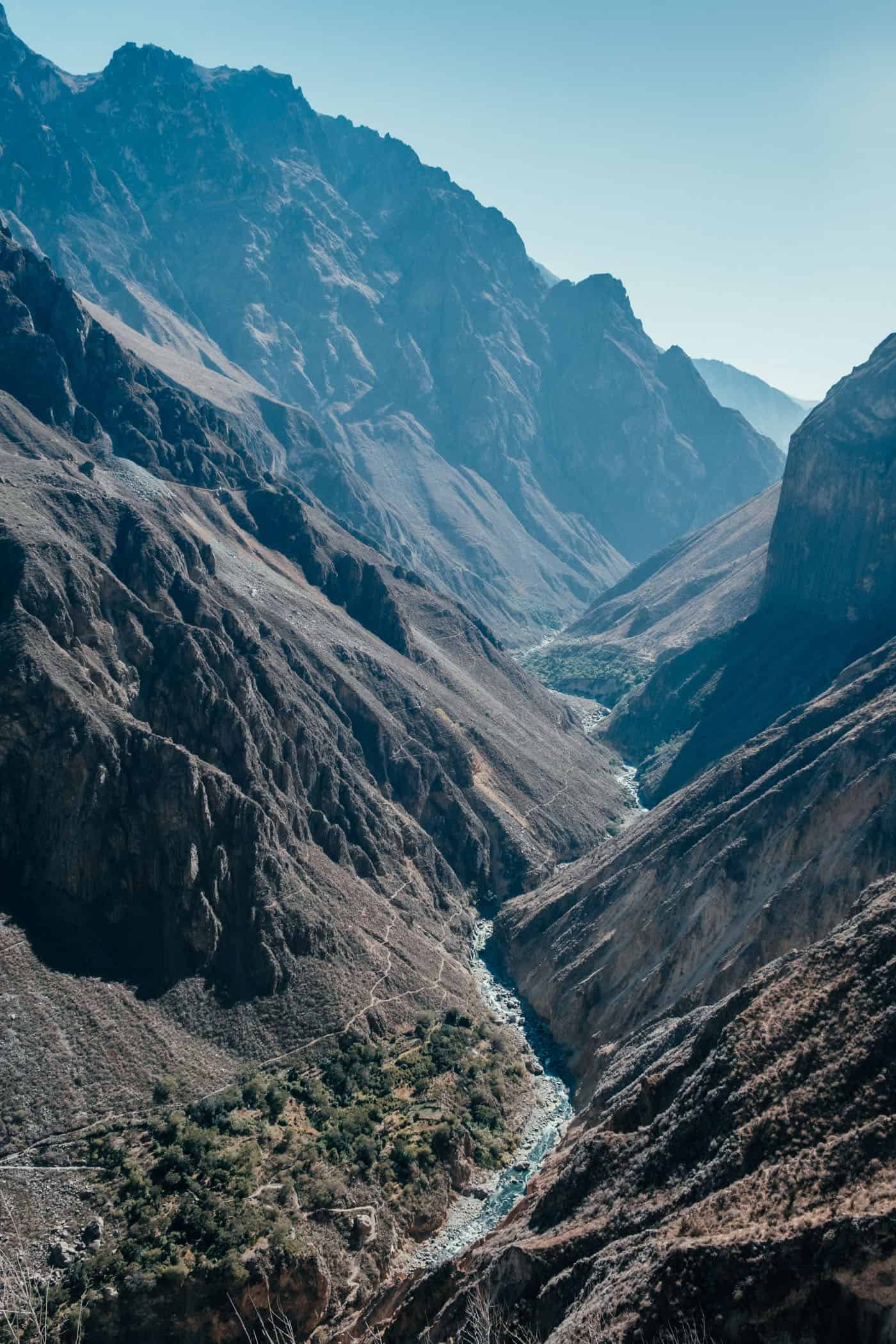
At the very bottom, where the sheer canyon walls meet, the Rio Colca is nestled among lush greenery.
What to expect..
A three-day/two-night hike into one of the world’s deepest canyons
A hike that is equally suitable for self-guided hikers and those preferring a guided or group hike experience
Super comfortable stays in guesthouses with hot showers, beautiful home-cooked meals, and thermal baths
You’ll pass through several local communities, giving you insight into rural Peruvian everyday life
location & trail information.
Where and getting there: Before and after your hike in the Colca Canyon, you’ll probably be staying in Arequipa, 220km from Cabanaconde, which is the start and end point of this hike. To get to Cabanaconde from Arequipa, you can take the bus departing from the Arequipa Bus Terminal or a minivan to Chivay – Transportes Centella, for instance, leaving from Av. Andrés Avelino Cáceres – and then change to a colectivo to Cobanaconde. The same on the way back. We opted for the minivan/colectivo combination because the bus leaves very early and still gets to Cabanaconde late, as it stops at various points along the way. If you take the minivan instead, you can leave at 8 am and still have plenty of time to walk to Llahuar that day. It’s much quicker, and we thought the minivans/colectivos in Chivay were well coordinated. We didn’t have to wait long for one to depart for Cabanaconde or for Arequipa on the way back. Get off the colectivo in the main square – Plaza de Armas – in Cabanaconde and follow the road that runs past Mirador de Achachihua to the starting point of the trek on the outskirts of town. There are very few trail markers at the start of this trek if any, and I doubt we’d have found the trail quickly without using GPS or a map. On day 3, when you climb out of the canyon from San Juan de Chuccho, you’ll meet a road where you need to turn right, towards Cabanaconde. It’s a 20-minute walk on the road into town where colectivos for Chivay depart from the main square.
Where to eat: Breakfast is included in the room price at both hotels we stayed at and was very nice; they also serve dinner (vegetarian option available) and cold drinks; throughout the day, you can stock up on snacks and drinks at small kiosks along the way.
When to go: In the dry season – May to October – when there’s little chance of rain. Nights are colder at that time though and it’s peak season so you might have to book accommodation further in advance. I wouldn’t want to hike this trek in the rainy season, especially the slippery, steep downhill sections, but if that’s when you’re going, taking hiking poles will be useful.
How to prepare: You need to be reasonably fit and well-acclimatized to higher altitudes before attempting to hike to the Colca Canyon Trek. Spending at least 1-2 nights in Arequipa at 2335m will help you acclimatize and make your hike more enjoyable. Book your accommodation online . At Llahuar, there are only two hotels, so you definitely want to book ahead. Take warm clothes, as nights might be cold and swimwear if you think you might want to jump into the hot pools in Llahuar. Take only a small daypack/backpack and leave the rest of your luggage at your hotel in Arequipa.
Cabanaconde - Llahuar
On day 1, you’ll pass through some farmland just outside Cabanaconde with great views from the rim into the canyon, before the trail starts zig-zagging downhill, rather steeply in some places. Taking hiking poles will help on the slippery bits with lots of loose gravel and sand.
Once you’ve reached the canyon floor and crossed a bridge to the other side of the Rio Colca, you’ll soon after arrive in Llahuar. It’s a tiny place with just two hotels, but both serve dinner and have beautiful gardens with fantastic river views.
track details.
Start: Cabanaconde End: Llahuar Distance: 9.6km Time: 3.5 hours Elevation gain: 430m / loss: 1610m (lowest point: 2110m / highest point: 3290m) Difficulty: easy – moderate
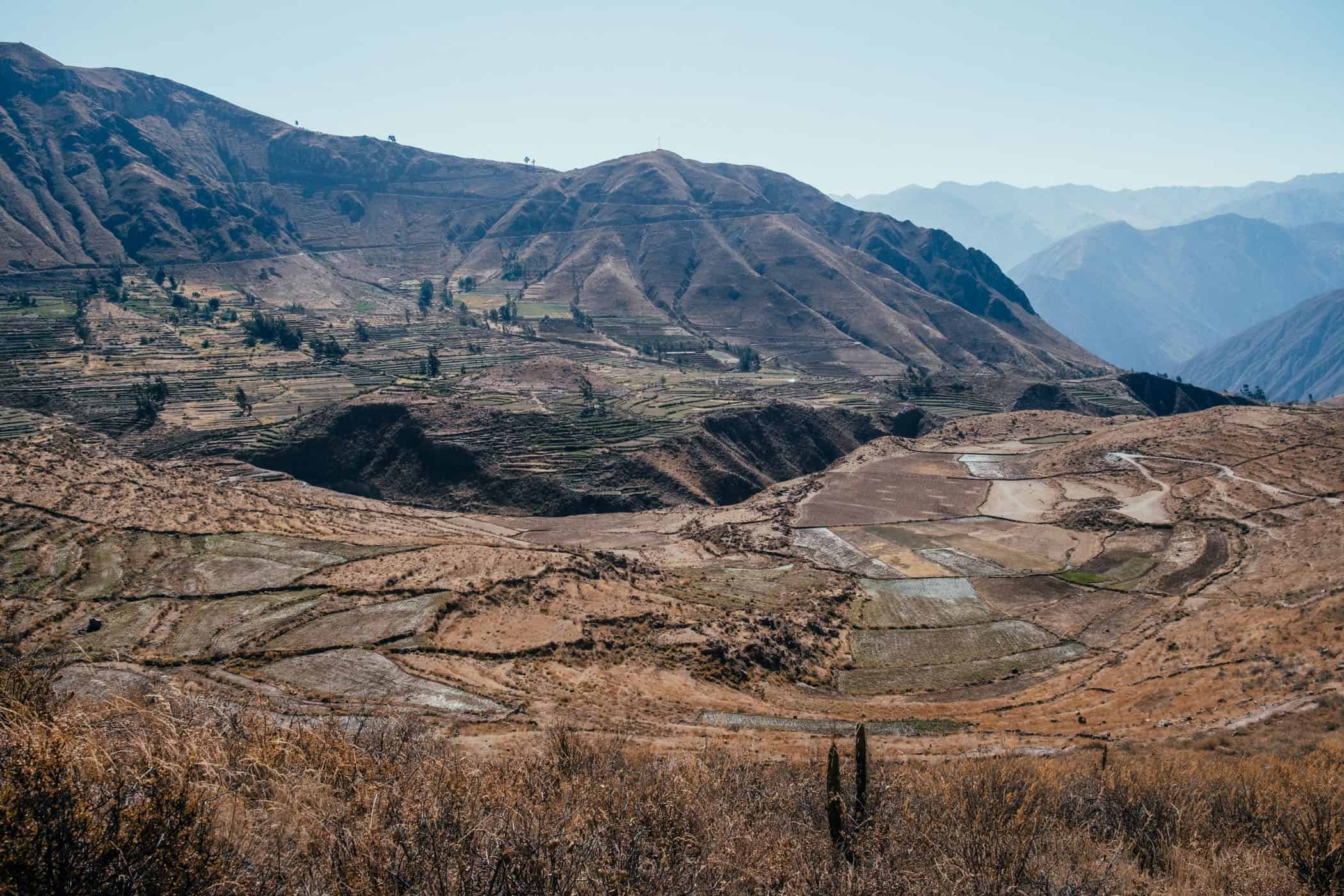
Colca Canyon Trek map - day 1
Llahuar - san juan de chuccho.
Day 2 for us was a lovely, leisurely walk through the canyon. We were in no rush and stopped often to take photos and soak up the views, because it was such a short day hiking.
Even with all the breaks, we arrived in San Juan de Chuccho by noon and spent all afternoon on the balcony sipping mango juice. If you’re keen to cover some extra distance, maybe add a side trip to Sangalle – nicknamed the “Oasis”.
It seems to be the most popular spot inside the canyon with most guided groups spending the night there. We had thought about visiting Sangalle, but then skipped it because the reviews of the hotels there didn’t seem too promising and there’s not much to do unless you stay the night.
Start: Llahuar End: San Juan de Chuccho Distance: 12.3km Time: 4 hours Elevation gain: 840m / loss: 515m (lowest point: 2110m / highest point: 2815m) Difficulty: easy
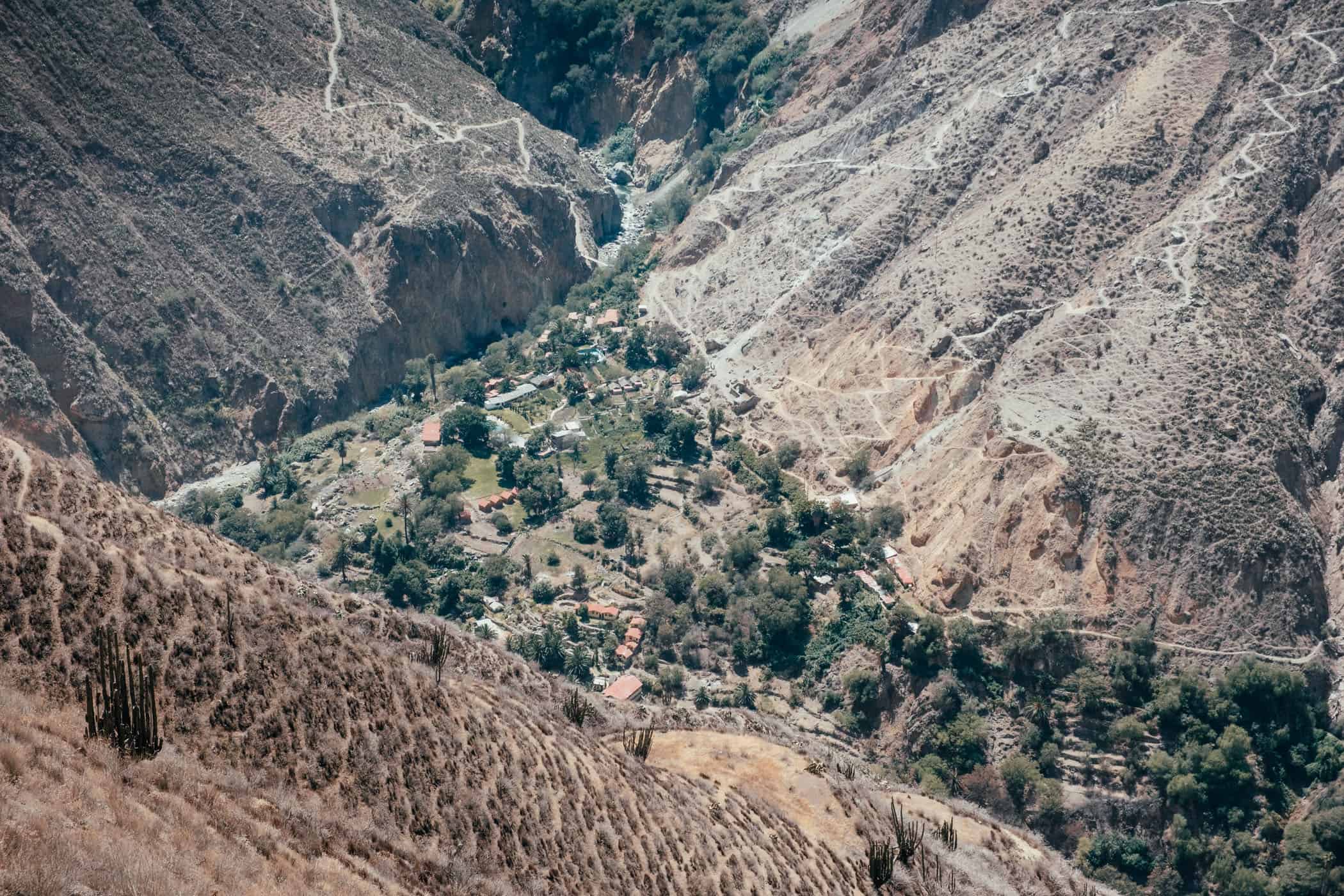
Colca Canyon Trek map - day 2
San juan de chuccho - cabanaconde.
Day 3 is the most physically challenging as the trail gains 1000m in elevation to the rim. There’s not much else to say really – it’s a relentless, steep uphill climb for 2-4 hours, depending on your level of fitness.
The views are still splendid, however, and if you hike regularly and are well-acclimatized to higher altitudes, you won’t find this too challenging. Stock up on all the water you need in San Juan de Chuccho because you won’t be passing any streams on the way up.
Start: San Juan de Chuccho End: Cabanaconde Distance: 7.9km Time: 2.5 hours Elevation gain: 1090m / loss: 215m (lowest point: 2395m / highest point: 3430m) Difficulty: moderate – difficult
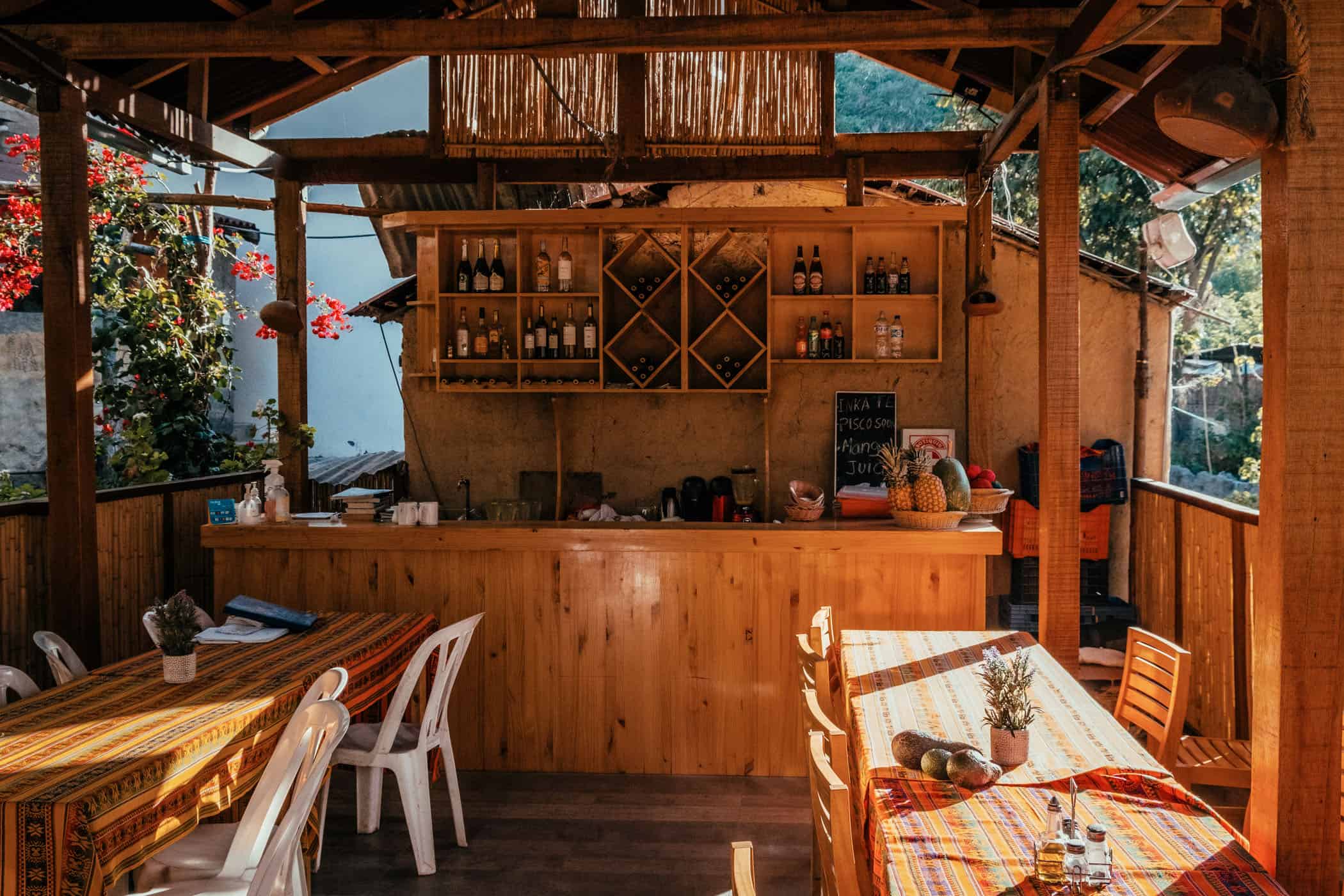
Colca Canyon Trek map - day 3
Visiting denali state park and hiking the curry ridge trail, delicate arch hike in arches national park, devils garden trail with landscape arch (full circuit).

Colca Canyon 2-Day Trek: Guide To Arequipa’s Best Hike
Not sure how to do the Colca Canyon trek? Worry not.
Colca Canyon, the second deepest canyon in the entire world , is one of the best places to visit in Peru. At a depth of 3270m deep, it is twice the depth of the Grand Canyon in the United States. However, most travelers come to Peru strictly for Machu Picchu, completely ignoring the fact that one of Peru’s best hikes is just a bus ride away. Don’t skip Colca Canyon. In our guide, we will give you all the information you need to determine whether hiking Colca Canyon is worth it, where to find tours, what you need to pack, and lastly, our experience doing the 2 day Colca Canyon trek !
Is Colca Canyon Worth Hiking?

Before you take out your credit card or run to the nearest tour agency to book your Colca Canyon hike, is Colca Canyon even worth the visit?
The answer is an unquestionable YES! (That is why I wrote this guide to be fair!)
Hiking Colca Canyon is one of the best things to do in Peru , as it allows you to experience some of the most gorgeous mountainous landscapes of Peru. Its depth, at twice that of Grand Canyon’s, is absolutely unworldly.
Not only that, but hikers can also see the condors with their own eyes, a type of bird that is sacred to the Incans. They believe that condors are messengers of the skies or Heaven.
Hiking Colca Canyon is both a cultural and physical experience that must not be missed in Peru!
Guide To Colca Canyon 2-Day Tour
The map above is the route that all 2 days 1 night Colca Canyon trekking tour takes. It starts close to Cabanaconde, heads down towards San Juan De Chuccho for lunch, then finally to Sangalle Oasis for the first day . On the second day, you return back to Cabanaconde through a different route.
The 3-day 2-night tour also takes the same route, but you stop at Sangalle Oasis on the second day instead of the first.
Trekking Colca Canyon Tour Companies

The 3 days 2 nights Colca Canyon tour stops at all the same places as the 2-day 1-night tour, but the days are much shorter and you will have more chances to enjoy nature in Colca Canyon.
You will still visit Yanque, the hot spinrgs, and the Mirador Cruz del Condor. It is highly recommended if you are a beginner hiker or have a few weeks in Peru !
Want to secure your Colca Canyon tour before you arrive? Here are some tours we recommend:
- Colca Canyon day tour
- Colca Canyon 2 day tour
- Colca Canyon 3 day tour
DIY Your Colca Canyon Trek
We didn’t do the Colca Canyon trek on our own so we can only give an outside point of view. It seems it is fairly easy to DIY as long as you know the routes. The accommodations along the route can be easily booked in advance on booking.com .
However, we recommend having at least some experience with hiking in remote areas, as well as a high level of Spanish because no one will speak English out there. You will also need to brave the unreliable Peruvian public transportation, especially in those regions.
If you are planning on doing the Colca Canyon trek yourself, we recommend that you install offline maps from maps.me and Alltrails.
Colca Canyon Trek Packing List
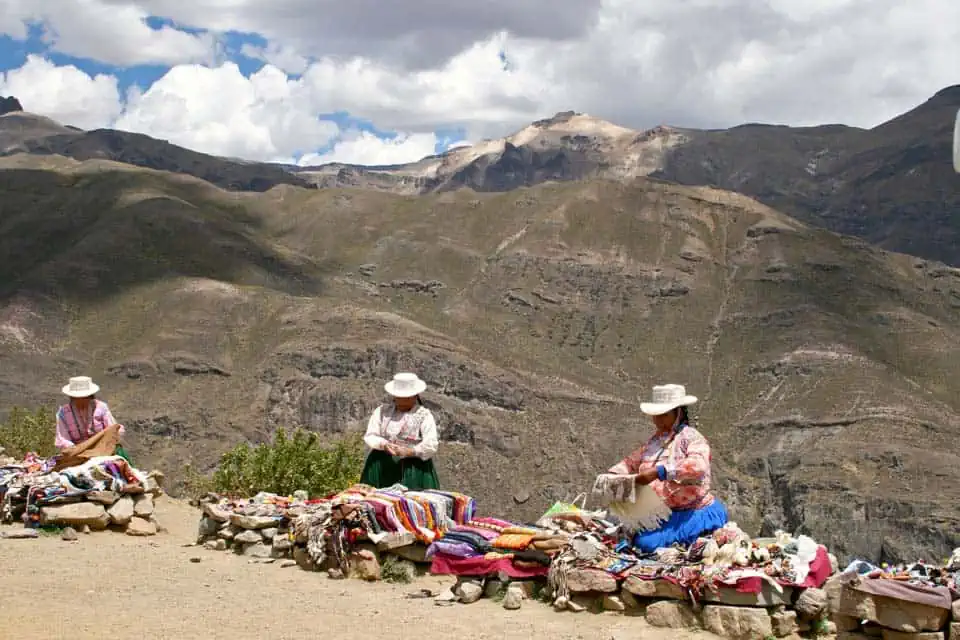
The Colca Canyon hike is not so tough in terms of difficulty (at least that’s what we thought). However, if you are doing the 2 days 1-night trek, you will suffer extreme sunny conditions on the first day and extremely cold conditions on the morning of the second day.
Therefore, I recommend packing some of these essentials:
- Sunscreen – You will be hiking in the sun for about 6 hours in the sun with no shade. Bring one or look like a tomato.
- Toiletries – Make sure you have toilet paper. It is not provided by the accommodation.
- Swimsuit – There is a swimming pool in the Sangalle Oasis where you can swim after your first day of hiking.
- Cash – There are places to buy water and snacks on the hiking trail. Also, there is a 70 soles entrance fee to the Colca Canyon that must be paid in cash.
- Portable Battery – Electricity is shut down in the accommodations after 8 PM. Not sure if that is because we got a cheaper tour or if that’s with every tour company
- Warm clothing – When you are in the valley of the canyon, it can get really cold when the sun is not out.
- Snacks and Water – There are snacks and water for sale along the way but they will be 3 times the normal price.
- Light Portable Travel Camera – One of my favorite portable cameras that gets the job done! You don’t want to miss the photo opportunities at Colca Canyon!
- Hiking Poles – Hiking poles are not only essential to the Colca Canyon trek, but for any hiking in Peru . We recommend you to get a nice quality one if you plan on exploring the mountains in Peru.
Our Experience Hiking Colca Canyon In 2 Days
Day 1 of colca canyon trek: descent to the sangalle oasis.
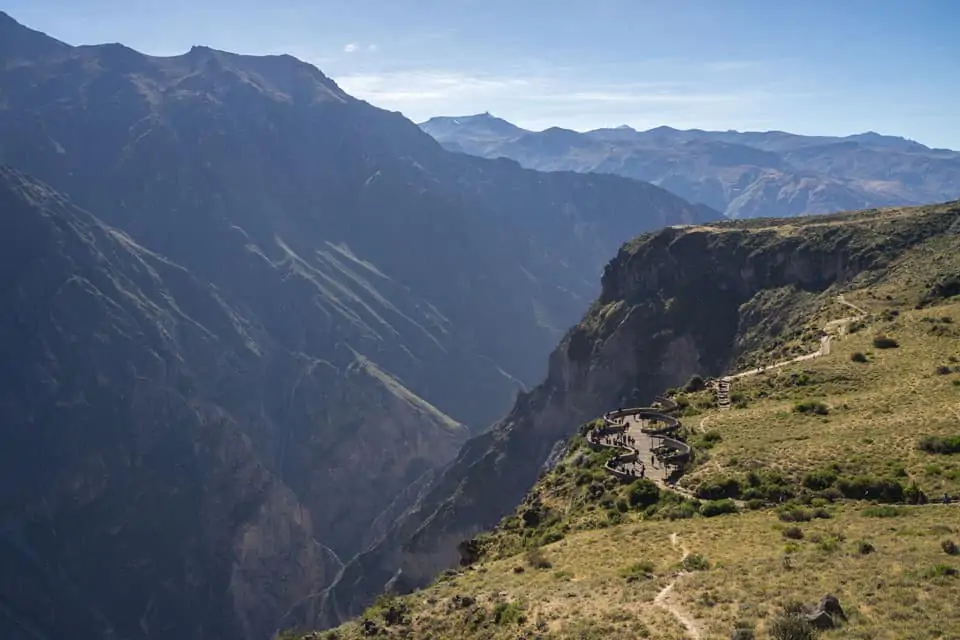
Los Andes Bed & Breakfast is one of the best hostels in Arequipa. Located next to the main plaza (Plaza de Armas), guests can have easy access to the best attractions in Arequipa. The continental breakfast is included. 24-hour reception. The common area is very social to meet other travelers. A great option for backpackers.
Best Luxury Hotel in Arequipa – Katari Hotel At Plaza de Armas
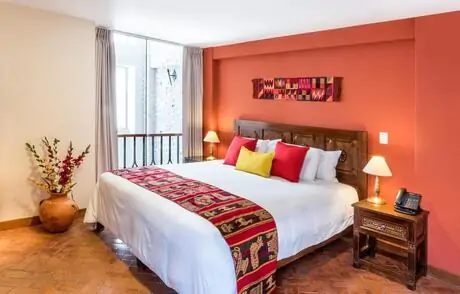
Located in Plaza de Armas right across from the historic cathedral, Katari Hotel is the best place to view the architectural masterpiece. The roof provides a panoramic view of the city that is better than any viewpoint you can find. The rooms are clean, spacious, and well-lit. The breakfast included is phenomenal.
Hiking Colca Canyon FAQs
Can you hike colca canyon without a guide, is the colca canyon hike difficult.
Like this post? Don’t forget to save it on Pinterest!
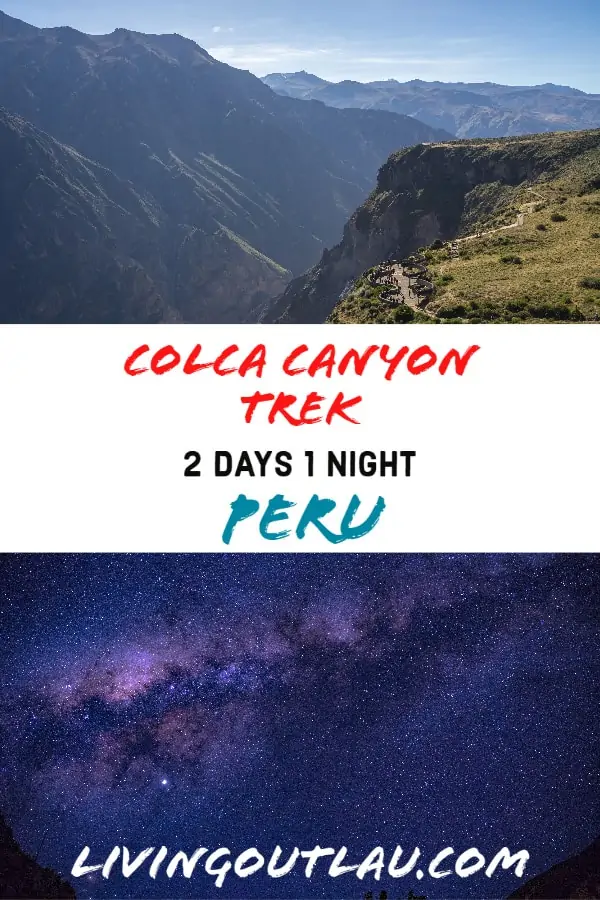
I hope this guide answers all the questions you have about doing the Colca Canyon 2 day trek with a tour company. Colca Canyon was definitely one of the best hikes I have done in Peru. Don’t miss it!
Disclaimer: Some of the links above are affiliate links. That means if you book or make a purchase through the links, we will earn a small commission at no extra cost to you ! The money will help run this site! Thank you !
World Traveler, Travel Blogger, Photographer
LivingOutLau
Sean is the founder of the travel blog, LivingOutLau. He has been to over 30 countries in over 5 years of travel. Every day, he is traveling and sharing his discoveries of the world through exceptional travel guides on his blog!
Leave a Comment Cancel reply
- Why hop with us
- Hop Login Here
- How We Started
- Who Travels with us?
- Why Hop With Us?
- Unique Hop Stops
- Peru Hop vs Public Buses in Peru
- Frequently asked questions
- Guide to Peru
- How It Works
- Tickets & Trips
- Exclusive Hotel/Hostel Discounts
- Group Travel
- Secret Slave Tunnels
- Nazca Lines Viewing Tower
- Paracas National Reserve
- Pisco Vineyard
- Machu Picchu
- Day Trips from Lima
- Day Trips From Cusco
- Day Trips from La Paz
- Paracas Day Trips
- Huacachina Day Tours
- Extra Tours
- Rainbow Mountain
- Ballestas Islands
- Quad Bike ATV
- Paragliding in Paracas
- Buggy and Sandboarding
- Nazca Lines Flight
- Full Day Tour
- Ruta del Sillar Tour
- Lake Titicaca
- 2 Hour Tour
- Isla del Sol
Colca Canyon 3 Day Trek: 2024 Updated information about Colca Canyon 3 Day Trek including itineraries, prices, what to bring and FAQs!
Colca Canyon 3 Day Trek Brief Summary:
- Trek starts at 3am from Arequipa and finishes at 5pm on the 3rd day in Arequipa.
- 3 Day Colca Canyon Trek is of a Medium difficulty level – A decent level of fitness is needed, but it is easier than the 2 Compare all Colca Canyon Tours & Treks and discover which tour or trek is the perfect option for you.
- Treks do include food but it is recommended to bring some extra snacks (fruit, cereal bars etc) with you.
- Colca Canyon Treks include Andean Condor Bird Viewing.
- Most companies pick you up and drop you off at your hotel or hostel.
Colca Canyon 3 Day Trek Guide Contents:
- Tour Itinerary and Prices – Check start time, prices, and more.
- How to get to Colca Canyon – Compare transportation options.
- What to bring? – Be prepared for your tour.
- FAQs – We answer your frequently asked questions.
- Did you know? – Colca Canyon fun facts.
- Photo Gallery – A few of the best photos of the Colca Canyon.
Peru Hop Day Trip!
Voted #1 thing to do in Lima
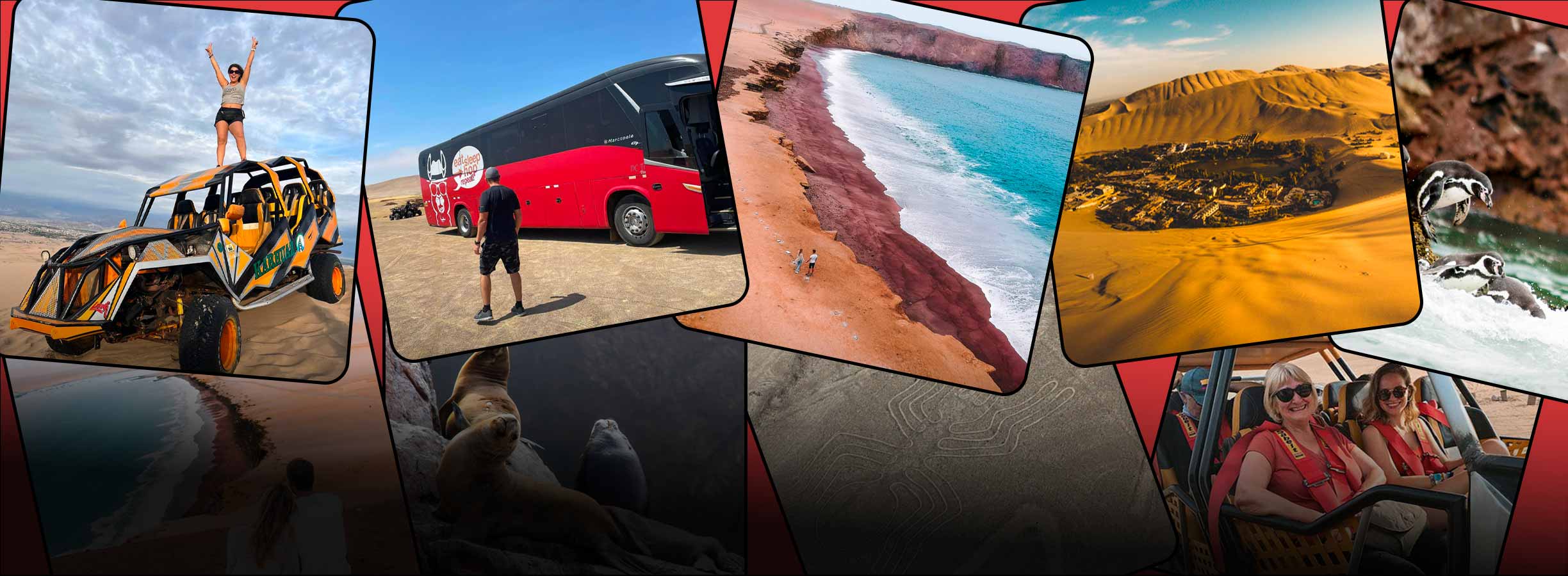
Peru Hop voted #1 thing to do in Lima!
Trek Information
Peru Hop does not operate any tours or treks of the Colca Canyon. To see Peru Hop’s recommended operators for this tour read below.
Colca Canyon 3 Day Trek
Hotel/Hostel Pick-up: Between 03:00am & 03:30am Return Time: Between 17:00pm & 17:30pm (2 days later)
This 3 Day Colca Canyon trek is recommended above the 2 day trek because you have more time to enjoy the views and take pictures. The trail is down hill, flat and uphill. Altitudes range from 1900 to 3300 meters above sea level. Generally very little acclimatization is necessary if you have spent time in Arequipa, Puno, or Cusco.
Detailed Itinerary 3 Day Trek:
Day 1: Arequipa City to Condor’s Cross to San Juan de Chuccho
Pick up from your hotel or hostel between 03:00 am to 03:30 am and depart from Arequipa. After driving 3 1/2 hours, we stop in Chivay to enjoy breakfast. Later, we continue to one of the most popular points of the canyon, “Condor’s Cross,” where we stop for about 40 minutes to watch the Condors fly. We will continue for another 20 minutes by bus, then our trek downhill begins. We trek downhill from 3300 meters above sea level to reach the bottom which will take approximately 3 ½ hours, at an altitude of 2100 meters above sea level. We will have lunch, dinner and stay overnight in San Juan de Chuccho village which has a tropical climate with a lot of vegetation. The accommodation here are basic rooms.
Day 2: San Juan de Chuccho to Malata to Oasis
08:00 am After breakfast, we continue to the town of Cosñirhua to see the production of honey made by the local people and taste the honey. It is possible to see archaeological ruins left by pre-Inca cultures around the area. Going on, we reach the town of Malata and its old Spanish church design. Then, we descend to the deepest part of our trek to Sangalle Village at 1900 metres above sea level.
Dinner and overnight in bungalows.
Day 3: Cabanaconde to Chivay to Arequipa City
05:00 am Trek uphill to Cabanaconde which will take approximately 3 hours. On arrival, we will have breakfast in Cabanaconde and then take our transport to Chivay on the way back to Arequipa. At approximately 12:00 pm, we will arrive to Chivay towards the hot springs.
In Chivay, we will have a typical lunch of the region and then head back to Arequipa. On the way back, we descend from 4830 meters above sea level to 2325 meters above sea level passing through a National Reserve and Pampa Cañahuas, which is a habitat for the four kinds of South American camelids. (Llama, Alpaca, vicuña and guanaco). We return to Arequipa at approximately 17:30 pm.
- Round trip tourist transportation – private bus so your seat is always reserved.
- Meals (3 Breakfast, 2 Lunches, 2 Dinners).
- English speaking trekking guide – local expert who knows everything about the Canyon.
- Two nights in the rustic huts
Not included:
- Entrance ticket to Canyon: S/.70 soles – not included on any tour due to it being illegal to include it.
- Entrance to the Hot Springs: about S/.15 soles – OPTIONAL
- Last lunch in Chivay – Operators will direct you to the tourist buffet restaurants which cost around 30 soles. THIS IS OPTIONAL and you do not have to eat here.
Recommendations:
- The passenger has the obligation to mention any health problem or past injury to assure and guarantee the safety of the trip.
- Tips for the guides are not included.
- Wear warm layers for the early morning transport, as the route to the canyon reaches altitudes of almost 5000 meters above sea level and can have freezing temperatures.
- NOTE: THIS TREK ISN’T EASY, SOME SAY IT’S HARDER THAN MACHU PICCHU’S! For people who get tired during the trek, it is possible to hire mules.
How To Get To Colca Canyon
The Colca Canyon is located about 4-hours outside of the city of Arequipa. The best way to get there is to take a tour or trek which includes transportation to and from Arequipa. If you are looking for information on the best buses to take to Arequipa, visit our passes page . Select your departure city, the countries you want to visit, and amount of time you have to travel. Then browse our passes to see which include your desired stop in Arequipa.
What To Bring?
- Photocopy of passport and immigration card (TAM)
- Light backpack
- 1.5 to 2 litres of water for day 1 (if you need more you can buy it at the small shops at the villages BUT expensive)
- Sun cream (very important)
- Hats, sunglasses
- Trekking shoes or boots
- Waterproof rain jacket
- Warm layers, sweater or jacket (IMPORTANT) –Temperatures reach lows of -10 Celsius
- Shorts or pants for walking
- Swimming suit, sandals, towel – swimming pools in the oasis, and thermal baths in Chivay on the way back to Arequipa!
- Flashlight/ headtorch – Early trek out of the Canyon starts at 5am before sunrise (It is dark!)
- Basics like toilet paper, etc
- Snacks (Breakfast on the last day is AFTER the early morning hike out of the Canyon – bring enough snacks to fuel you up the climb!)
- Insects repellent
- Personal medications (if necessary)
- Hiking sticks (optional)
What is the difference between the Colca Canyon TOURS and TREKS?
During the tours you will have limited walking sections as most of the time you stay on a bus and only get outside at several viewing points. The tours are more recommended for travelers who want (or because of physical conditions) have to take it easy. Treks however, are perfect for people with good physical condition. With treks you will definitely get more and intense views of the beautiful and unique landscape of the Canyon.
What’s the difference between a 2 Day and a 3 Day Trek?
The routes for both tours are the same. The 3-day trek just offers more time to relax and enjoy the canyon. Because of that, the tour is easier than the 2-day trek. But still both treks are not easy!
I do not want to take all of my stuff with me. Where can I leave my big bag?
Hotels and hostels in Arequipa will normally store your bags in their safety deposit for free whilst you are away at the Canyon, until you check-in again upon your return. Head off for the trip with just what you need and leave the rest in storage. Especially for the trek as you will need to carry what you take.
I do not feel well and wish to cancel my trip for tomorrow morning.
Peru Hop does not operate the Colca Tours. The tour provider allows changes up to 17:00pm the day before at no cost. Cancellations or missed tours will be charged the full fee.
I woke up late and missed my tour pick up. Can I change it for tomorrow?
Peru Hop does not operate the Colca Tours. The operators will charge us fully for any NO SHOW or missed departure not previously cancelled before 17:00pm the day before. If you would like to book the tour again for the next day then this is possible but you will have to pay a second time.
Can I rent mules?
Yes, It cost S/.80 soles per day or S/.60 soles during the uphill section on the last day from Sangalle to Cabanaconde.
Will I see Condors on this tour?
There are quite a few Condors out there and as we visit different viewing points the chances are quite good. We still cannot guarantee that you will be able to see them but if you get lucky they will fly just above your head!
Can I have a private room if I travel alone?
Yes, of course, but you will need to pay an extra 40 soles and it is only possible for the second night (not the first night). You need to inform us 24 hours before your tour date.
Is there an upgrade possible in accommodation, instead of a basic hotel?
No, this Colca Canyon provider does not offer alternative accommodation. If you wish to stay in a different hotel or lodge in the Canyon it is recommended you book a private tour of the Canyon.
Did You Know?
- The Colca Canyon is TWICE as deep as the Grand Canyon!
- The area surrounding the Canyon is famed for its traditional and colourful towns which you will pass through along the way.
- In the Canyon you can find over 100 kinds of birds, over 300 types of plants and more than 30 types of cactus.
- The highest point of the Canyon is Ampato at 6388 meters above sea level. These snow-capped peaks form an impressive backdrop to the Canyon.
- The Andean Condor Bird can weigh up to 12 kg with a wingspan of over 3 metres! The CRUZ DE CONDOR viewpoint is famed as the best place in South America to see the Andean Condor in flight.
Photo Gallery
Photo gallery:.
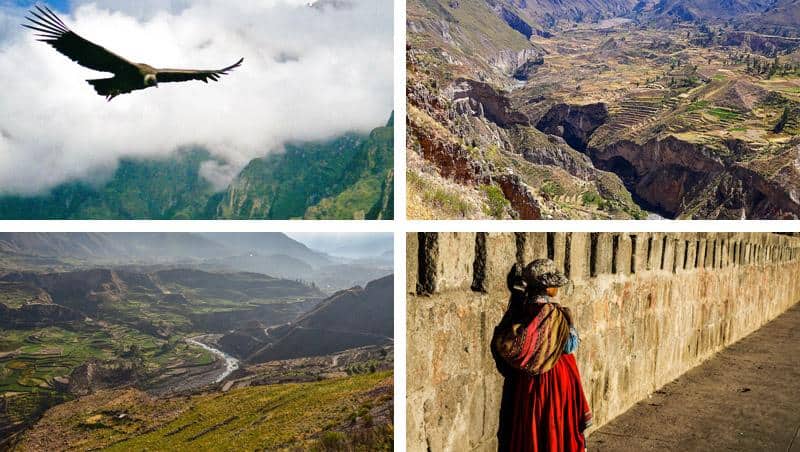
Thank you for your message!
Speak to someone from our team by phone, time info is not avaliable.
- Our Tours |
- Terms and conditions |
- Privacy policy |

Colca Canyon Full Day Tour

Colca Canyon 2 Day Trek

Colca Canyon 3 Day Trek
How it works.

Find one of our awesome tours that you would like to experience in the Colca Canyon, Arequipa.
After booking our team will contact you as soon as possible to tell you the pick up time which wil depend of the location of your accommodation.
Get ready to enjoy the tour, have fun, take awesome pictures and do not forget to share your experience with more traveler on TripAdvisor.
Alternative tours and services

Volcano Bike Tour Arequipa

Food Tour in Arequipa

Airport Transfer in Arequipa
Our gallery.
Juan Alberto R
Aaron Vásquez
Exotic Andean condors can weigh up to 12 kg and are more than 3 meters wide. The Cruz del Condor viewpoint is known as the best place in South America to see Condors.
- Food Tour Cusco
Email: [email protected]
WhatsApp: +51 987 891 317
Address: Calle Santa Catalina 219, Arequipa (visits to the office only by reservation)
© Copyright Trek The Colca 2020 – All rights reserved | Made in Icova

COMMENTS
2 day Colca Canyon trek: If you only have 2 days and you are fit enough, this is an option, but your first day will be very long. Starting at 3 Am and hiking all the way from Cabanaconda down into the canyon through San Juan de Chollo and then the Oasis in a single day. 3 day Colca Canyon trek: This is the best option in my opinion. You do the ...
The Colca Canyon - Cañon de Colca in Spanish - offers travellers the opportunity to get up close and personal to countryside life in Peru, spot soaring Andean condors, bathe in secret thermal baths, uncover jaw-dropping vistas, stay in an oasis, and hike along dusty roads for two or three days into the depths of one of the world's deepest canyons.
Move over the Grand Canyon: there's a much more impressive canyon in town. Peru's Colca Canyon is the world's second deepest, measuring in at around 3,400m at its deepest point - twice as deep as the Grand Canyon. Epic it most certainly is, and a hike into the depths of this colossal fissure is a fascinating - and physically ...
Colca Canyon Trek 3 Days: Popular Route. Recommended for an extended stay in Colca Canyon. Route: Cabanaconde > San Juan de Chuccho > Sangalle Oasis > Cabanaconde Overnight: San Juan de Chuccho (night 1), Sangalle (night 2) Distance: about 12 mi (20 km) total. Set out on a trekking loop into the eastern part of Colca Canyon and spend the night ...
Colca Canyon Trek, Peru - A Complete Guide [2024] Covid-Related Travel Update Jan 2024 - Peru is now open to international travelers. And as per Supreme Decree 130-2022-PCM in Peru's official gazette El Peruano, Covid entry requirements and all other regulations and restrictions were lifted from November 2022.
This particular 3-day trek through the Colca Canyon is probably the most popular route. It is around 20 km (12.5 mi) overall, with a total elevation gain of just over 1,600m (5,292 ft). On your first day you would hike from Cabanaconde to San Juan de Chuccho and spend the night there.
Colca Canyon Cost. In total our independent 5 day Colca Canyon trek, for 2 people, minus beers (which are of course optional) cost us 556 soles (or 278 soles per person). That's about $80 USD or £63 each. Here's a complete Colca Canyon cost breakdown: Colca Canyon hiking permit which lasts 5 days = 70 soles each.
To book the 2 day Colca Canyon tour with Arequipa Tour - Operator Peru, simply contact them on Whatsapp (+51 519 596 88125). Otherwise, drop into their office in Arequipa ( Calle Jerusalén 311A, Segundo Piso, Office #6) to find out more information. Also, feel free to check them out on Facebook and Instagram.
About 150km away from Arequipa near the small town of Chivay, the Colca Canyon is a popular day trip from the beautiful city of Arequipa in Peru. Arequipa has a number of fun things to do but without a doubt, the most popular is to hike the Colca Canyon. In fact, the Colca Canyon is Peru's third most visited destination with over 150,000 ...
25 min. Jun 18, 2024. 0. In south of Peru, about 160 kilometers northwest of the city of Arequipa, lies the Colca Canyon - one of the deepest canyons in the world. It reaches a depth of unbelievable 3,400 meters (11,155 feet) and is almost twice as deep as the Great Canyon in the USA. The Colca Canyon is also one of the best places in Peru to ...
Colca Cañon Trek. Enjoy this 14.4-mile loop trail near Tapay, Arequipa. Generally considered a challenging route, it takes an average of 9 h 57 min to complete. This is a popular trail for backpacking, birding, and camping, but you can still enjoy some solitude during quieter times of day.
Some people choose to go on their own, thinking it saves money. But the truth is, the two-day guided Colca Canyon trek costs about $72, and it includes 2 breakfasts, 1 lunch, 1 dinner, and a stay in the Oasis de Sangalle. Doing the trek by yourself won't likely be much cheaper than a guided tour.
Colca Canyon hike day 1. The trek for the first half of day 1 is mostly descent into the Canyon which starts at 3287 metres above sea level. To put this into perspective, the peak of the highest mountain in Great Britain (Ben Nevis) is only 1345. The landscape swallows you up and the blue, green and orange tones of the canyon are striking.
Day 2 Llahuar - San Juan de Chuccho. Day 3 San Juan de Chuccho - Cabanaconde. Distance: 30km total trail distance. Time: 3 days (total hiking time incl. small breaks: 10 hours) Difficulty: moderate; but exposed to the weather and steep altitude gain on day 3, from 2395m at the bottom of the canyon to the rim at 3430m.
Colca Canyon Multi-Day Trek. Experience this 19.6-mile loop trail near Tapay, Arequipa. Generally considered a challenging route, it takes an average of 12 h 49 min to complete. This is a popular trail for backpacking, birding, and camping, but you can still enjoy some solitude during quieter times of day.
Colca Canyon 2 Day Trek. Detailed Itinerary 2 Day Trek: Day 1: Arequipa City to Chivay to Condor's cross to Sangalle. Between 03:00 am and 03:30 am, we depart to Cabanaconde in the Colca Canyon, which is about a 6 hour drive from Arequipa. On the way we stop for breakfast and later we continue to La Cruz del Condor which is the best place to ...
Day 2 of Colca Canyon Trek, Uphill to Cabanaconde. At 4:30 AM, we started our hike toward Cabanaconde. Day 1 was all descending, so logically day 2 was all uphill. Sangalle is located at 2,100m above sea level while Cabanaconde is located at 3287m above sea level. In 3-4 hours, we ascended more than 1100 m.
Itinerary. Day 1: Arequipa City to Chivay to Condor's cross to Sangalle, between 03:00 & 03:30 hrs, we depart to Cabanaconde in the Colca Canyon, which is about a 6 hour drive from Arequipa. On the way we stop for breakfast and then continue to the Condor's cross which is the best place to watch the Canyon and the famous Andean Condor.
The Colca Canyon, in the region of Arequipa, has the reputation of being one of the deepest canyons in the world. It is also very well known thanks to the fact that it is a privileged place to observe the flight of condors. The trail that starts from San Juan de Cuccho and goes up to Cabanaconde is usually the last part of the most complete tour of the Colca Canyon. You will cross the Colca ...
Colca Canyon 3 Day Trek Brief Summary: Trek starts at 3am from Arequipa and finishes at 5pm on the 3rd day in Arequipa. 3 Day Colca Canyon Trek is of a Medium difficulty level - A decent level of fitness is needed, but it is easier than the 2 Compare all Colca Canyon Tours & Treks and discover which tour or trek is the perfect option for you.; Treks do include food but it is recommended to ...
A full day tour. This tour started at 3 am, the sunrise was incredible. The Colca Canyon is one of the deepest canyons in the world and the view is incredible. We saw a bunch of condors flying on the condor's cross. We were there around 9 am and spent an hour walking and taking photos.
The Colca Canyon, in the region of Arequipa, has the reputation of being one of the deepest canyons in the world. It is also very well known thanks to the fact that it is a privileged place to observe the flight of condors. The trail that starts from Cabanaconde and descends to Llahuar is usually the first part of the most complete tour of the Colca Canyon. Llahuar is located on the banks of ...
The Colca Canyon is a canyon of the Colca River in southern Peru, located about 160 kilometres (99 mi) northwest of Arequipa.With a depth of about 1000 - 2000 m (3300 - 6600 ft) (whereas bottom is at cca 2000 m and edges are at 3000 - 4000 metres above the sea level), it is one of the deepest canyons in the world. Its length is about 70 kilometres (43 mi).